The Ultimate Guide To Visiting The Cameron Highlands: Malaysia's most popular mountain retreat
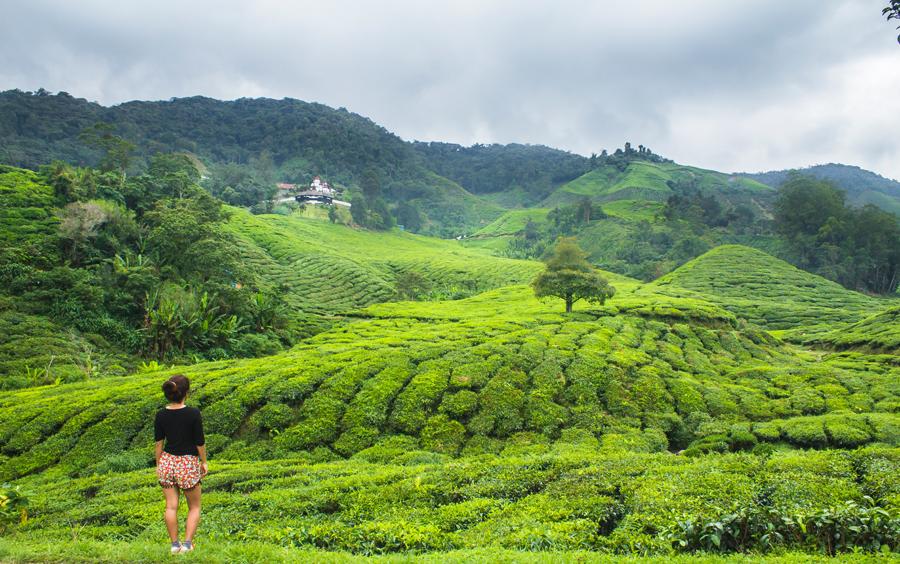
Watch video:
There we were, sat terrified in the two-seater, holding on for dear life as the air-conditioned bus hurtled along the winding mountain road at breakneck speed.
The bus driver seemed to be hell-bent on ending both his own life and the lives of all the other passengers on board, as he repeatedly overtook other cars and motorcyclists while swerving around blind corners and hairpin bends.
We were fast ascending the winding mountain road, heading towards the Cameron Highlands, an upland region in Malaysia that’s renowned for its refreshingly cool climate and picturesque tea estates.
Before we had reached our destination, it began pouring rain and the bus windows began to dance with thousands of moving water droplets. This was an early warning sign of the type of weather that we could expect to experience during our stay.
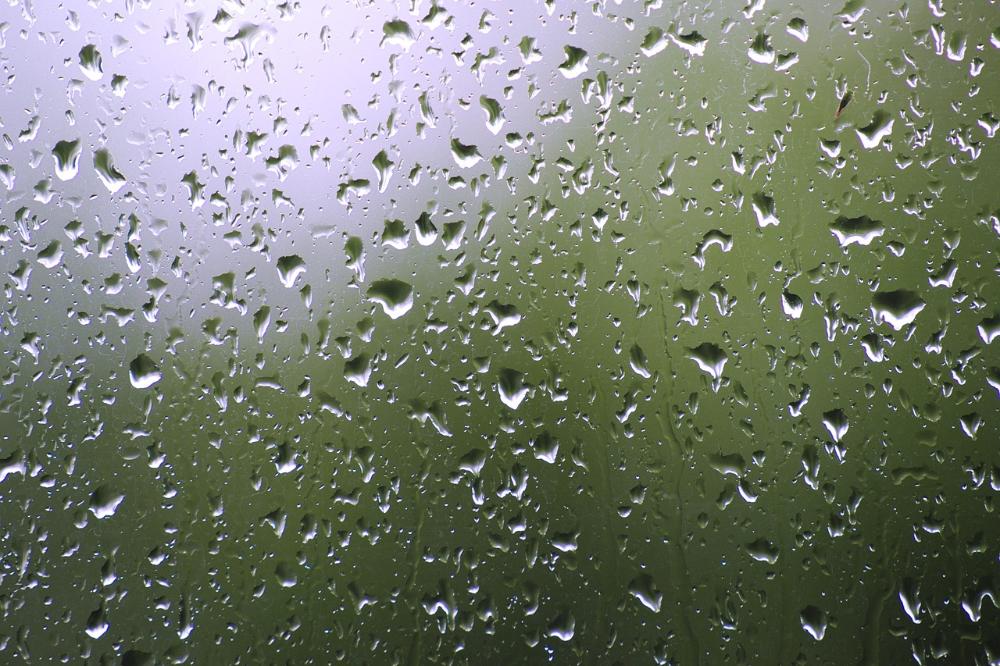
No time to read it now? Get this massive 20,000+ word insider's travel guide as a downloadable PDF to read later.
Fortune must have favoured us that day however, as we never did meet our demise by colliding with an oncoming vehicle or careering over a precipice into an abyss.
Other tourists weren’t so lucky here in December 2010, when 27 of them were killed in a bus collision with a rock face, an event that has been described as one of the worst road accidents in Malaysian history.
Thankful that we had made it to the highlands in one piece, we stepped down from the bus at the bus terminal in Tanah Rata, the principal town in the region, eager to start experiencing all that it had to offer.
Our first task however was to find budget accommodation and that wasn’t going to be so easy, seeing as we had arrived during the Chinese New Year festivities in February and the demand for rooms was sky-high.

Location
The Cameron Highlands region is found in the northwestern tip of Malaysia's Pahang state and the region covers a total area of about 712 square kilometres.
The closest major city to the region is Ipoh (90 km away), while Kuala Lumpur and Penang are about 200 km and 240 km away respectively.
The Cameron highlands are part of the Titiwangsa mountain range, which divides peninsular Malaysia and the southernmost part of Thailand into east and west regions.
Getting there
Because the bus transport system in Malaysia is well-developed, affordable, air-conditioned and reliable, most budget travellers come to the Cameron Highlands by bus, despite the small risk involved with the sometimes reckless drivers.
By bus:
We took a bus from the Pekeliling bus terminal in Kuala Lumpur to Tanah Rata for about 35 RM. There are several ticket selling booths at the bus terminal so just ask a local to point you towards the correct one. The journey takes around 4-5 hours.
You can get to the Pekeliling bus terminal by taking the monorail line from KL Sentral to Titiwangsa station and then walking a short distance from there to the terminal.
According to wikitravel, express buses to the Cameron Highlands also leave from the Pudu Sentral Bus Station in KL, but mostly in the morning with a more limited schedule thereafter.
Buses are also available from several other towns including Ipoh to the west (head to the Amanajaya bus terminal) and Gua Musang and Kuala Besut to the east.
By car:
If you’re driving to the Cameron Highlands from Kuala Lumpur there are two possible routes that you could take.
- You can head north along the north-south expressway and then turn off it at Tapah onto route 56, continuing straight on from there to the highlands
- You can exit the expressway at Simpang Pulai onto route 185, continuing on all the way to the junction at Blue Valley. At the junction you need to turn south onto route 56, first passing through Kampung Raja and then arriving in Brinchang.
The latter route is in significantly better condition than the former so it may be faster, even it does seem a little less direct.
If you need more detailed information on getting to the Cameron Highlands you might want to take a look at this guide by Wikitravel.
When to visit
The most important consideration when deciding when to visit the Cameron Highlands is rainfall, since temperatures in this tropical highland climate are pretty consistent year-round with a mean average temperature of 18°C.
Day time temperatures average 23°C, while the mercury can often drop below 16°C at night, although the region never experiences frosts.
As regards rainfall levels, the highlands receive more than 2,700 mm of rainfall throughout the year, which is a pretty respectable amount.
There are no distinct dry or wet seasons but the rainfall levels do vary a little from month-to-month according to the climate data that we reviewed.
The wettest months are October and November while the driest are January and February. June and July are also drier than most other months so they would also be a good choice if you can’t make it in January or February.
But if you like the rain…. then feel free to visit at any time.
Where to stay
The Cameron Highlands region encompasses the three townships of Ringlet (1,100 m), Tanah Rata (1,400 m) and Brinchang (1,450 m) and five smaller settlements of Bertam Valley, Kea Farm, Tringkap, Kuala Terla and Kampung Raja.
Of the three townships, Tanah Rata and Brinchang are both pretty sizeable, Ringlet not so much. Ringlet is the southernmost township and the first one that you pass through if entering the highlands from the south.
We recommend that you stay in Tanah Rata, the administrative centre of the highlands. Here you’ll find many banks, ATMs, restaurants, shops, hotels, guesthouses and other amenities you may require.
The town even has a Starbucks on the main street. The main bus station for the highlands, the Tanah Rata bus terminal, is also found here.
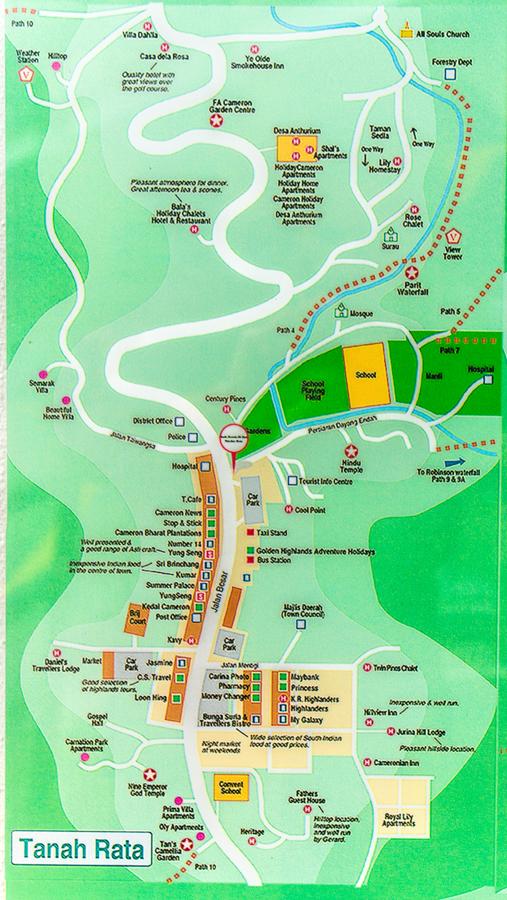
As for the accommodation situation in Tanah Rata, there are plenty of guesthouses to choose from, although it can be difficult to find ultra low-budget accommodation.
We advise that you book online ahead of time if you’re coming at the weekend and especially if you’re coming during a holiday or festival period. Here is a list of national public holidays in Malaysia that you can refer to when planning your trip.
We arrived during the Chinese New Year festivities in mid-February and room prices in the town had skyrocketed due to a sudden influx of domestic tourists and 35-40 RM per night for a double room was the absolute lowest price we could find for a room for two people during that period.
As for which guesthouse to choose, a popular option with low budget travellers is Twin Pines Guesthouse, located a few hundred metres beyond the Maybank on Jalan Mentigi Utama.
Here we paid 35 MYR per night for a very small room on the second floor, which had a two-person mattress on the floor. The tiny room actually turned out to be a blessing in disguise as the low nighttime temperatures of the highlands make a cosy little room much better for keeping warm at night.
The owners of Twin Pines also have another guesthouse just nearby called KRS Pines, which is more a bit more expensive but might be preferred by those on a more flexible budget.
If these guesthouses don’t suit you, there are several more budget options that you can investigate just a couple of hundred metres away from these.
They’re all found at the block of buildings on the right hand side when you first turn down Jalan Mentigi Utama from the main road. There are budget lodging options on the two main faces of this building block. Most require you to first climb up a long flight of stairs in order to reach the reception. (typical of hostels and budget guesthouses in Malaysia).
If for some reason you decide to stay in Brinchang, maybe because you like the fact that it has a KFC or its proximity to certain attractions, we have also prepared a map of this town for you as well. Here it is:

.jpg)
Where and what to eat
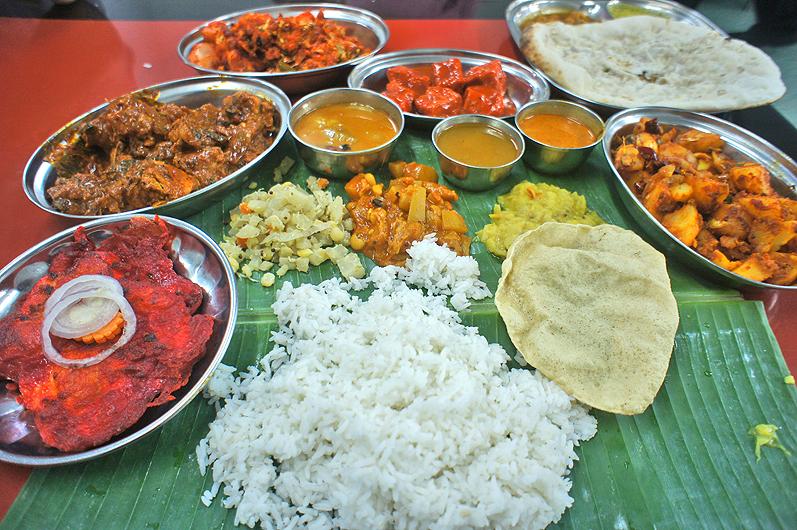
There are plenty of Indian and Malay restaurants in the Cameron Highlands and there’s even a KFC right next to the main street in Brinchang.
The Indian restaurants tend to be more popular with foreign tourists while the Malay ones seem to be fashionable with the local hijab-wearing Muslim women.
The best restaurants that we found were Restoran Sri Brinchang and Restoran Kumar and both were located on the main street of Tanah rata, towards the east end of town.
These two Indian restaurants are literally side-by-side and are in fierce competition with each other, so prices for both are very affordable and the quality is kept quite high.
We found Restoran Sri Brinchang to be the slightly better value of the two and the food was really delicious, so we never really looked any further for a place to eat during the entire course of our stay.
At Sri Brinchang you can order naan, roti, dosa, tandoori chicken, claypot specialties and other delicious Indian food. Most western tourists seem to love the South Indian Thali set, served on a banana leaf with rice, crackers, chickpeas and various other vegetables. You can even have it accompanied by a meat curry dish and a bowl of curry sauce to pour over the rice.
The milk tea or teh served here was also fantastic and highly addictive. Also make sure to try teh tarik, literally meaning “pulled tea”, which is prepared by adding sweetened condensed milk to black tea and then pouring the liquid back and forth between two containers, gradually increasing the height from which the liquid is poured. The process creates a creamy, frothy beverage that tastes like no other.
Another Indian restaurant in Tanah Rata that's supposed to be quite good and even cheaper than the two already mentioned is Restoran Bunga Suria. We didn't eat here but It's found at the west end of the town just in from the main road.
The Cameron Highlands regional specialty is the charcoalsteamboat and there are several restaurants offering it in Brinchang and one or two places in Tanah Rata where you can order it as well.
What makes it special is the fact that the bubbling broth is cooked over a charcoal fire; in the lowlands these steamboats are also served in many restaurants but they're heated electrically.
How the steamboat works is you first choose a soup base (chicken, herbal, spicy, tom yam etc.) and the restaurant gets the steamboat up and running - a cauldron of bubbling broth heated over glowing hot coals and placed in the middle of the dining table.
The steamboat is no ordinary pot however, as it comes with a long integrated chimney in the middle so that all the smoke is carried upwards and away as the pot sits on top of the charcoal stove. Flames sometimes leap out the top of the chimney, adding to the drama.
Once the steamboat is bubbling away furiously, various foods start arriving at the table with the idea being that you throw them all into the bubbling cauldron. Pork, chicken, fish balls, seafood, eggs, tofu, mushrooms, noodles, vegetables…. it all gets tossed into the broth, although items that require less cooking time are best thrown in at the end.
Once the meal is prepared, a ladle or pair of chopsticks can be used to fish out the goodies hiding deep within the steaming broth - an essential part of the overall experience.
The steamboat is, in essence, a self-service meal where a group of friends or relatives can dine together in a convivial, communal fashion and also be active participants in the preparation process, having full control over how the food is cooked.
How to get around
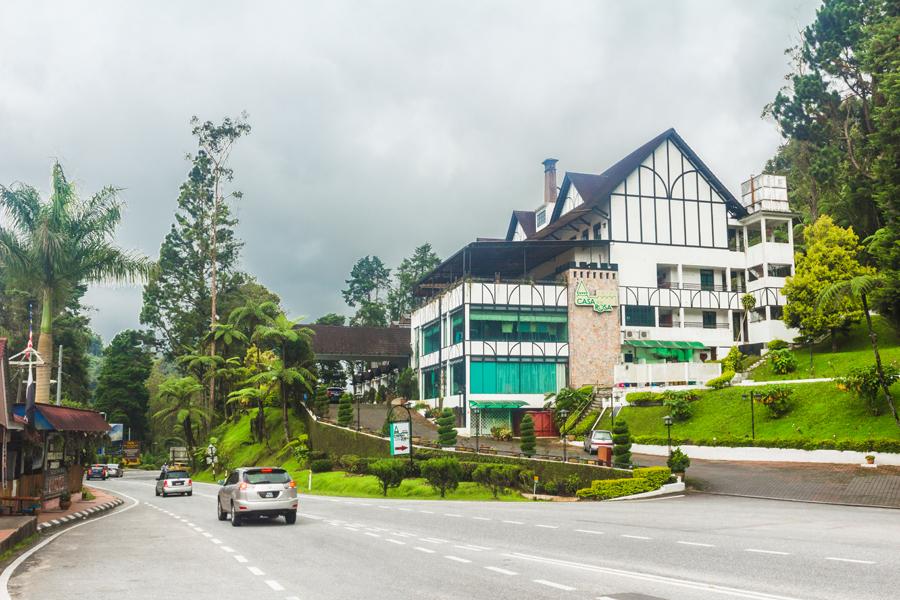
Walk - The Cameron highlands is a place to stretch the legs a bit, enjoy the cool, fresh air, smell the roses and get some exercise. You'll probably find that you'll have to do at least a little walking to get around, even if you don't really want to.
Rent a motorcycle - It is possible to rent motorcycles in Tanah Rata but it’s surprisingly expensive to do so, with most companies asking anywhere between 30-50 RM per day. This is about double what you’d pay in most other countries.
Moreover, most outfits were also very strict here about travellers having to possess an international driving license. No license, no possibility of renting a bike. Conditions were more relaxed in Penang, where we were able to rent a bike more cheaply and without having to provide a license.
Taxis - These are another option for getting around, but generally not the cheapest option. However if you can split the cost with several people, they work out to be pretty affordable. The fare between Tanah Rata and Brinchang is normally around 6 RM.
In Brinchang taxis tend to wait around the main bus stop on the main street next to the carpark. In Tanah Rata you can find taxis at the Tanah Rata bus terminal. In both towns you can also flag them down while standing at the side of the street.
Public bus – This was the option we used the most frequently, which leaves hourly on the half hour from the main bus terminal in Tanah Rata and can take you to Brinchang and beyond all the way to Tringkap. It’s a minibus with a small capacity because it doesn’t usually pick up too many passengers.
The bus also plies the same route in reverse on the same hourly schedule. The last bus back from Brinchang is at 7:30 p.m but you can’t always rely on it to come. The fare between Tanah Rata and Brinchang is 2RM and more if you’re going further.
Hitchhiking – On more than one occasion we successfully managed to hitchhike in the Cameron Highlands when we ended up stranded in the middle of nowhere.
Hitchhiking is a bit easier on the quieter back roads but we also eventually managed to flag down a vehicle occupied by two Chinese ladies on the main highway (route 59) after a considerable number of rejections.
Join an organized tour – If you join an organized tour you won’t have to worry about getting around independently as the operator will have a 4 x 4 or a van to ferry you around to all of the different attractions. Of course, you’ll pay a price for this convenience.
The layout
The following map provides a good overview of the Cameron Highlands. We recommend that you download this image and use it as a resource for helping you locate all of the different farms, hiking trails, tea gardens and other attractions in the region.
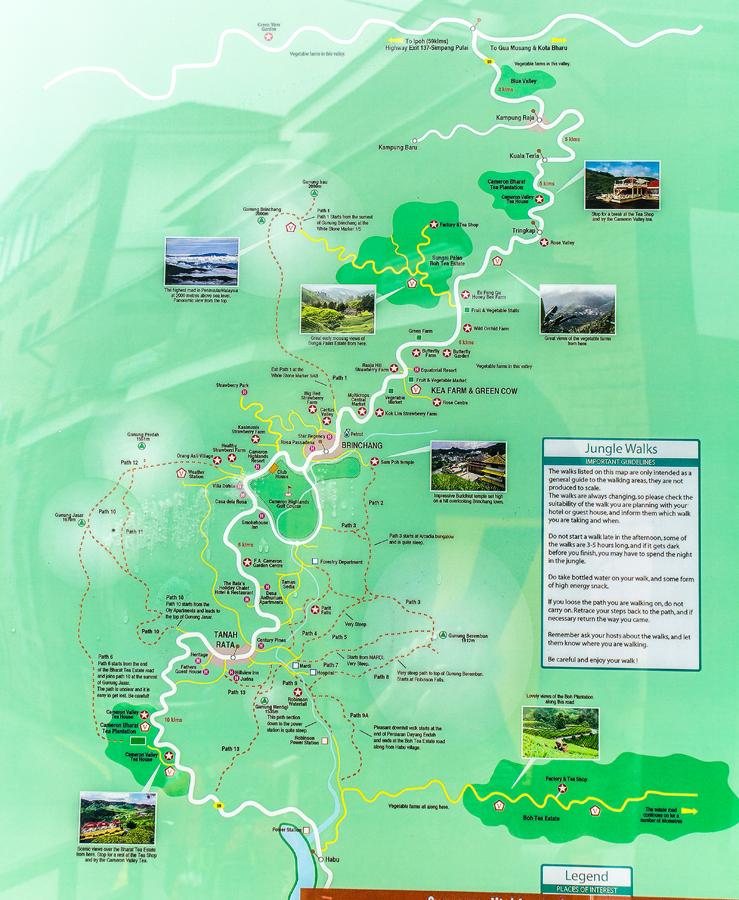
A brief history of the highlands
The original inhabitants of the Cameron Highlands region were the orang asli (native people), who hunted small game like birds, squirrels and monkeys in the forests with blowpipes and are still present in the region today.
To prepare the poison for their blowpipe darts, the orang asli would first collect a quantity of toxic latex that oozed from the native Ipoh tree (Antiaris toxicaria). This would then be heated very gently over a fire inside a leaf bowl, for a period lasting several days, until the poison was highly concentrated.
The blowpipe darts would then be dipped and coated in the deadly poison, which is known to contain beta-antiarin, an extremely potent cardiac glycoside steroid, which causes death by heart failure once it enters the bloodstream.
These days however, the orang asli are being rapidly assimilated into the Malaysian monster of development. Most of them now live in modern houses and instead of loincloths wear jeans, t-shirts and baseball caps.
The name of the region, the "Cameron" highlands is a tribute to the work of the British surveyor Sir William Cameron, who in 1885 was commissioned by the then colonial Government to map out the area near the Pahang-Perak border.
Cameron described the area as a highland plateau, a relatively flat area with gentle slopes that was surrounded by lofty mountains.
Over the following decades, several British colonial administrators, desperate for a respite from the oppressive heat and humidity of the lowlands, expressed interest in developing the region into a hill station.
However, it wasn’t until 1925 that an experimental agricultural station was established to determine if the climate was suitable for growing tea, coffee, cinchona, fruits and vegetables.
Once it was confirmed that these commodities could be grown, work began on a road that would give the British access to the highlands from Tapah to the southwest.
The project took almost three years to complete (Jan 1928 – Nov 1930) and about 375 workers were hospitalized for malaria over its course as they hacked a route through the thick mosquito-infested jungle.
In 1929, before the road was fully completed, a Brit called John Russell established the Boh tea estate with the help of a few labourers, a few mules and a steamroller, planting tea bushes that had been imported from Sri Lanka.
Once the road was opened in 1931 many more British settlers, labourers and vegetable growers began moving in.
By the mid 1930s a respectable settlement had been established, complete with a six-hole golf course, a police post, a military camp, numerous cottages, three inns, tea plantations, vegetable farms, nurseries, a dairy, a horse ranch, a Government Rest House and an Agricultural Experiment Station.
The Cameron highlands today (at a glance)
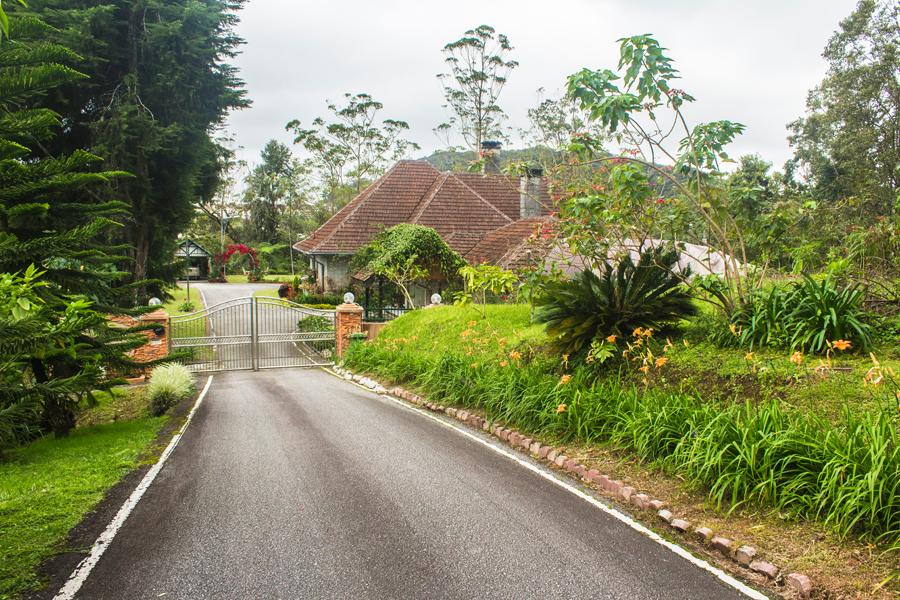
Today, many of the original elements possessed by the Cameron Highlands are still present and the region has managed to retain much of its charm from the colonial era.
The golf course is now an 18-holer with a clubhouse and you can still find plenty of charming old colonial inns and residences built in the Tudor architectural style.
Built just next to the golf course, Ye Olde Smokehouse is a famous Tudor-style hotel and restaurant dating back to 1939.

With its leaded windows, four-poster beds and wooden beams, the hotel allows guests to feel like they’re staying at an old hotel in the English countryside. Guests can order full English breakfasts, good tea and scones with whipped cream and strawberry jam.
The hotel is surrounded by beautiful gardens and there’s even a quintessential red London telephone box and a pillory found just outside the entrance to conjure up that traditional English vibe.
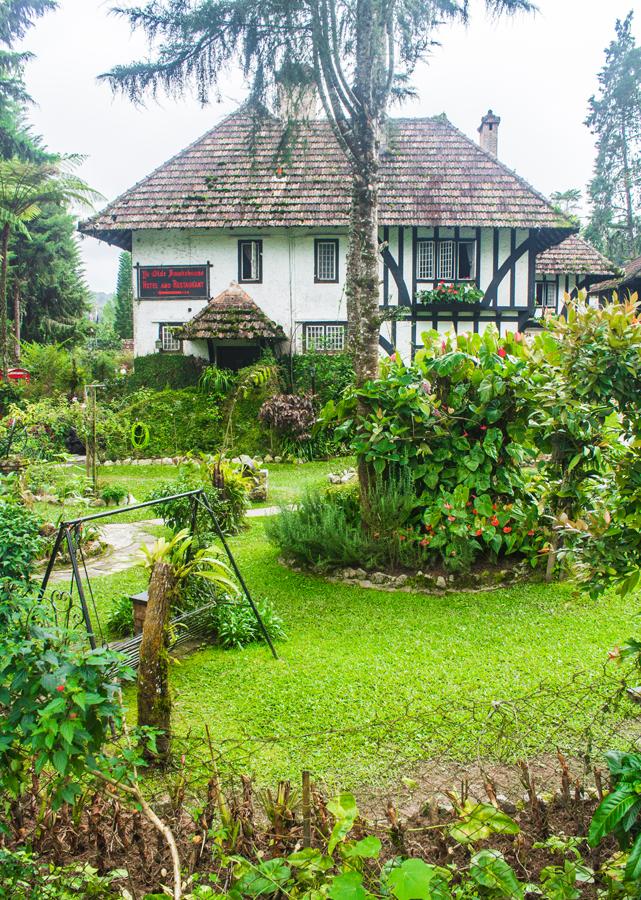
Back in the middle ages and even up until the mid 19th-century in England, those who committed certain offences, such as perjury, were put in the pillory to be publically humiliated and possibly physically abused by the crowd that gathered to watch.
The time spent in the pillory was usually no longer than a few hours but during that time the victim might be pelted with food waste, faeces, dead animals, mud and other disgusting substances.
Occasionally crowds would become violent and pelt the victim with rocks, bricks and other dangerous objects, often causing death. Heros however might be pelted with flowers if they had won the crowd's favour.
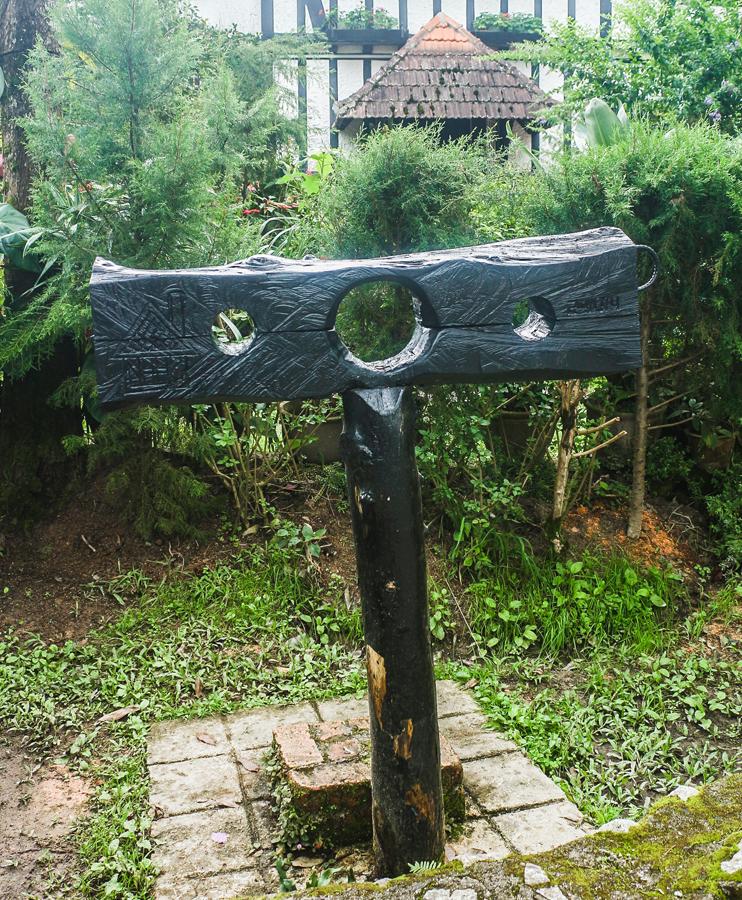
The Cameron highlands of today is also well known for its agricultural output; sprinkled throughout the region are dozens of vegetable farms, strawberry farms, blueberry farms, butterfly farms, apiaries (bee farms), cactus nurseries and flower nurseries, some of which specialize in growing orchids or roses.
The vegetable farms grow some twenty-five types of mid-latitude vegetables including eggplants, Chinese cabbages, English cabbages, bell peppers, tomatoes, lettuces, mint, watercress, celery, spinach and many others. All of the vegetables seeds are imported from Japan.
A large amount of chicken dung is used as a fertilizer and there are also reports of highly toxic, locally and internationally banned pesticides being used by farmers. Most of the produce is exported to the large Malaysian cities and to Singapore (25-30%).
.jpg)

Picturesque tea estates still decorate the landscape, displaying their vast swathes of emerald green tea bushes that are sculpted into mesmerizing mosaic patterns by the walkways that divide them up.
Temples (South Indian Hindu, Chinese Buddhist, Sikh Gurdwara, Methodist churches etc.) can be found in most of the towns, although the highlands are not renowned as a place for stunning temples. We’ve dedicated a section of the guide to the two most important temples in the region.
There is still plenty of reasonably pristine jungle forest within walking distance from most of the main towns in the Cameron Highlands, with many designated trails and hikes to local mountain peaks, waterfalls, viewpoints and aboriginal villages.
The mysterious disappearance of Jim Thompson
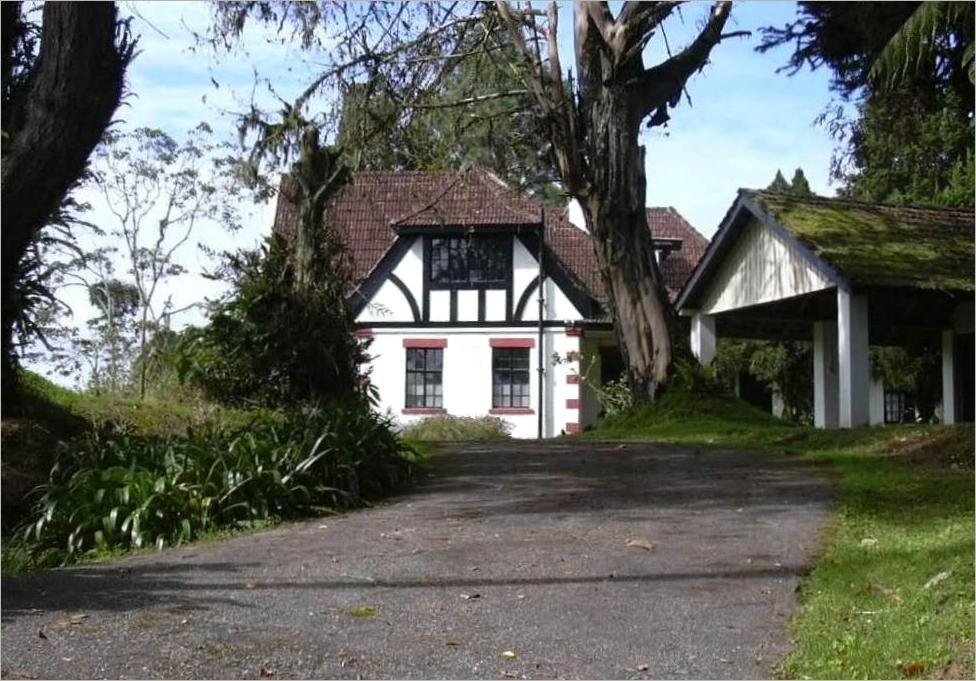
Perhaps the most intriguing story connected with the Cameron Highlands, is the one concerning the mysterious disappearance of famous silk entrepreneur Jim Thompson, founder of the world renowned Thai Silk Company.
One fine Sunday afternoon in March 1967, Thompson left his residence (then called the “Moonlight” bungalow) for a leisurely stroll… and never returned.
What exactly happened to Jim Thompson that day is still an unsolved mystery and the cause of much speculation. He is said to have disappeared without a trace.
Was he killed and eaten by the native aboriginals? Did he lose his footing and fall down into a deep ravine? Was he accidentally killed an animal trap set by the native jungle dwellers and then subsequently buried when they found his carcass? Maybe he simply got lost in the vast jungle and couldn’t find his way back to civilization?
Many people believe that all of these suggestions are highly implausible. Jim was an experienced jungle trekker and ex-soldier with extensive in-field training. That a leisurely day hike in the jungle could have led to his demise is a ridiculous suggestion for some.
Following his disappearance, a massive search and rescue effort involving over 500 participants was launched. The search officially lasted for 11 days but continued sporadically for weeks afterwards. No body or evidence was ever found though.
Bloodhound sniffer dogs were unable to find any scent trail leading down the only access road from Jim’s residence to the main road, nor could they detect any scent trail leading into the jungle from the access road. This evidence would suggest that Thompson left the residence by car, which would have broken the scent trail.
So was Thompson kidnapped and murdered? Possibly. Thompson’s enemies are said to have been legion and he was unpopular with both the American and the Thai Governments.
Jim had an amazing collection of rare antiques and Thai art, which made many people resentful of him. His Thai silk business was also very successful and it’s possible that rival business owners wanted to take him out.
.jpg)
Another possibility is that he vanished of his own volition, with the intention of reinventing himself and his life somewhere else. But who really knows.... it's possible that his bones are still somewhere out there, widely scattered about the vast tracts of uncharted highland forest.
The highland ecosystem
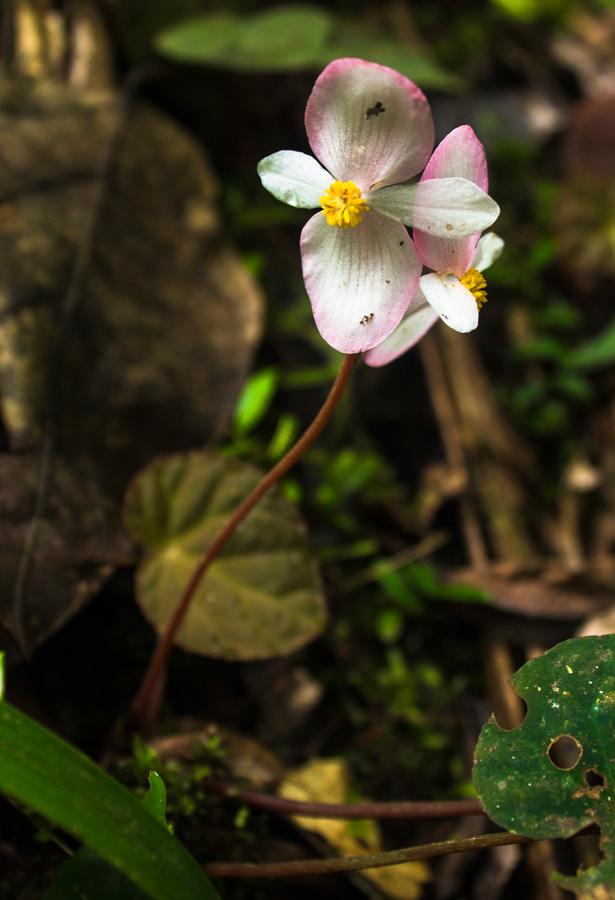
The highland ecosystem of the Cameron highlands is very unique in Malaysia, consisting of lower montane forest, and further classified as oak-laurel forest, since it consists predominantly of small trees from the families fagaceae (oak & beech family) and lauraceae (laurel family).
These oak-laurel forests are found at elevations between 1200 m to 1,500 m and are associated with peaty, waterlogged soils, which form due to the high rainfall levels and the slower rates of decomposition of plant matter in the highlands. The slightly acidic soils are ideal for growing crops like tea, fruits and vegetables.
The understory in these oak-laurel forests is quite luxuriant due to the relatively high amount of light penetrating through the relatively low canopy. Cyathea tree ferns, epiphytes (ferns & orchids), lichens, mosses, climbers, palms and herbs grow in profusion.

Once you go above 1,500 m in elevation, you enter into a new forest zone, known as the upper montane forest, cloud forest or “mossy forest”. In this type, the most important tree families are Coniferae, Ericaceae and Myrtaceae.
When entering into this zone, the forest’s character noticeably changes and vibrantly coloured mosses, lichens, ferns and other epiphytes can be seen in even greater profusion. Rhododendrons, magnolias and other interesting species can also be found in these forests.
Rare pitcher plants (nepenthes sp.) even occur in the mossy forest habitat and botanists or collectors even go hunting for them. In fact, Malaysia as a country is the centre of biodiversity for the nepenthes genus of pitcher plants.
As regards the floral diversity of the Cameron Highlands, there are said to be over 700 plant species growing in the region and 145 of those are endemic with 60% being species that only occur in the highlands. Gunung Brinchang is one of the better places to go hunting for endemic species.
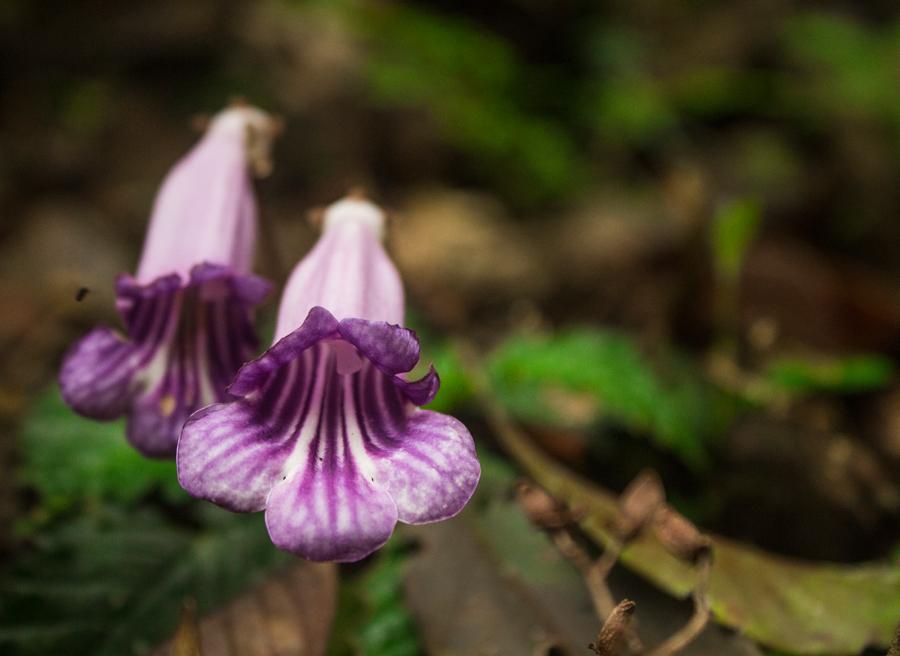
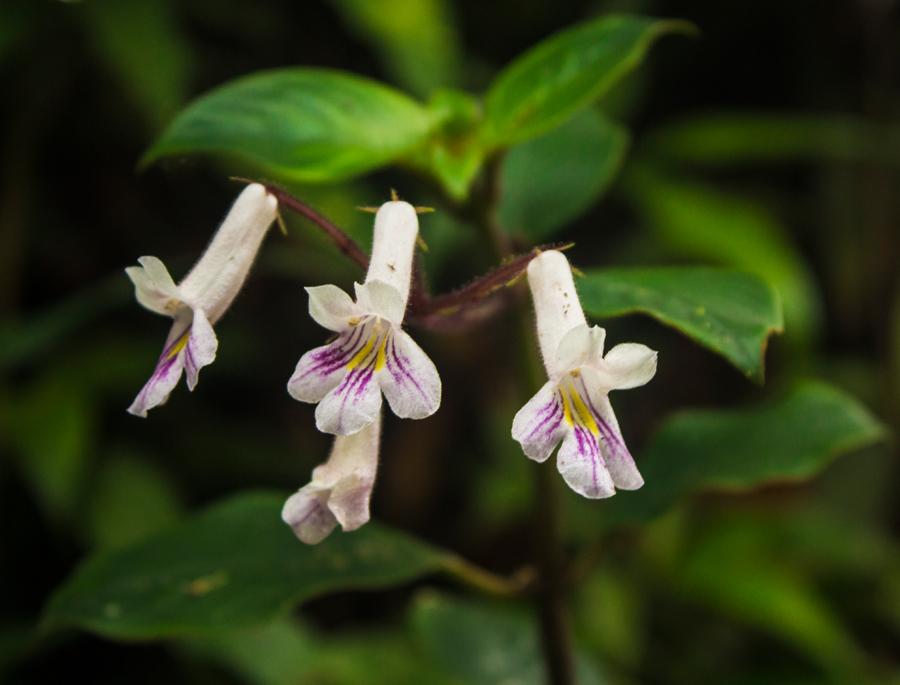
Many rare and exquisite orchids, such as the Jewel orchid (Anoechtochilus albolineatus), can be found in the forests if you know exactly where and when to look (but you shouldn't pick any).
Of the 145 endemic plant species in the region, 32 of these are said to be orchids. Quite a number of the highland orchid species, aside from being rare and beautiful, also have medicinal value to mankind.
The most commonly encountered orchid in the highlands, often found by the roadside, is the bamboo orchid (Arundina graminifolia). It's a beautiful little flower.
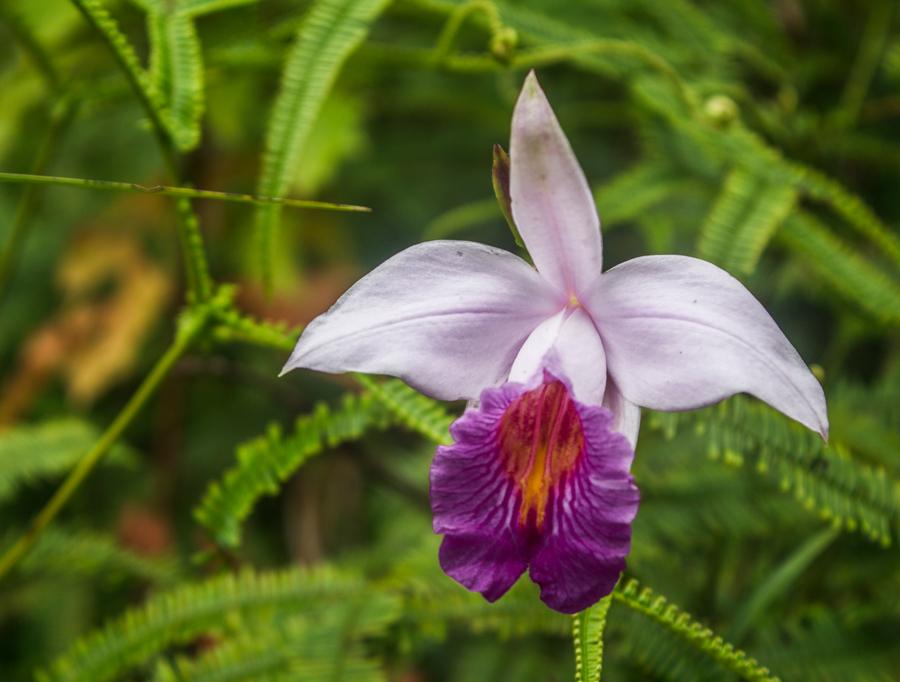
A truly magnificent plant species found in the Cameron Highlands is Rafflesia arnoldii, which produces the world’s largest bloom.
The flower often emits a powerful odour of rotting flesh, which can help guide the seeker in his quest to find the elusive plant, although the true purpose of the scent is to attract pollinators.
The plant itself is also a curiosity. It has no visible, leaves, stems or roots because it’s entirely parasitic, living off vines of the tetrastigma genus. It's often found on the forest floor but may also be found high up in the trees if its host vine is present. The fleshy fruit which small forest mammals and tree shrews will consume.
Rafflesia plant are however extremely rare and there is no predictable blooming season. The plant can bloom unexpectedly at any time, making its flower that much more elusive. When it does flower, it usually does so for a short 7-day window, but the first 3 days are the best time to view it.
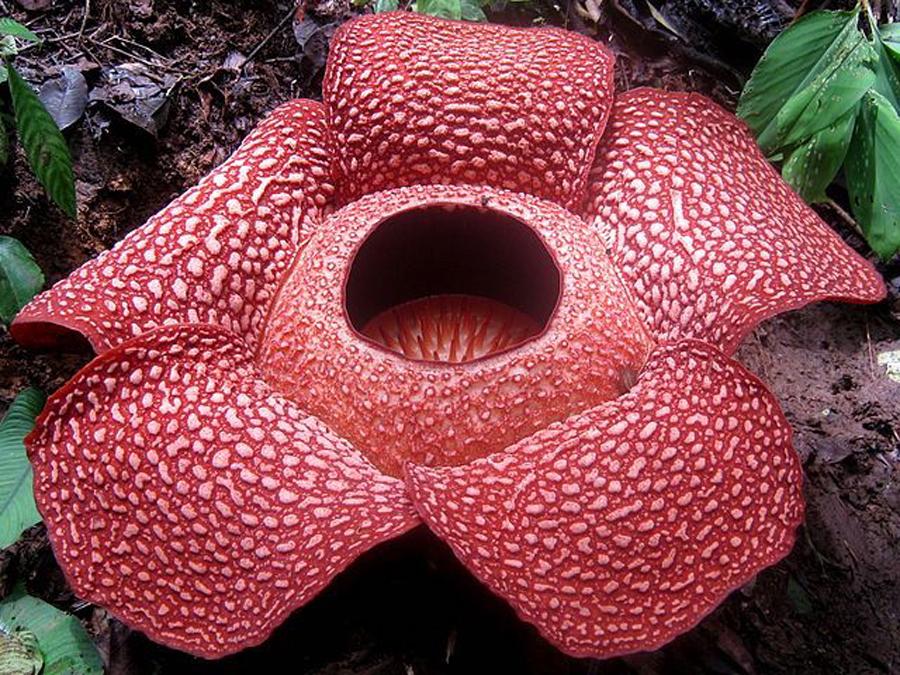
If you want to see the Rafflesia you’ll need to book an organized tour as the blooms can only be found deep in the jungle at the end of a long sweaty hike.
Before the tour can commence, operators have to first reach out to one of their aboriginal contacts to find out whether the flowers are blooming or not. Unfortunately, the Rafflesia flower is now becoming so scarce that some operators have had to stop offering the Rafflesia tours.
As regards the region's fauna there are many interesting and rare insects, birds, reptiles and mammals that inhabit the forests here. The forests teem with deer, squirrels, civets and bats.
Even mammals of the lowlands now rely on the highland forests as a place of refuge from the destruction of their lowland habitat by mankind.
In Malaysia the main problem for the lowland mammals is the replacement of their native lowland forest habitat with biologically dead plantations of palm oil, rubber, cocoa and coconut trees.
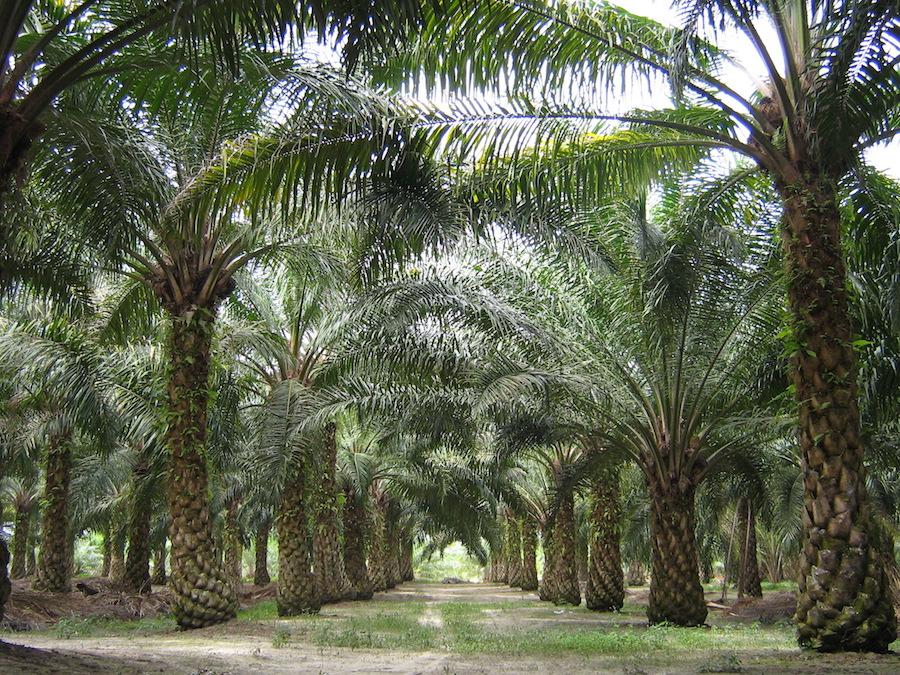
Primates like the siamang gibbon (Symphalangus syndactylus) are found in the Cameron highlands. These black-furred primates are threatened principally by habitat loss and also by the illegal pet trade. They are known to be the largest of all the gibbon species on Earth and are highly arboreal, often seen brachiating through the trees.
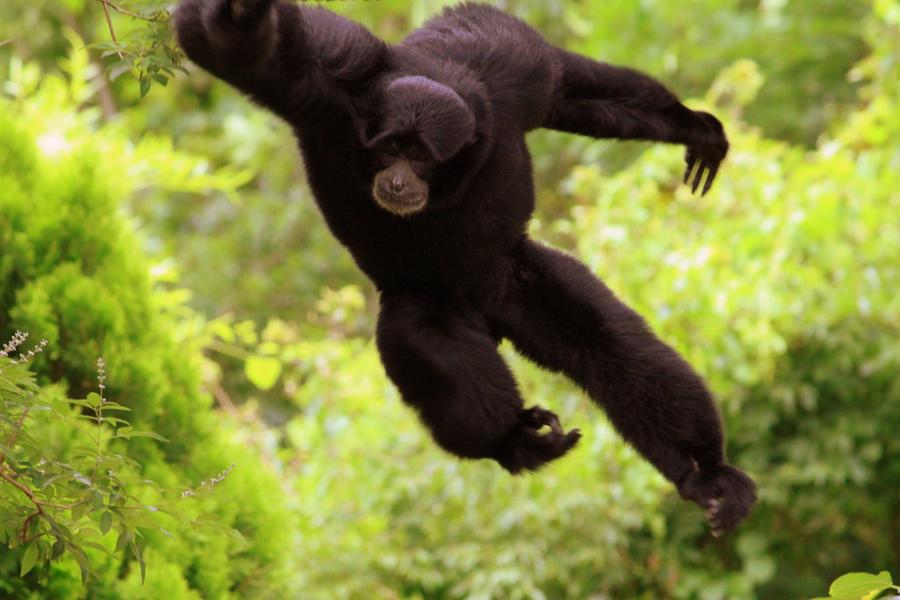
Another primate you have a chance of spotting is the white-thighed surili (Presbytis siamensis), a species that has been spotted on one of the popular jungle hiking trails.
Big cats like the clouded leopard (Neofelis nebulosa) and black panther (Panthera pardus) are said to roam the forests, but these are highly elusive and normally shy away from man. You may come across their paw prints in soft mud however.
The Cameron Highlands are also very popular with birdwatchers and as many as 177 species of birds have been spotted in the region.
Some of these bird species are threatened, like the mountain peacock-pheasant (Polyplectron inopinatum), crested argus pheasant (Rheinardia ocellata) and the Malayan whistling-thrush (Myophonus robinsoni).
The forests are also home to snakes like the endemic Cameron highlands pit viper (Popeia nebularis), montane pit viper (Ovophis monticola), common mock viper (Psammodynastes pulverulentus), Malayan mountain keelback (Amphiesma inas), large-eyed false cobra (Pseudoxenodon macrops) and many other species.
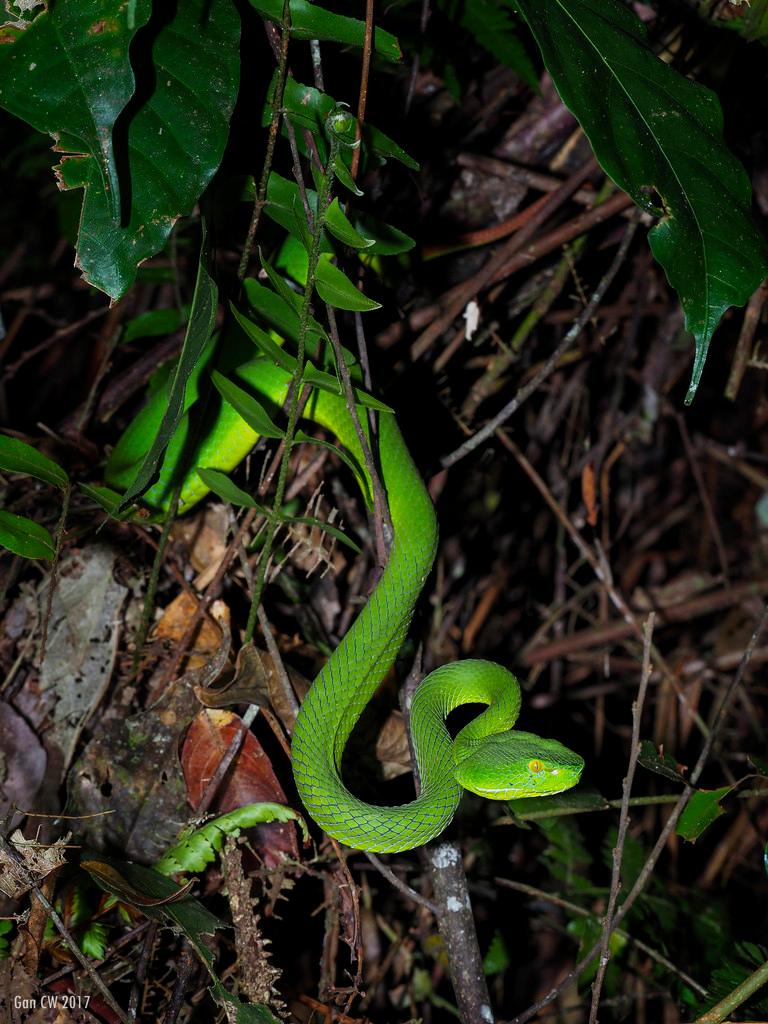
Overall the highland forests aren’t as biologically diverse as the forests of the lowlands and have a lower total species count. This is due to conditions for survival becoming less optimal with increasing altitude.
However, there are many rare and unique species that have carved out a niche for themselves here and that are found only in these montane forests and nowhere else.
The forests of the Cameron highlands host a fascinating community of precious and exquisite life forms with new species still being discovered there all the time, many of which could potentially have great medicinal and commercial value to mankind.
Environmental problems
The natural environment of the Cameron Highlands has in recent decades become afflicted by a great sickness of a hominid nature. It is now under serious threat from mankind and rampant commercial development.
Forests are rapidly disappearing due to uncontrolled and often illegal tree clearance for the purpose of constructing new hotels, housing developments, shops and farms.
Brown scars resulting from landslides and forest clearance can now be seen on the hill slopes, in places where there was once lush green forest.
This gradual decimation of the indigenous forest habitat is also wiping out much of the unique flora and fauna that the forests once supported. The indigenous montane forest now only covers about 60% of the total land surface area, whereas in the past that figure was closer to 100%.
Wildflowers that were once a common sight almost disappear from existence after a whole hill gets razed to the ground by bulldozers. Deep shelves have been cut into the hill slopes, creating flat, stepped terraces for agriculture and deforming the natural topography.
Because of the temperature changes, bird and plant species from the lowlands are moving in and displacing the native highland species.
Highly toxic banned pesticides used by many of the farms also get washed into the highland rivers, threatening the survival of native fish and other aquatic species.
Another problem related to the deforestation is the frequent landslides, which, aside from leaving unsightly scars on the landscape, can often wipe out Orang Asli villages, killing many of the inhabitants.
The landslides result because tree roots are no longer present to bind the soil together and the entire hillside becomes unstable. All it then takes is a heavy downpour (a frequent occurrence in the Cameron Highlands) to trigger a devastating landslide.
The silting and clogging up of the highland’s rivers with sediment is yet another problem related to deforestation in the region. All that loose soil material on the hill slopes now just gets washed into the rivers with the rains. Huge quantities of rubbish, detritus and rotting vegetables are also clogging up many of the rivers.
There is a reservoir in the area known as “Lake Ringlet” which has been created by the Sultan Abu Bakar hydroelectric dam and this reservoir has become so clogged with sediment that it now holds only one-third of its original capacity.
Because of this reduced storage capacity, the dam now reaches its maximum limit much more easily whenever there are heavy rains. When this happens the dam has to release water downstream in controlled bursts, often causing serious flash floods and wiping out settlements in the valley below.
On one occasion a few years back, the dam’s intake screen, which consists of a 30ft x 20ft grille of cast iron bars and acts as a filter for debris to ensure that only water is passed to the dam’s turbines, became so clogged up with rubbish and sediment that the water flow was interrupted and the turbines stopped working.
This event, combined with heavy rains that same day, also caused the reservoir’s water level to rise at an alarming rate and water had to be released in three controlled gushes, causing serious flash floods to race down through the valley below. About 100 houses and more than 100 vehicles were destroyed in the flood and 3 people lost their lives.
Things to see and do in the Cameron Highlands
Leisure activities in the Cameron Highlands revolve around paying visits to the various farms, flower nurseries and tea plantations, discovering interesting temples, exploring the night market, taking invigorating hikes in the wild forests surrounding the towns, booking a tour to squeeze as much as possible into a short visit and just generally getting out and about to enjoy the refreshingly cool climate of the region.
Here are eight awesome activities to keep you busy.
1. Visit the farms, nurseries and apiaries
There are far too many farms in the Cameron highlands to visit them all in a single trip and they wouldn't all be worth visiting anyway, so we'll just point you towards the ones that we visited and that we found to be the most worthwhile.
Big Red Strawberry Farm
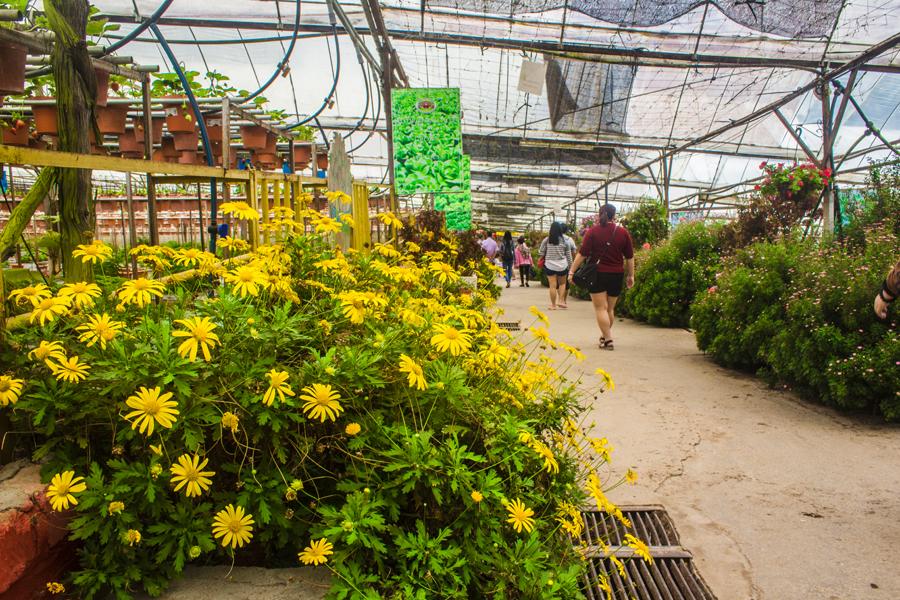
The Big Red Strawberry Farm is one of the more touristy farms in the Cameron Highlands, but that’s probably for a good reason; it has a lot to offer visitors.
The farm is mostly known for its hydroponically grown strawberries and lettuces. If you need refreshments there’s a café selling tasty treats and various strawberry-flavoured desserts. There's also a gift shop selling kitschy strawberry-themed souvenirs and merchandise.
Directions: Finding the Big Red Strawberry farm is easy. It’s located just north of Brinchang and you can get there by turning left off the main road (route 59) just before entering the town from the south. Continue along this road for a few hundred metres and then when the road starts curving to the right, turn off it down a smaller road to your left. The farm is at the end of this road.
The biggest attraction for many visitors at the Big Red Strawberry farm is the opportunity to pick their own strawberries. However, if you want to be able to do this, you'll probably have to arrive early in the morning and will also need to visit during the fruiting season.
We visited during the afternoon one day and were told that we were too late in the day for strawberry picking. Make sure you enquire about seasons and picking times beforehand.
The strawberry picking here is also quite an expensive activity, all for the sake of being afforded the luxury of “picking” your own strawberries. The cost to pick half a kilo of strawberries is around 25 RM ($5.83), a price that was hard to justify considering how we could buy double that amount in Mahabaleshwar, India for just 30 rupees ($0.46).
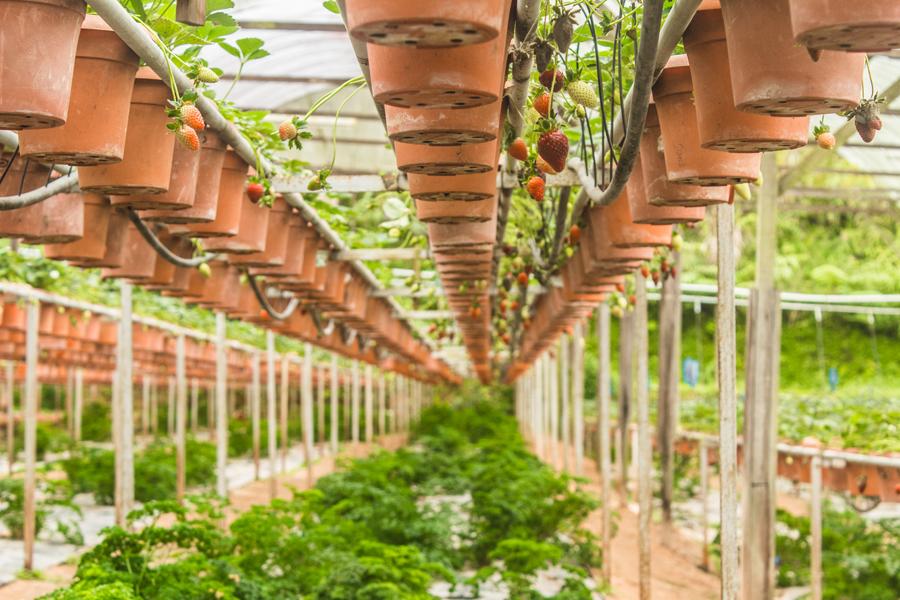
The hydroponically grown lettuces are another interesting phenomenon at the farm. Hydroponics is a system for cultivating plants in nutrient-rich water or in other soil-less mediums.
In the Big Red Strawberry Farm, the lettuces are grown inside small pots that are fitted into purpose-cut holes in a length of plastic piping.
A thin film of nutrient-rich water (a nutrient solution) is constantly circulated through the piping by means of a pump and this film of water is in constant contact with the roots of the lettuce plants, allowing them to soak up everything they need to thrive.


The farm’s café has an extensive selection of mouth-watering treats such as milkshakes, juices, ice-cream, cheesecake, sundaes, lassi, hot chocolate, pancakes, waffles, muffins and more. Most of these items, as you might have guessed, are strawberry-flavoured.
Just next to the café is the gift shop, where you can buy all sorts of kitschy strawberry-themed souvenirs like pillows, keyrings, umbrellas and fridge magnets.
There's also an assortment of boxed strawberry-themed products like milk and white chocolate-coated strawberries, teas, syrups, jams, biscuits and more.
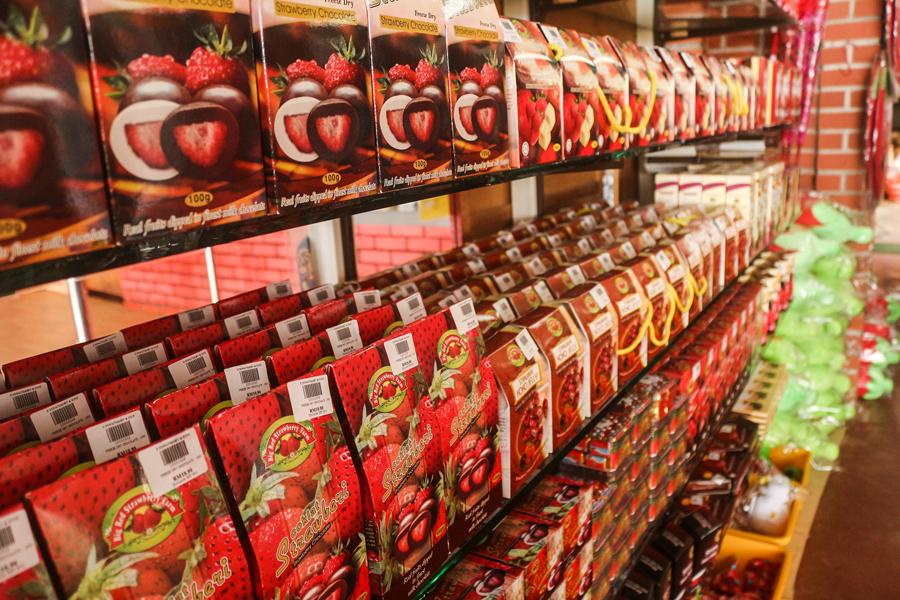
Visitors can explore the farm by means of walkways lined with bushes displaying showy colourful flowers, which prove to be quite popular as a backdrop for the selfie-snapping Asian tourists.
There is also a garden shop near the entrance, with hundreds of varieties of potted plants for sale, including many cactus plants.

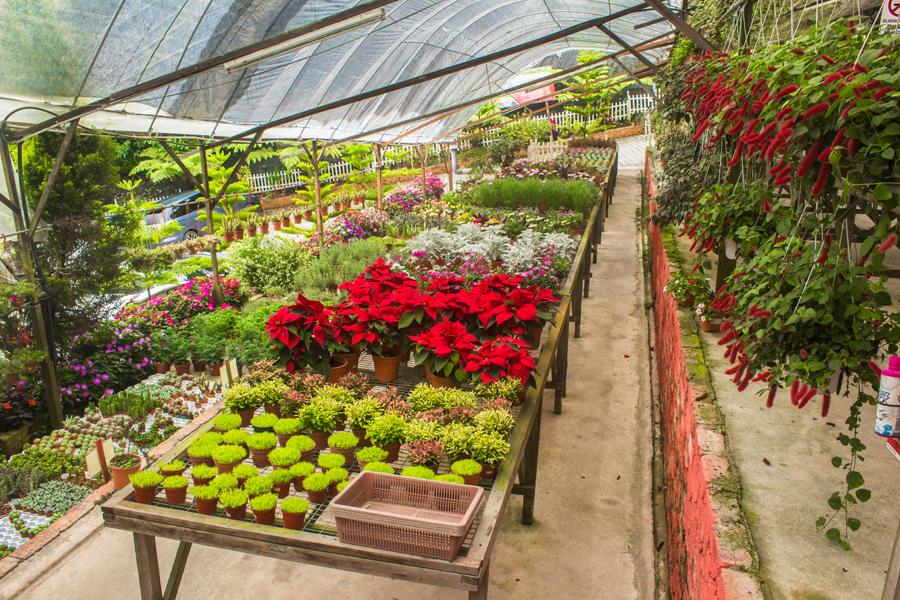
We discovered a fabulous display of cacti in one corner of the centre with several large barrel cacti and other exotic looking specimens. Some of the specimens were even in flower, exhibiting magnificent yellow and pink blossoms.

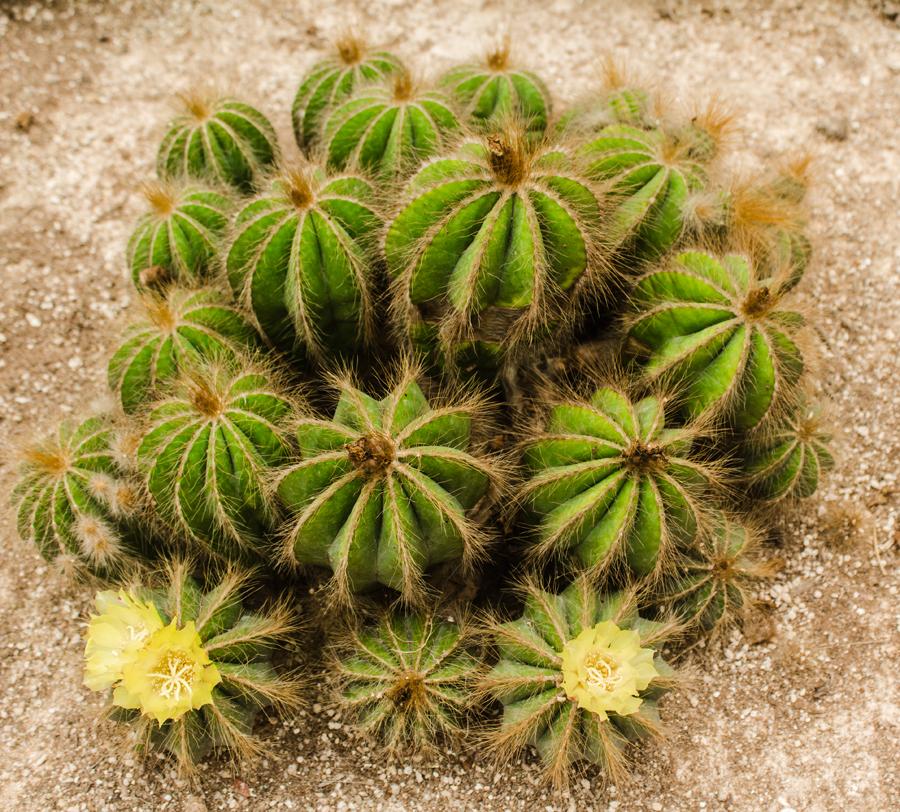
Cactus valley

The cactus valley is an exhibition centre with many varieties of cactus plants and succulents, in addition to many other flowering plants and hydroponically grown vegetables.
You will encounter the entrance with the ticket booth just before you come to the Big Red Strawberry Farm. You have to pass by Cactus Valley in order to get to the strawberry farm.
The entrance fee is around 4-5RM for adults but it was possible to avoid the fee by entering from the adjacent shop selling various potted cacti specimens and other potted plants.
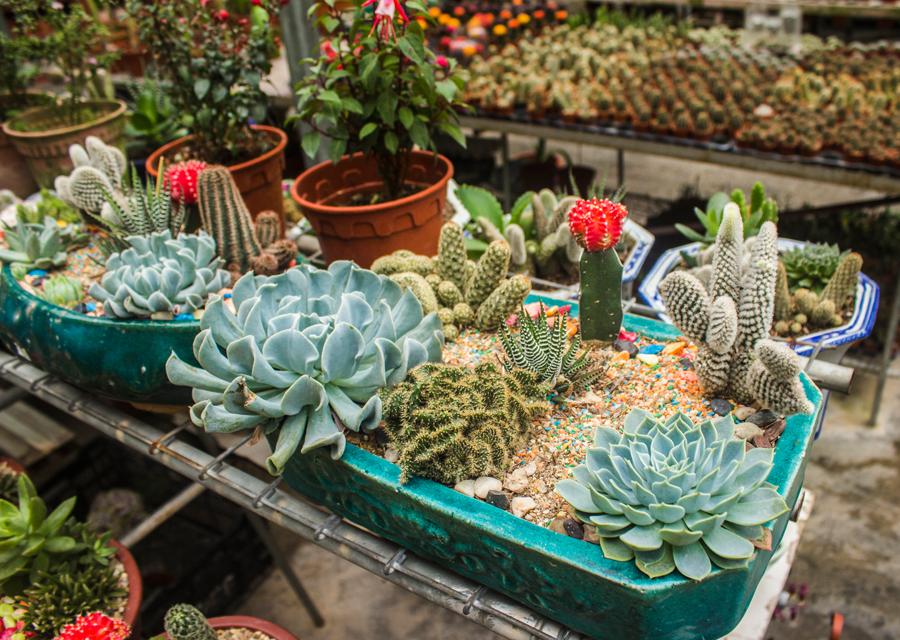
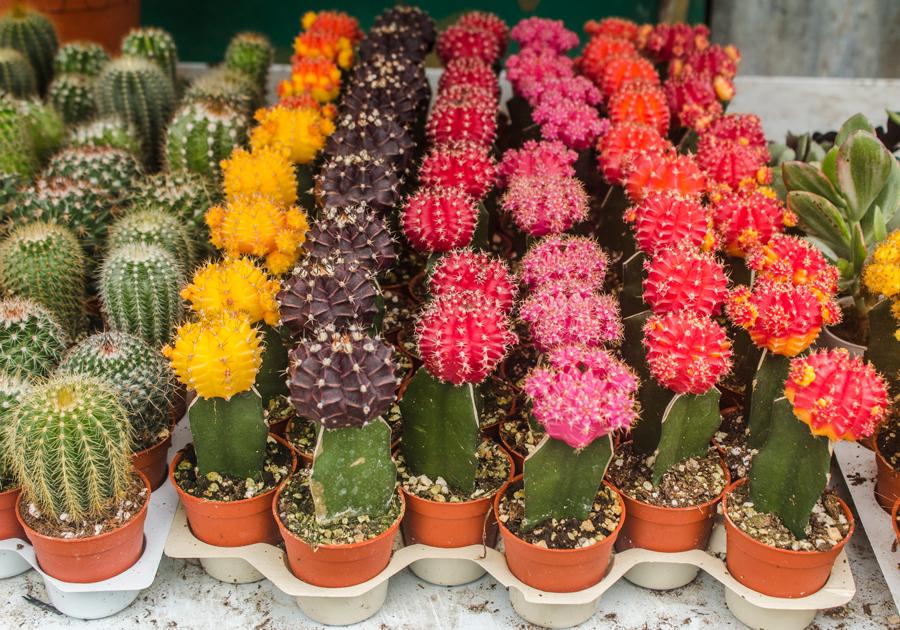
From the back of this shop there’s a pathway leading into the Cactus Valley centre and if you’re discreet enough, you may be able to wander inside without anybody noticing.
The premises are planted with a diverse range of shrubs and flowering plants, including grape vines and peach trees, but the main attraction here is definitely the cactii, of which there are numerous varieties on display throughout the premises.
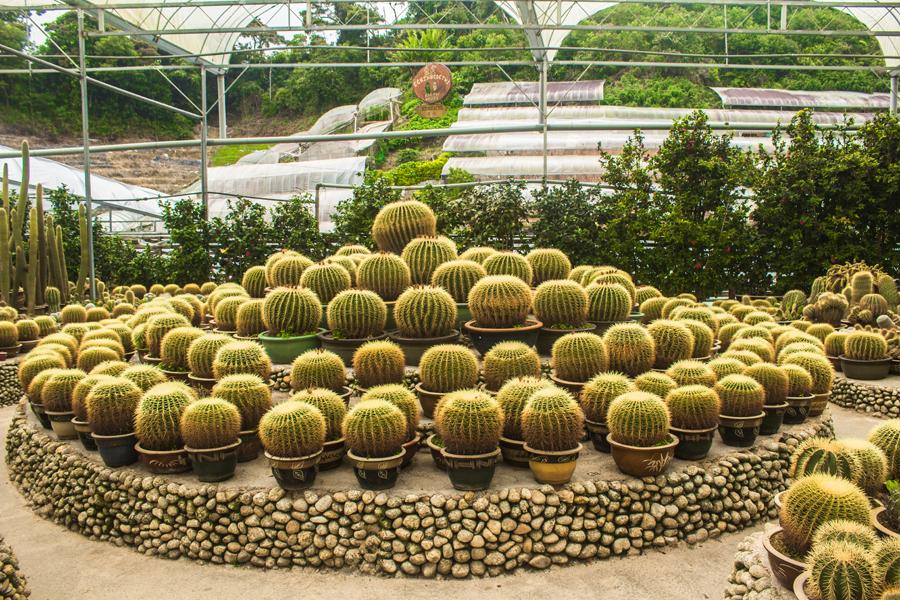
Very few of the cactus specimens are labeled unfortunately so you’re left guessing what they are or where they originate from, although the main exhibition is visually rather splendid and makes for some good photo opportunities.
A few of the cactii were flowering during our visit, exhibiting wonderful pink and red blossoms that were really a delight to see.
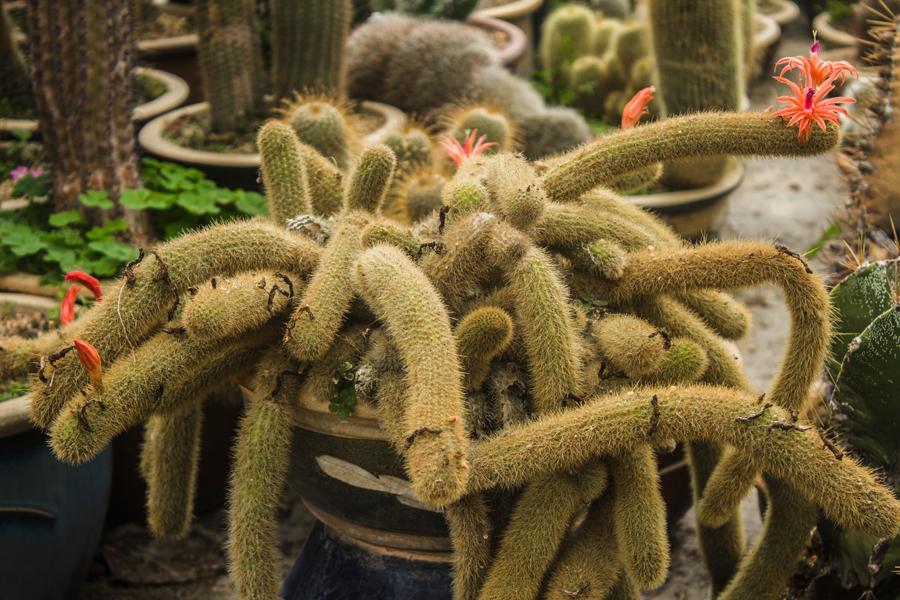
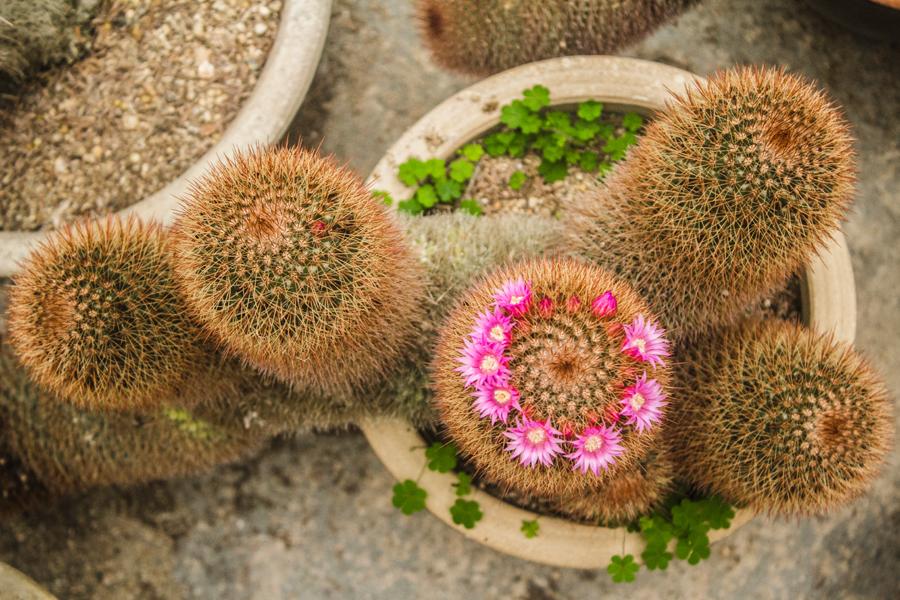
There’s an adjoining outdoor terrace here where you'll find a very large monument resembling a gargantuan-sized cactus, which presumably functions as a giant advertising beacon for the nursery. The statue also provides benches to sit on.
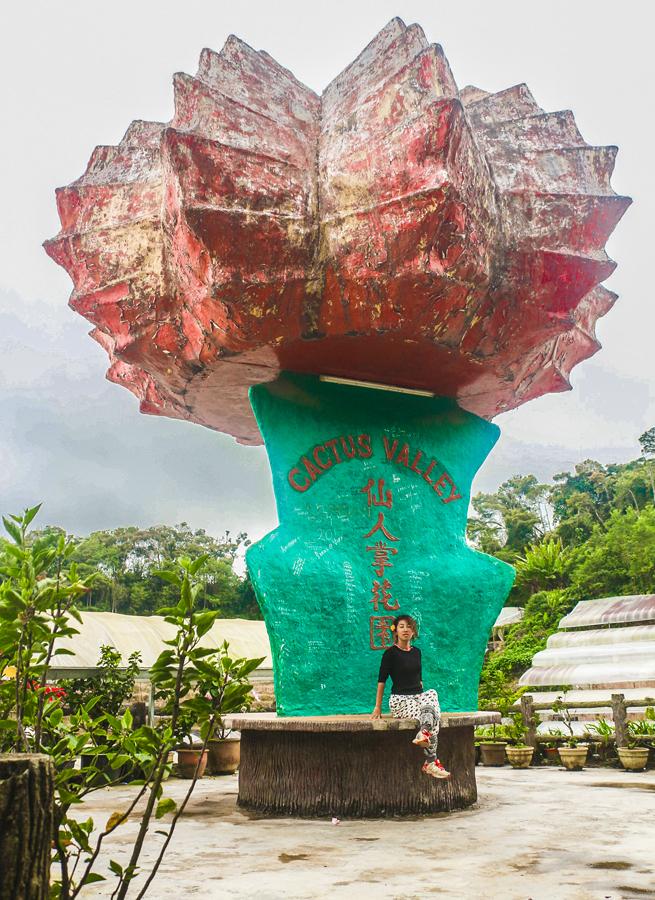
Butterfly farm
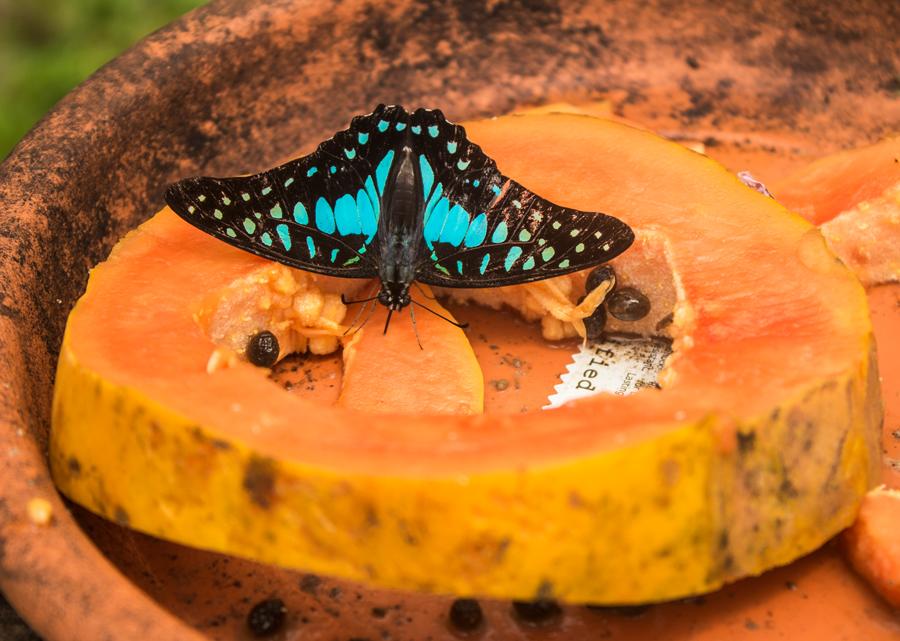
The butterfly farm was started by a hobbyist back in 1990 and is now one of the more popular attractions in the region, with a butterfly house full of colourful butterflies flitting about and a miniature zoo with many native and non-native mammals, reptiles, amphibians and curious insects. There’s also a small flower nursery at the back of the premises.
Directions: The butterfly farm is found right beside the main road, about 4.5 km northeast of Brinchang. It lies directly next to a very similar but less popular competing attraction called the butterfly garden. There’s an entrance fee of 5RM to be paid here.
When you first enter, a pathway takes you through the first section of the mini-zoo, which is mostly an exhibit for various exotic beetles, insects and invertebrates. There are various enclosures and transparent walled cages that you can peer into and try to find the creatures that are supposed to be inside.
In practice, some of the exhibits are devoid of living creatures and in a several others the creatures are too well camouflaged or hidden to be seen. In truth the living conditions for many of the creatures here were pretty deplorable, as is the case for most creatures that are kept in captivity.
Inside the giant Asian forest scorpions (Heterometrus spinifer), stick insects (Phasmatodea sp.), three-horned rhinoceros beetles (Chalcosoma caucasus), giant stag beetles (Dorcus titanus) Asian palm weevils (Rhynchophorus ferrugineus), dragon-headed katydid (Ellatodon blanchardi), orchid mantises (Hymenopus coronatus), giant leaf insects (Phyllium giganteum) and others.
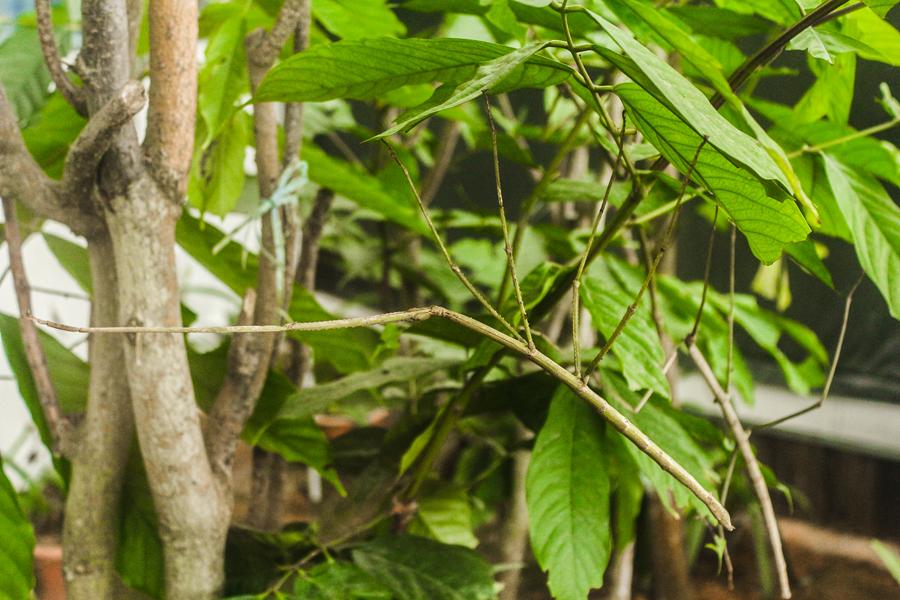
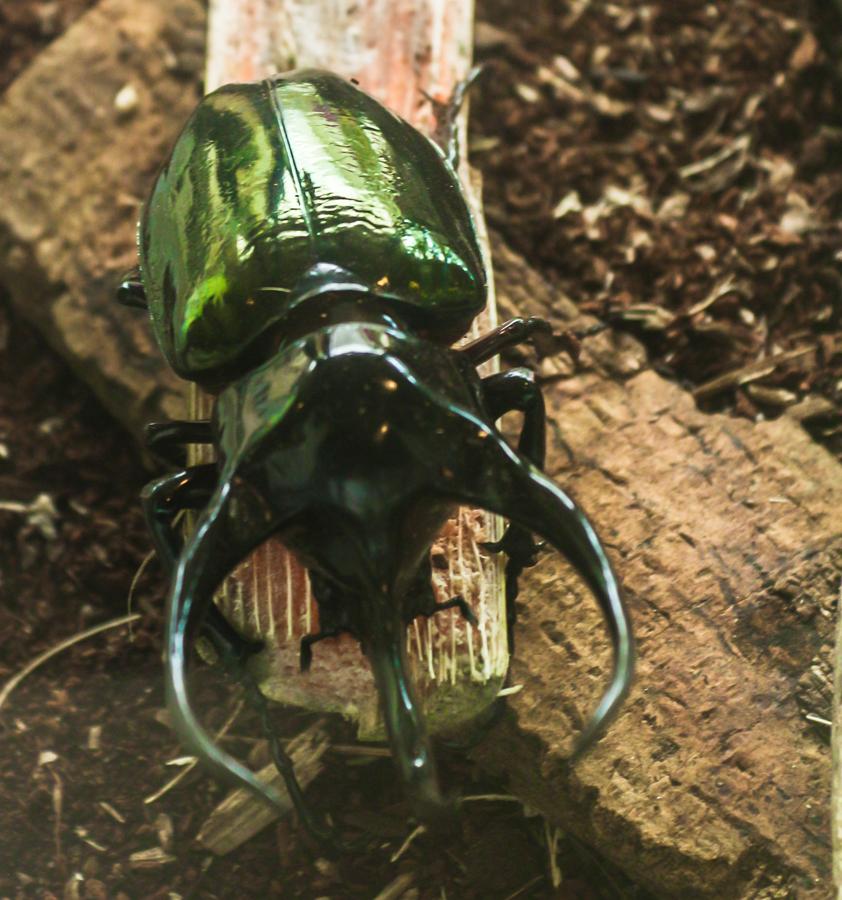
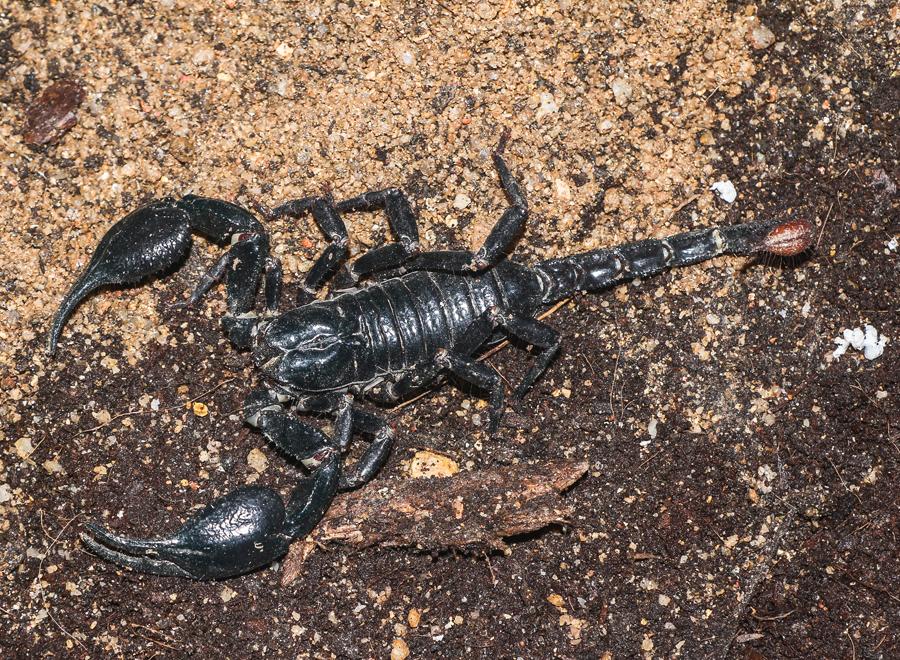

In the other part of the zoo we spotted raccoons (Procyon lotor), hedgehogs, domestic turkeys (Melagris gallopavo), chipmunks (Tamias striatus), tarantulas, snakes and various amphibians.
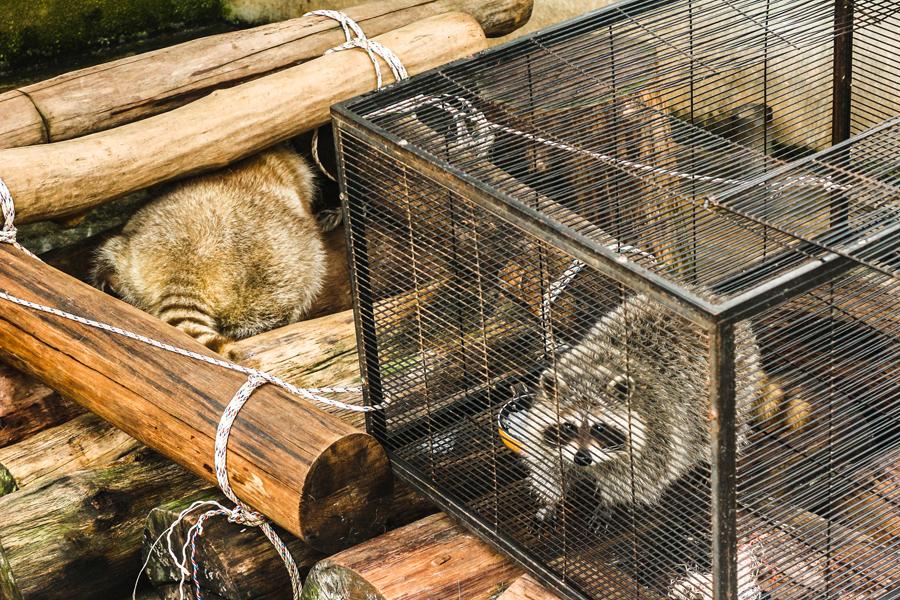
The North American chipmunks (Tamias striatus) were darting around and feeding on sweetcorn inside a big glass-walled enclosure.

Snakes on display include the long-nosed whip snake (Ahaetulla prasina), Brook’s King Snake (Lampropelitis getula brooksi), Albino Sinalon Milk Snake (Lampropeltis triangulum sinaloae), Cameron highland’s pit viper (Popeia nebularis), cave dwelling snake/cave racer (Orthriophis taeniurus ridleyi) and a few others.
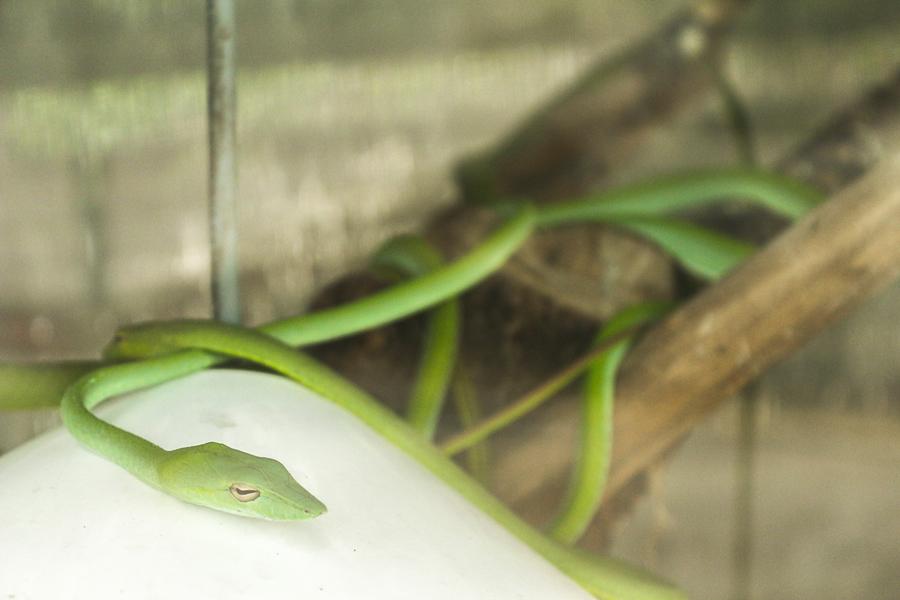
There were also long-nosed horn frogs (Megophrys nasuta), bullfrogs (Rana catesbeiana) and two absolutely enormous Asian giant toads (Phrynoidis asper) that were the biggest toads we’ve ever seen.

The adjacent butterfly house is a large netted enclosure planted with small trees, flowering shrubs and herbs, complete with walkways that take the visitor through the exhibit.
Butterflies are everywhere inside the enclosure, fluttering about restlessly or alighting on flowers for a sip of their sweet nectar. The herbs and shrubs here also provide food for the butterfly caterpillars.
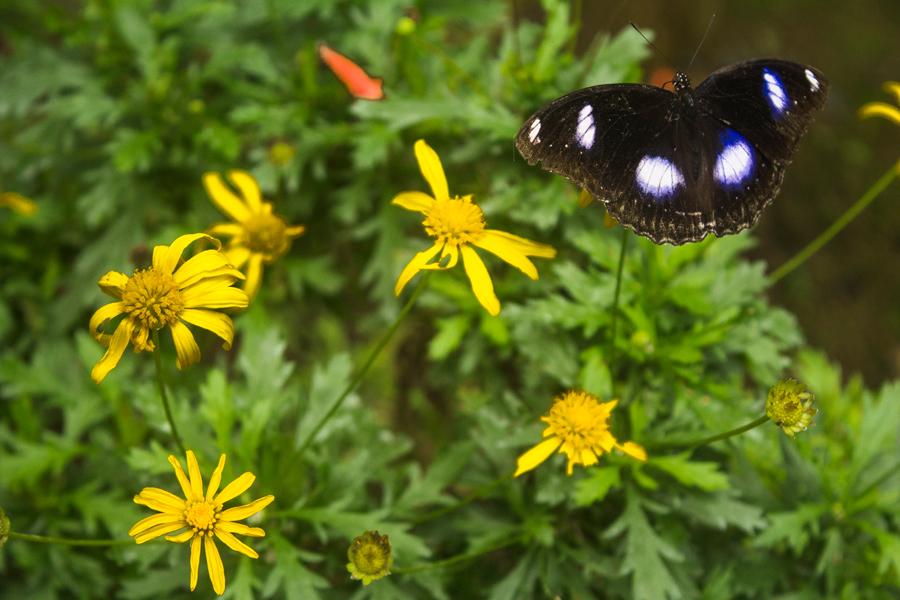
There are said to be 20 species of butterflies exhibited inside the butterfly house, which all naturally occur in the Malaysian tropical rainforest. The butterflies are mostly from the Papilionidae (swallowtails), Nymphalidae (largest butterfly family), Danaidae (milkweed butterflies) and Pieridae (whites & sulfurs) families.
As you walk around, you may notice that many of the butterflies seem to be feeding on rotting fruits like papayas that have been left out for them. Many people think that butterflies only drink nectar from flowers but this is manifestly not the case.

What these butterflies are actually doing is using their hollow, straw-like proboscis tube to suck up the sweet juices of the rotting fruit.
Butterflies may also suck up the juices from dung, tree sap, sweat, tears, blood, urine, mud, decaying animal flesh (starting to liquefy) and other juicy, nutrient-rich organic material.
Here's an interesting article about disgusting things that butterflies eat.
Photographing the butterflies in a place like this can be frustrating at times. Some of the more restless specimens just won’t seem to stop flitting about the place.
There was one very uniquely coloured butterfly that we spotted, of a brilliant red-orange hue, which wouldn’t stop fluttering about all the while, so we had to settle for a blurred shot of the creature mid-flight.
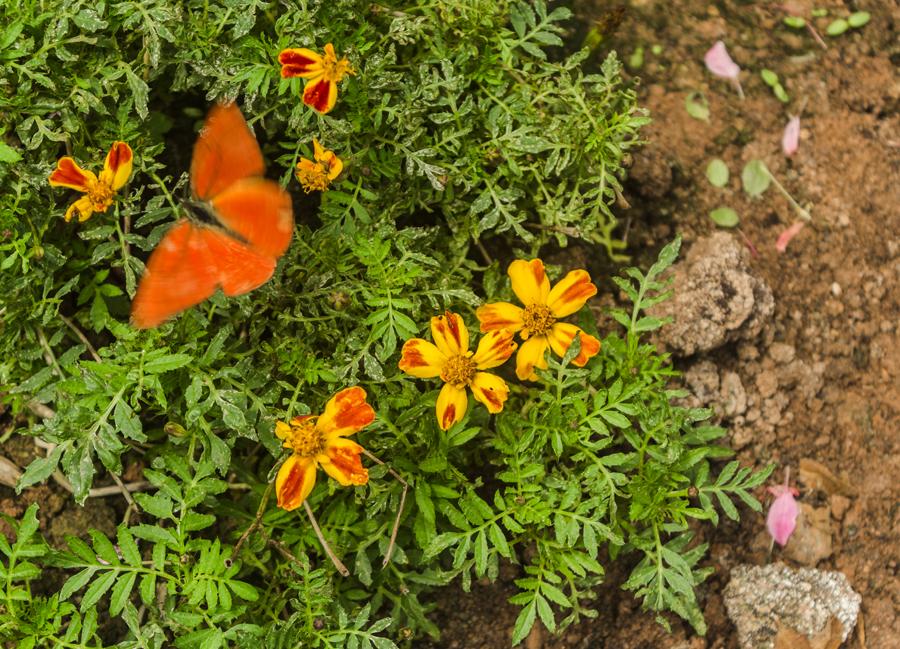
Even if these restless souls do alight somewhere momentarily, by the time you’ve composed your shot and mashed the shutter button, they’ve usually flown away again. It definitely helps to have a good zoom lens, as the further away you can be when taking the shot, the less of a chance that you’ll cause a disturbance.
You’ll probably notice a few dead or ailing butterflies around the butterfly house. This is a pretty typical sight inside these enclosures. Female butterflies usually die after laying all their eggs and male butterflies will normally die about 6-8 weeks after their sperm is depleted from mating with various female butterflies.
Here are some more of our favourite butterfly shots from the day:
.jpg)
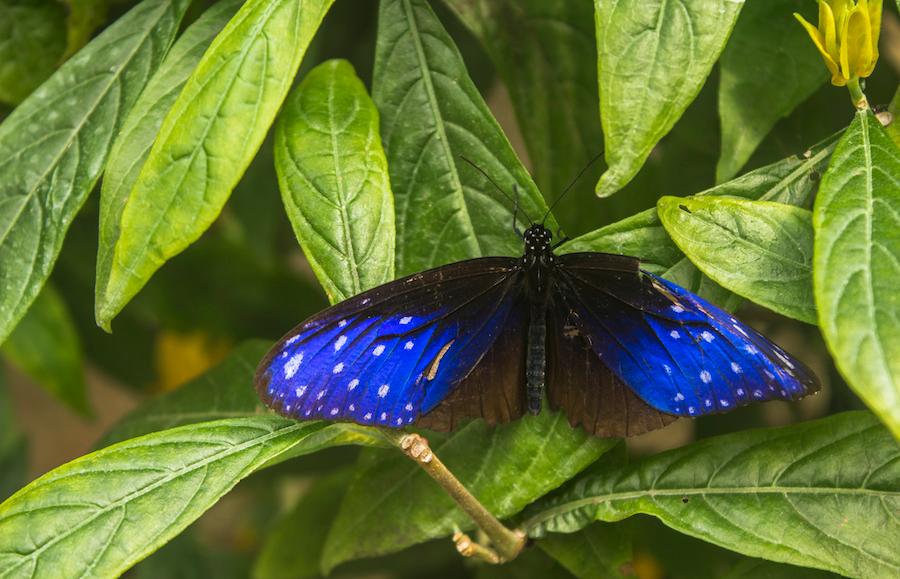

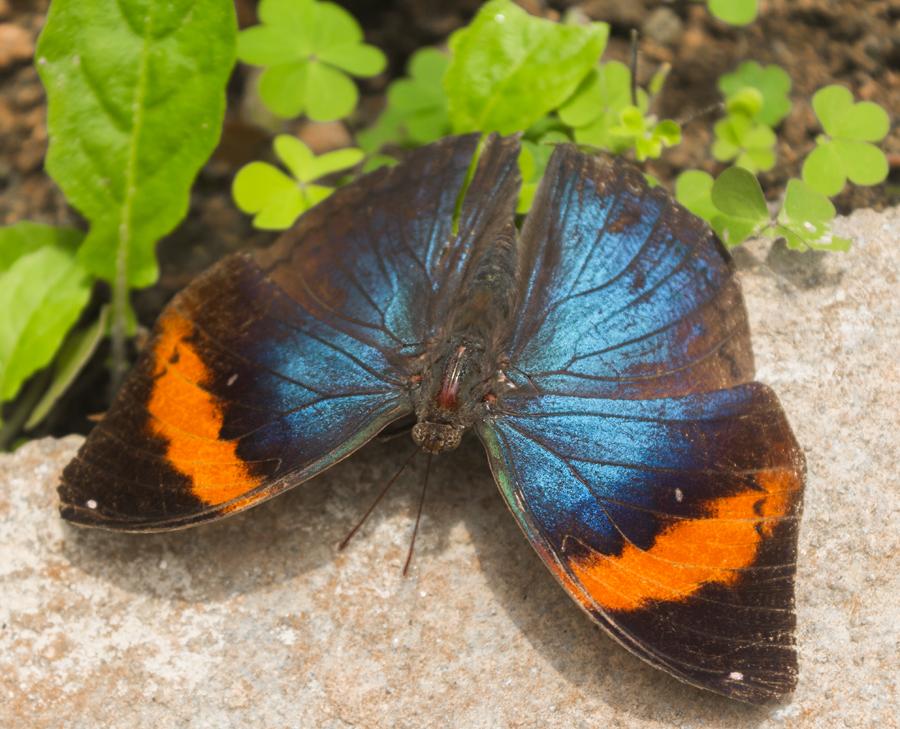

Outside the butterfly house is a large chart with a diagram illustrating the lifecycle of the butterfly and an adjacent fact file describing the main differences between butterflies and moths.
You can also take a stroll around the garden out the back, which is mostly planted with Gerbera daisies (Gerbera jamesonii) of so many different hues including scarlets, reds, oranges, yellows, whites and pinks.
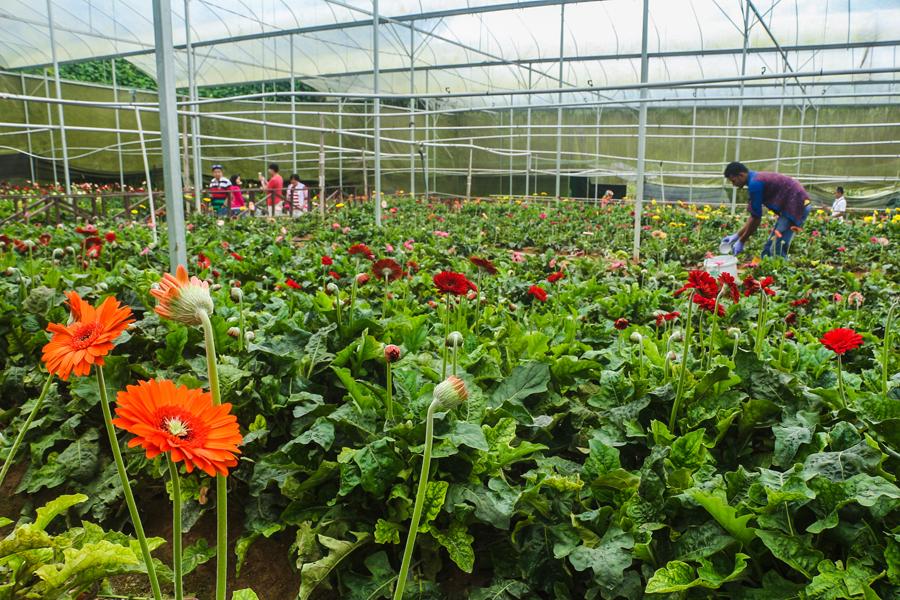
In a souvenir shop directly adjacent to the butterfly farm facing the main road, you will also find dozens of see-through acrylic frames displaying various aesthetically striking butterflies, moths, beetles, insects scorpions and other creatures. These are all on sale at prices ranging from 50RM to 500RM.
Most of the creatures on display are found in Asia, but not necessarily in Malaysia. Some of the cases display a collection of species whereas others just display a single specimen. The full collections are normally more expensive.



Ee Feng Gu honey bee Farm
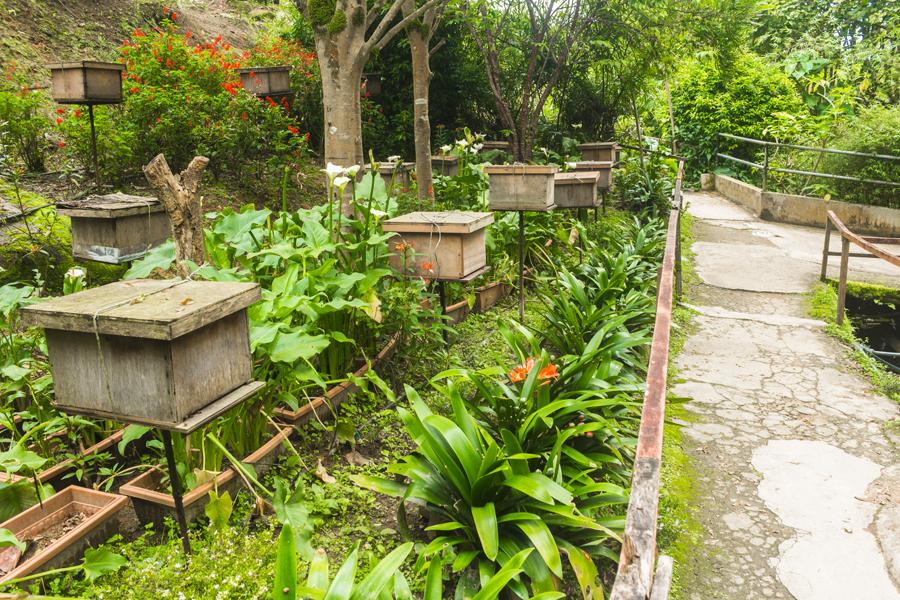
The Ee Feng Gu honey bee farm has been around for three generations and is the more popular of the two bee farms found in the region; the other one is the Cameron Tringkap bee farm found further out the road in Tringkap.
Directions: The farm is located right next to the main road on your right hand side when approaching from Brinchang and is about 4.5 km northeast of the town. Entry to the farm is free.
When you first enter the building, you may doubt as to whether there is any bee farm here at all.
You’re greeted by a huge gift shop filled with shelves and shelves displaying all kinds of bee-derived products, cosmetics, kitschy souvenirs and other items that must appeal to the “consumer-minded” tourist. This huge gift shop is presumably to compensate for the free entry.
The company’s bee-derived products include bee pollen, crystallized honey, pure wild honey, premium honey, royal jelly, propolis honey, natural honey vinegar, Tongkat Ali honey and several others. The health benefits of all these products are explained on the company’s website.
Descending downstairs to the floor the below, the situation doesn’t improve much as more merchandise awaits you down here, but there is at least a mini-museum here on this level with some information about bees and 3D models of various types of beehives inside glass cases.
Apis mellifera or the European honey bee is mentioned in the museum, which is the most common of the 7-12 species of honey bees that occur worldwide. Apis cerana is also mentioned, which is the Asian or eastern honey bee.
The genus Apis generally defines honey bees, which are in turn defined as bees that produce and store honey and that build perennial nests from beeswax.
The main information panel mentions how there are 20,000 species of bees worldwide, meaning that only a miniscule fraction of bees actually produce honey. It also discusses the differences between worker bees, queen bees and drones.
Worker bee – Female bees that lack full reproductive capacity. They’re involved in routine tasks like pollen collection and possess stingers but they don’t mate.
Queen bee – The mother of most, if not all the bees in the colony. Worker bees develop the queen bee by feeding the larvae a special diet until they become sexually mature. Her sole function is to reproduce.
Drone – Male bees that are born from an unfertilized egg. Their sole function is to mate with the queen bee and help her produce new offspring. They don’t gather any nectar or pollen and don’t possess any stingers.
There’s an interesting snippet about a megalithic cave painting that was found in Bicorp, (Valencia) Spain. The painting depicts a person scaling a cliff face by means of natural hanging vines in order to steal honey from a bee hive found high up on the cliff face inside a rock crevice.
We also learn that the earliest bee hives, known as skeps, have been in existence for about 2000 years and were originally just wicker baskets caulked in mud and dung.
Later in the middle ages these skeps consisted of coiled straw baskets that were turned upside down, leaving a small hole at the top for bees to get in and out. The bees had to produce their own honeycomb, as there was no internal structure provided within.
Continuing down another staircase, you’ll encounter yet another shop selling merchandize and souvenirs at the bottom. Beyond this is the entrance to what is claimed to be the largest maze indoor maze in Malaysia. However, it didn’t appear to be operational during our visit.
Once you reach the very bottom of the stairwell, you’ll finally find yourself at ground level in the bee farm…. and there’s not a whole lot to see here to be perfectly honest.
There are walkways leading through a peaceful orchard of sorts, which is planted with many small trees and flowering plants. Dozens of small, man-made wooden boxes (the beehives), each one mounted atop a thin rod or stick, have been erected alongside the walkways and on other parts of the property.
The boxes have a small hole to let the bees pass in and out but you won’t be able to see what’s going on inside the boxes, so it’s not very interesting. You may notice large numbers of bees congregating on the outside of some of the boxes.
In our experience there weren’t too many airborne bees flying around the orchard and there was little risk of being stung if we observed the bee boxes from a distance.
A sign at the farm, also translated into Chinese warns:
“The owners of this farm are not responsible for any harm arising to visitors during visits to these premises.”
You may also notice a few garish, comical-looking statues of bee mascots around the farm. Apparently there are 11 mascots in total scattered around the farm and each one has its own unique name.
The company is obviously targeting families with children. The kids enjoy all the silly statues and the bored parents succumb to spending money in the gift shop.
You may or may not see any beekeepers floating around the farm. We didn’t see any. In pictures we’ve seen, they wear protective clothing, special protective gloves and wide-brimmed hats with integrated blue head nets that cover the head and neck completely.
If you do run into one of the beekeepers, they are supposedly obliging in answering questions and helping you to learn more about beekeeping. You’ll probably need to talk to one to make your visit a bit more interesting, since no guides are provided.
Lavender Garden
The Lavender Garden is one of the newest tourist attractions in the Cameron highlands, consisting of a tawdry flower exhibition cultivating many flower varieties but with a particular emphasis on lavender.
There’s also a gift shop, a café, an ice-cream parlour (lavender ice-cream is available) and various props for tourists to snap photographs, including some garish “love-themed” murals.
The lavender flowers may be beautiful but the entire backdrop and surrounding scene is ugly and man-made so it’s definitely not the kind of place where you could pose for a photo in a yellow dress with an endless field of purple lavender flowers as a backdrop.
With the steep entrance fee of RM 8 and the attraction being another cheap, contrived Malaysian tourist attraction and also being found on the main road about 1.5 km beyond Tringkap, we weren’t bothered making a trip all the way out here from Tanah Rata.
You can learn more about the lavender farm here.
Other farms and nurseries
There are a few other farms and nurseries in the Cameron Highlands other than the ones we’ve already described.
If you can’t get enough of strawberries, you could also head to farms like Raaju’s hill strawberry farm, Kok Lim strawberry farm, Kasimanis strawberry farm and a few others, but these are really all the same experience. You can pick strawberries at Raaju’s hill - we’re not sure about the others.
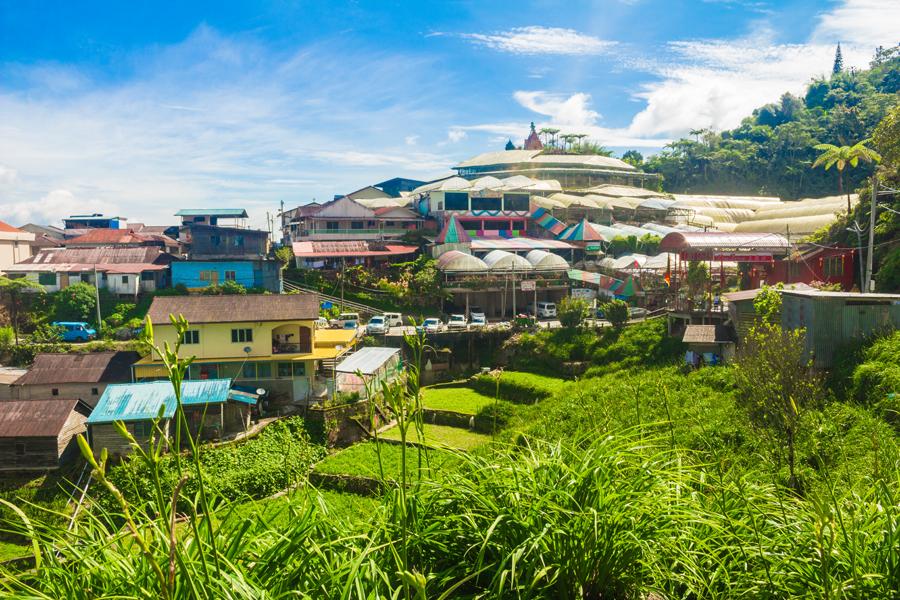
If you really like rose flowers, there is the Rose Centre, an extensive flower nursery in a beautiful hillside setting.
The place is huge and multi-terraced, dominating the entire face of a hillside. It’s found at the end of a side road, with the turn-off for the side road found very close to Raaju’s Hill strawberry farm, just a few kilometres northeast of Brinchang.
The Rose Centre allegedly nurses over 100 varieties of roses and many other flower varieties. There’s also a collection of kitschy statues distributed throughout the premises. Entrance fee is 5RM for adults.

As we already mentioned, the Cameron Tringkap Bee farm is an alternative to the Ee Feng Gu honey bee farm. Although we didn't visit, it supposedly has an informative mini-museum on honey production methods and beekeeping.
2. Hike the jungle trails
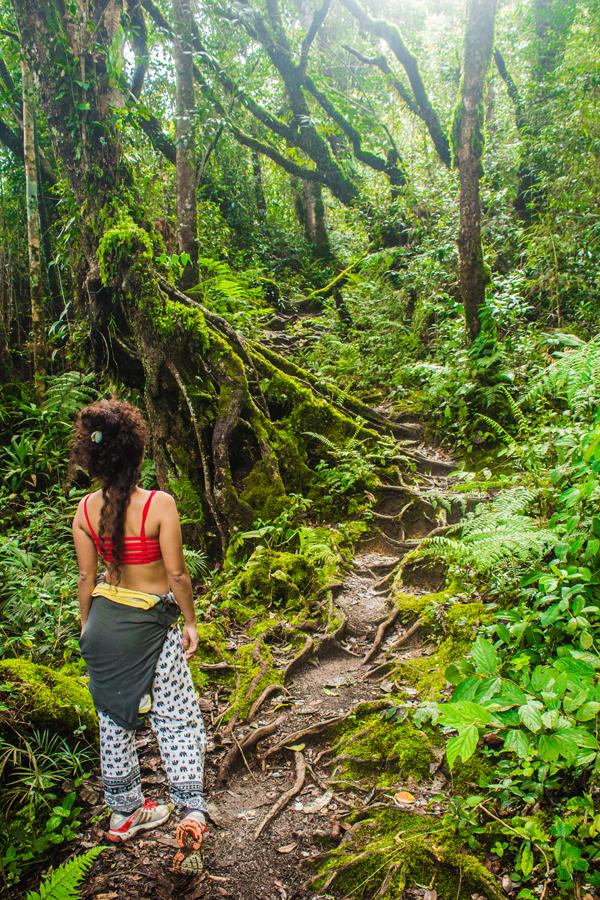
There are fourteen well-defined jungle trails in the Cameron Highlands and they are numbered Trail no.1, Trail no.2, Trail no.3 etc.
Most of the trails begin on the outskirts of Tanah Rata and Brinchang and lead to various points of interest including local mountain peaks, waterfalls, hydroelectric dams and Orang Asli villages. Along the trails you can observe many beautiful wildflowers and possibly spot wildlife, if you're lucky.
Most of the hikes we’ve recommended are reasonably short day-hikes, only taking a few hours to complete and all will return you to a road at the end, from where you can try to catch a bus, hail a taxi, walk or hitch a ride back to town.
While you won’t be too far from civilization on any of these trails, that still doesn’t mean that you won’t run into trouble if you’re not sensible. You don’t want to end up like Jim Thompson.
Treat your walks as you would any day hike into a remote area and make sure not to set out too late in the day. Early morning starts are best. Stumbling through the dark forest at night on your way back to town is not the ideal way to finish off the day, even if you are sensible enough to bring a headlamp or a flashlight.
While the trails were quite well defined, easy to follow and we never once lost them, we recommend that you download the maps.me app if you haven’t already, as it has all the trails clearly marked so you can confidently tackle them independently with a greatly lowered risk of getting lost.
The usual advice also applies about bringing ample supplies of food and water, although you won’t be drinking nearly as much water as you would on a tropical hike in the much hotter, steamy jungles of the lowlands.
You certainly don’t have to do all the trails, as they do start to become a bit repetitive and you likely won’t have time to do them all anyway unless you’re staying in the highlands long-term.
During our stay, we hiked the trails that sounded the most appealing to us and that we figured would offer the greatest reward for our efforts. Here are the trails that we recommend you do:
Trail No. 10 to the summit of Gunung Jasar (1,696m) and on to the peak of Gunung Perdah (1,551m)
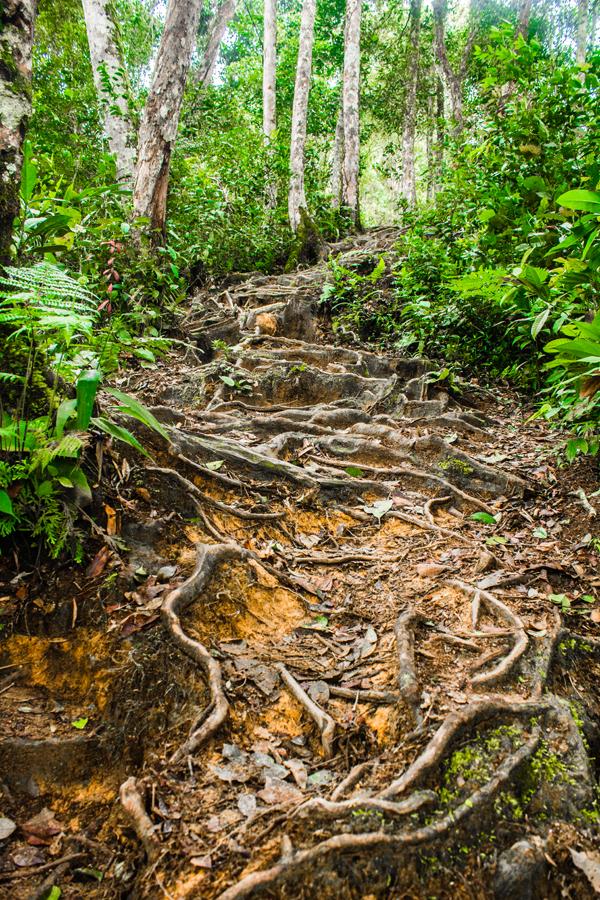
The start of this trail is accessed from Tan’s Camellia garden located just off of the main road at the far west end of Tanah Rata town. The garden itself is worth a gander as there are many beautiful showy flowers and interesting plants on display.
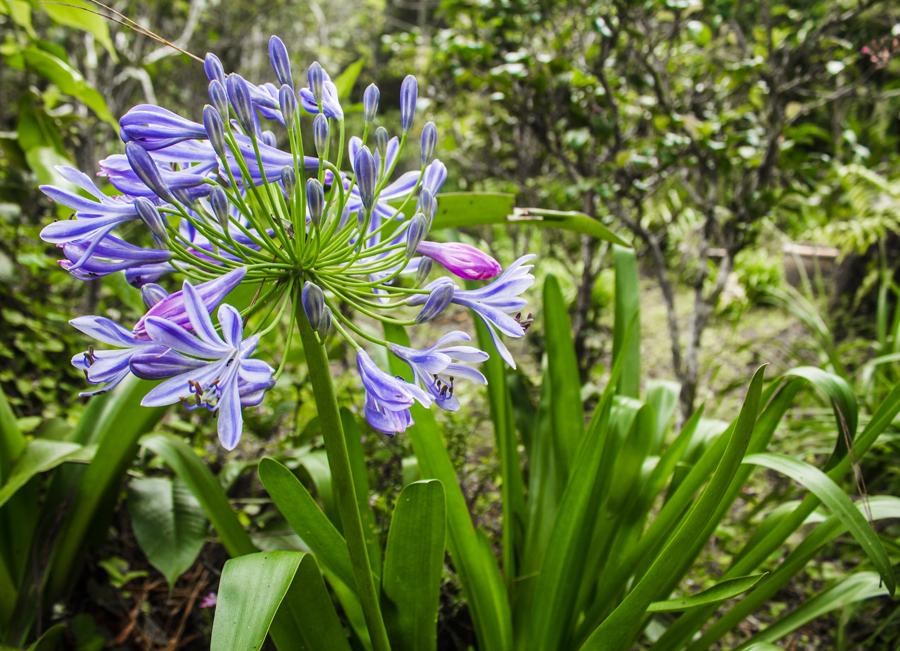

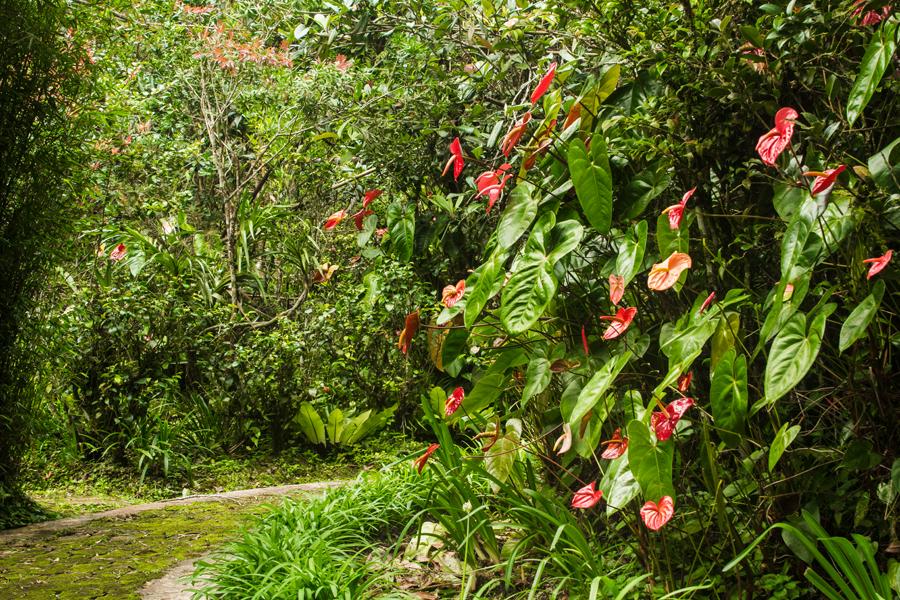
At the back end of the garden, there is a flight of concrete steps leading uphill and at the top of these you should be able to find the start of the trail that climbs up into the forest. The trailhead is marked by a small wooden sign post saying “Walk No. 10 Gunung Jasar”.
The trail snakes steadily through the damp montane forest, staying relatively flat or climbing gently at the beginning. Exposed tree roots crisscross the trail in many places and fallen trees must occasionally be ducked beneath or clambered over.
At one point along the trail there’s a fork where you have the option of detouring off trail no.10 onto trail no. 11, which takes you to directly to Gunung Perdah. This route was "closed" during our visit however.
Further on, the trail starts become a lot steeper and more challenging. Before you reach the peak of Gunung Jasar, you’ll come to a small plateau with a large electric pylon built upon it. From here there are fine views of Tanah Rata and the Cameron Bharat Tea plantation.
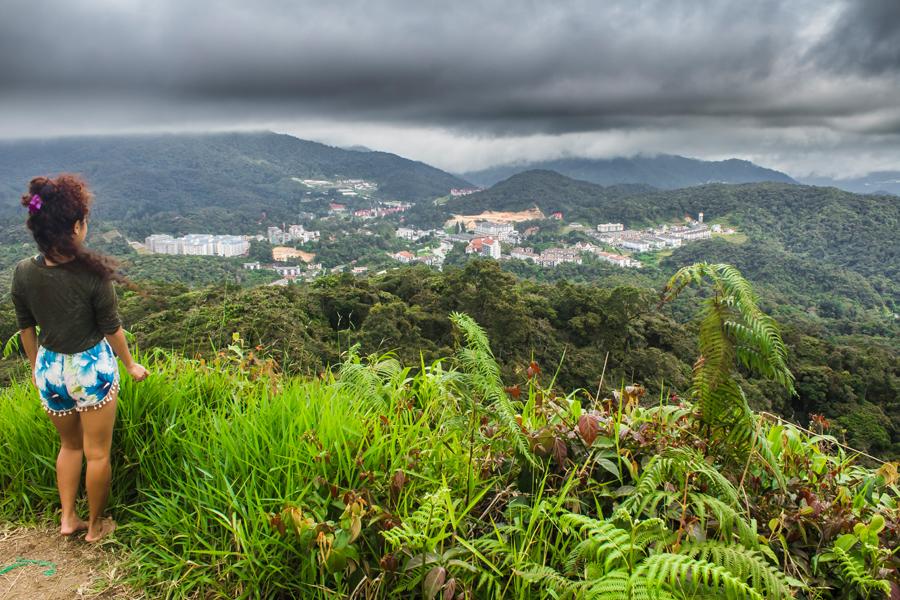
Another short climb uphill and you reach the summit of Gunung Jasar at 1696m above sea level, a bit of an anti-climax since the views are mostly obscured by trees. From the summit, there’s a trail leading south which allegedly brings you to an Orang Asli village.

We took the trail heading to the north, bringing us gradually downhill along a spur through the lush forest and ever closer to Gunung Perdah. To get to the summit of Gunung Perdah, you have to again ascend steeply through the forest until you reach the peak.
We didn’t go directly to the summit itself but instead climbed to another nearby viewpoint, which gave fine unobstructed views of the region’s rolling hills and vast forests that stretched as far as the eye could see.
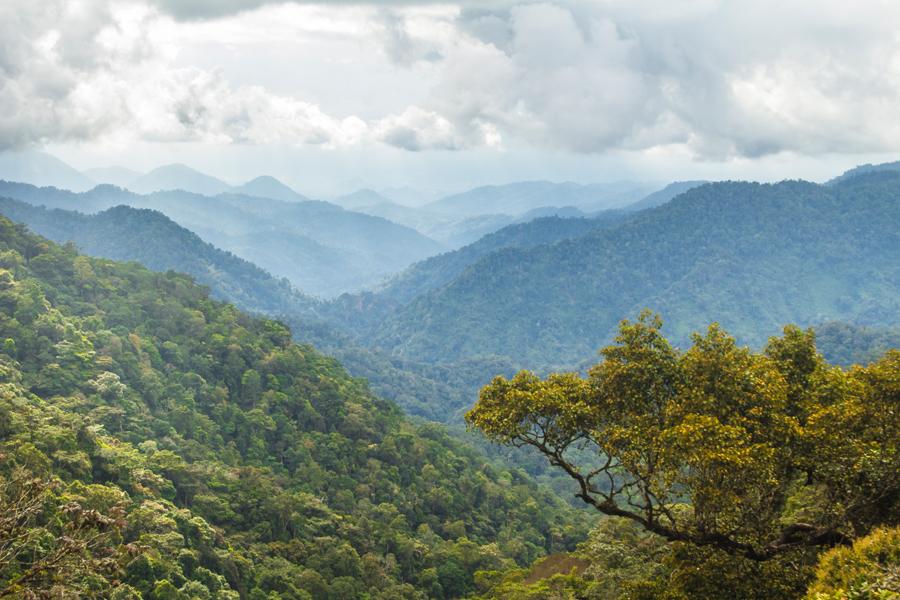
You can find your way down off the hillside here onto a back road next to the big (ugly) weather station. We walked all the way back to Tanah Rata along this quiet back road, delighting in all the bamboo orchids that we saw growing by the roadside.
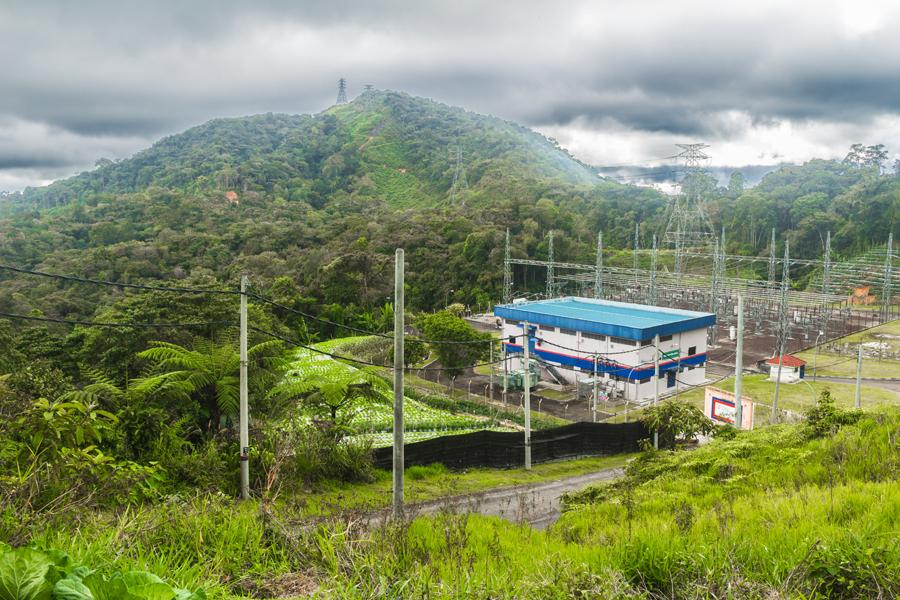
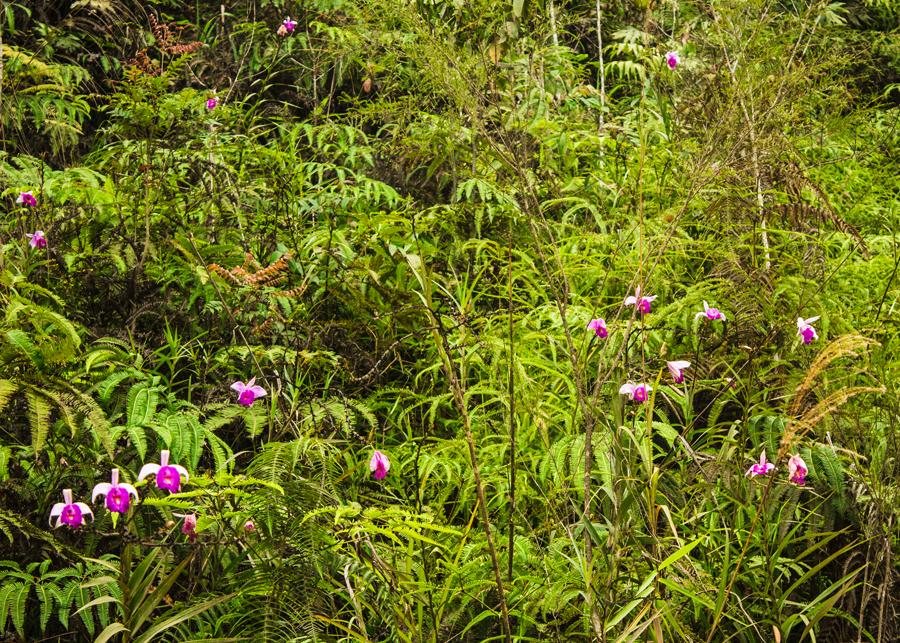
Trail No. 7 to the peak of Gunung Berembun and back to Parit Falls

The trail we advise that you take to Gunung Berembun (1,840 m) is the one that begins several hundred metres to the northeast of the Mardi agro-technology park.
It's worth briefly stopping in Mardi to have a wander around the main exhibition garden where you can find pitcher plants (Nepenthes sp.), tea trees (Melaleuca bracteata) with their aromatic foliage and many other interesting plants. We found these same pitcher plants in the wild, which we talk about later in the article.
There is an open-sided walkway with overhead trellises that are interlaced with the Lady shoes clock vine plant (Thunbergia mysorensis). The flowers of this plant look like a lady's slippers and dangle on long tendrils, conjuring up a somewhat magical little scene.
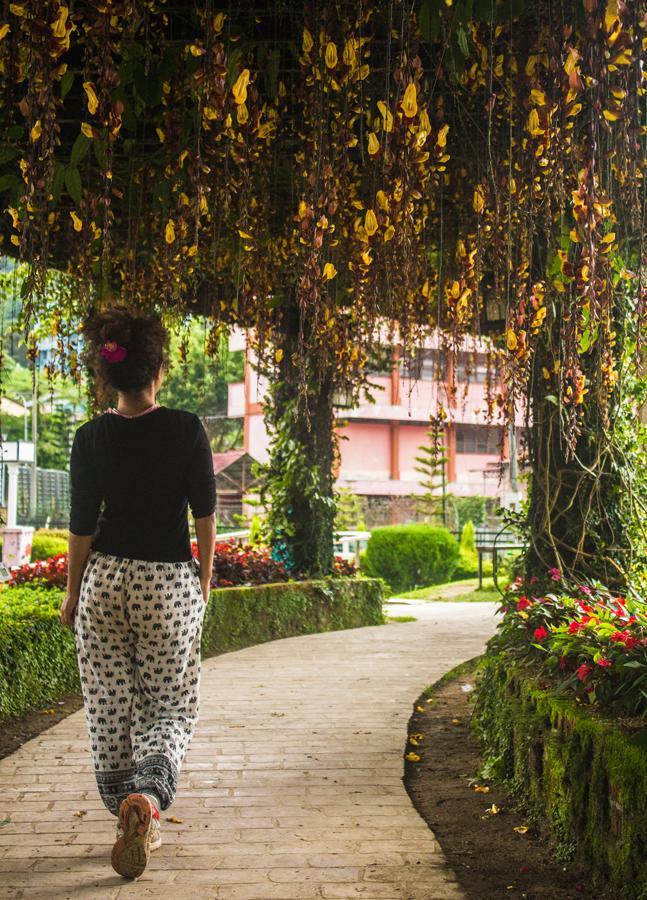
Other flowers on display include red oxalis (Oxalis triangularis), Japanese rose (Portulaca grandiflora), snowland daisy (Chrysanthemum paludosum), snapdragon (Anthirhinum majus), red begonia (Begonia sparreana), mealy sage (Salvia farinaceae), Peony of India (Dahlia sp.), false heather (Cuphia hyssopifolia), foxglove (digitalis sp.) and many others.
Our favourite flowers definitely had to be the snapdragons and foxgloves.
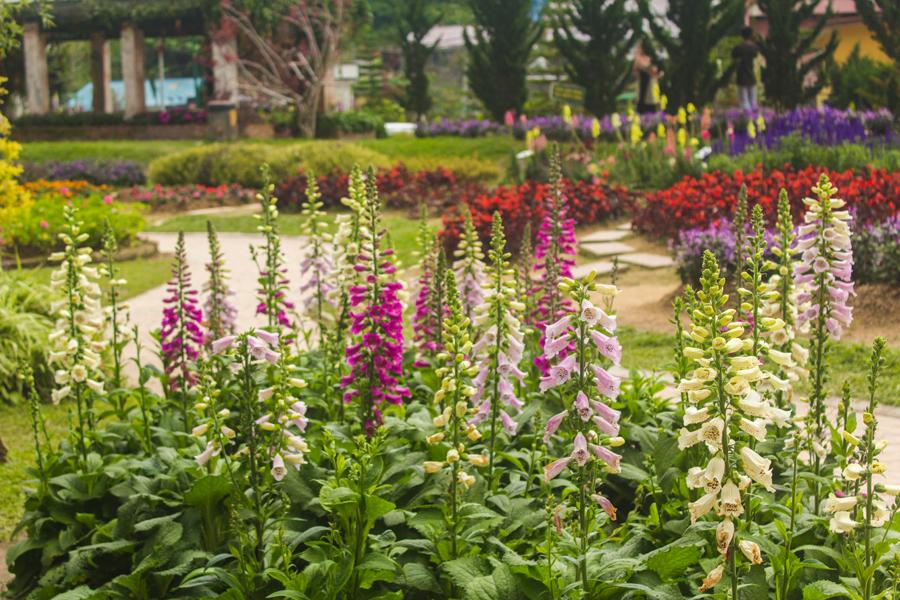

Moving on from Mardi and heading to the northeast, trail no. 7 begins at the side of the road, first taking you into and up through a small plantation of tea bushes and then, rather unexpectedly, passing directly through a strawberry farm.
You might be able to steal a few strawberries here if nobody is looking but be careful; since it's Malaysia, the punishment if caught is probably the death penalty!

After emerging from the strawberry farm, the trail is very overgrown at first, and you might have to crouch and make your way assertively through the encroaching bushes and vegetation.
After this overgrown section, things do improve significantly and then it’s just a good old slog through the forest to the top, remaining reasonably steep for most of the way.

The summit for Gunung Berembun is a real anti-climax as there are virtually no views at all, just a rusting old triangulation marker and sign that are both covered in graffiti.
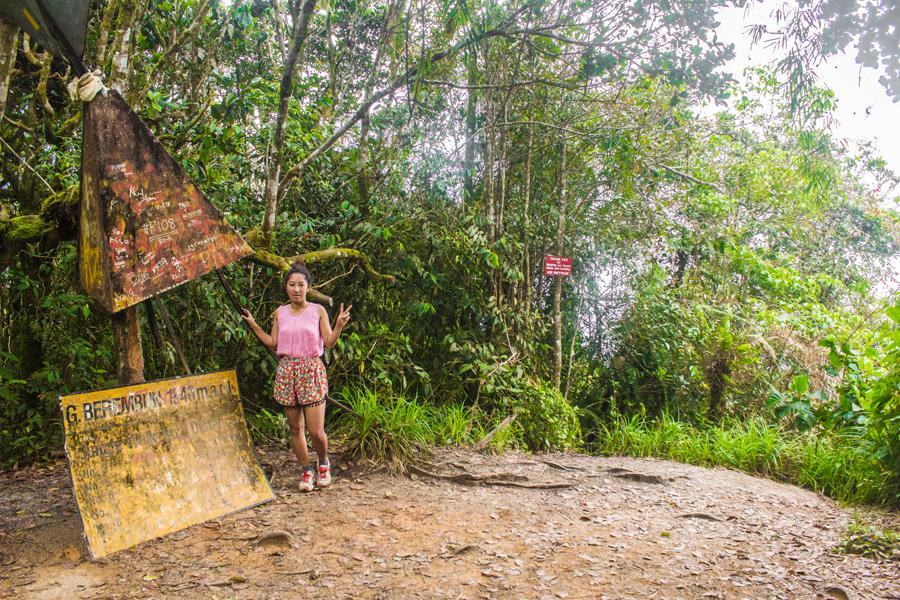
There are several options to get back to the road from the summit. You can continue on through the forest along trail no.3 and then depart from it onto trail no.5, which then takes you back to Mardi. This is probably the quickest way but we opted for a different trail, which brought us all the way back to Parit falls.
This route is where things soon become interesting. We found the undulations in the trail quite challenging, as it would appear to be descending but would then begin climbing steeply back up again, repeating this pattern several times and forcing us to go up and down like a yo-yo.
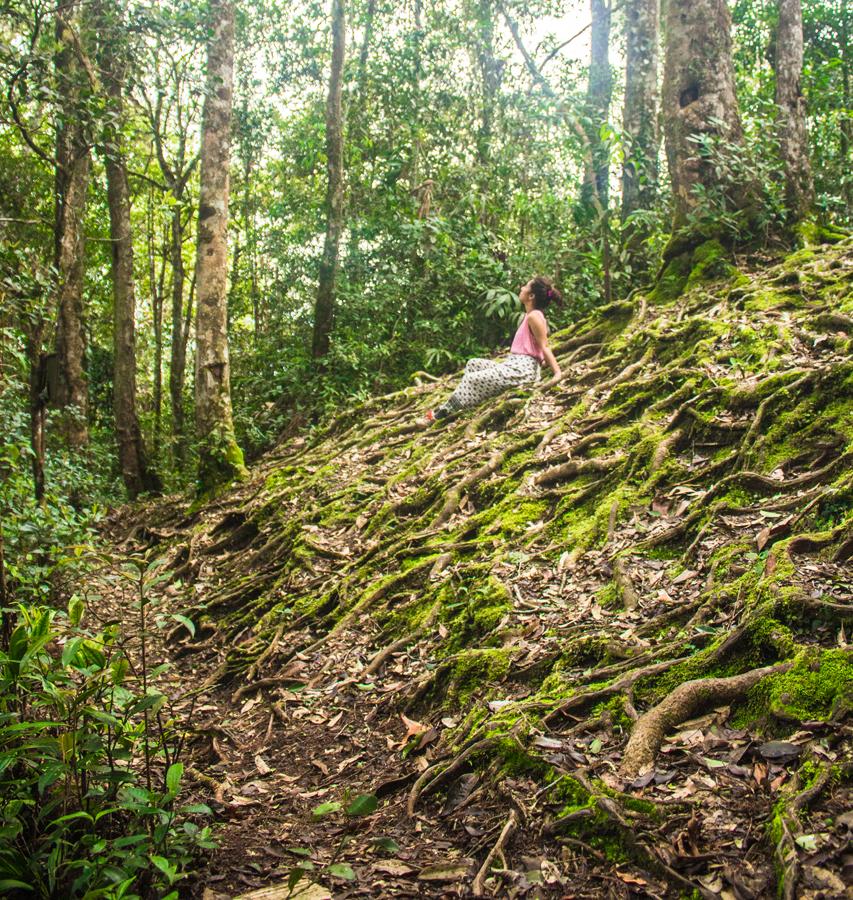
At one point we came to a very enchanting stretch of mossy forest, where we were almost certain for a moment that we had been transported into some kind of fairytale or wonderland, perhaps a scene from Hansel and Gretel.
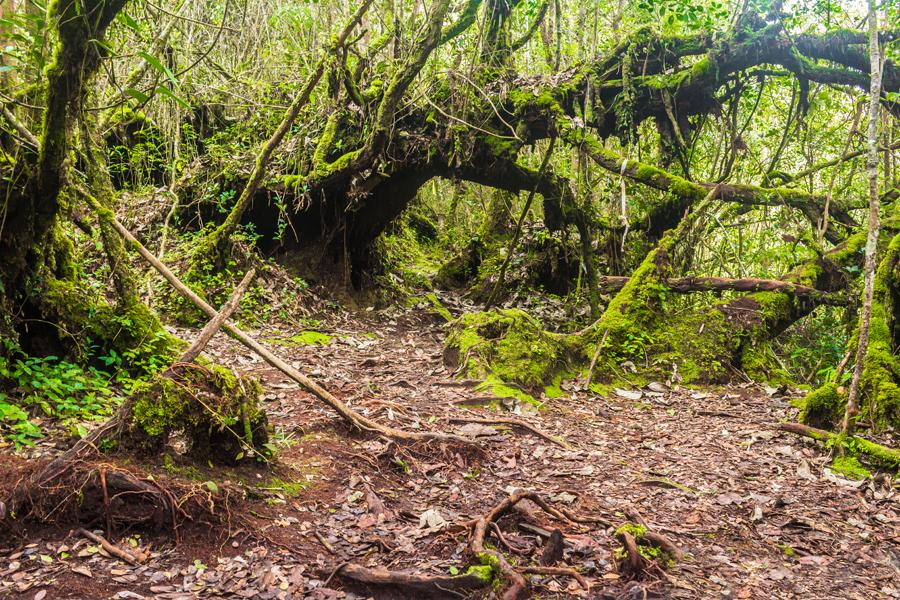
The trail eventually brought us down steeply through a stand of pine trees and we wound up at one of the forest trails near Parit Falls, from where it was easy to walk back out to the main road.

Trail No.1 to Gunung Brinchang (2032m)
This is perhaps the most challenging trail, which takes you from Brinchang up through the steep forest until you reach the summit of Gunung Brinchang (2032m).
To get the trailhead, you have to head about 400m north of Brinchang town and turn left off the main road onto the minor road. It’s now a bit of a walk out this road, past a few tomato farms.
You’ll soon come to a big fork in the road where you should keep to the right.. Shortly after you will see a yellow sign pointing along a dirt track to “Trail No.1 Gunung Brinchang” and you must follow this track to the trailhead.
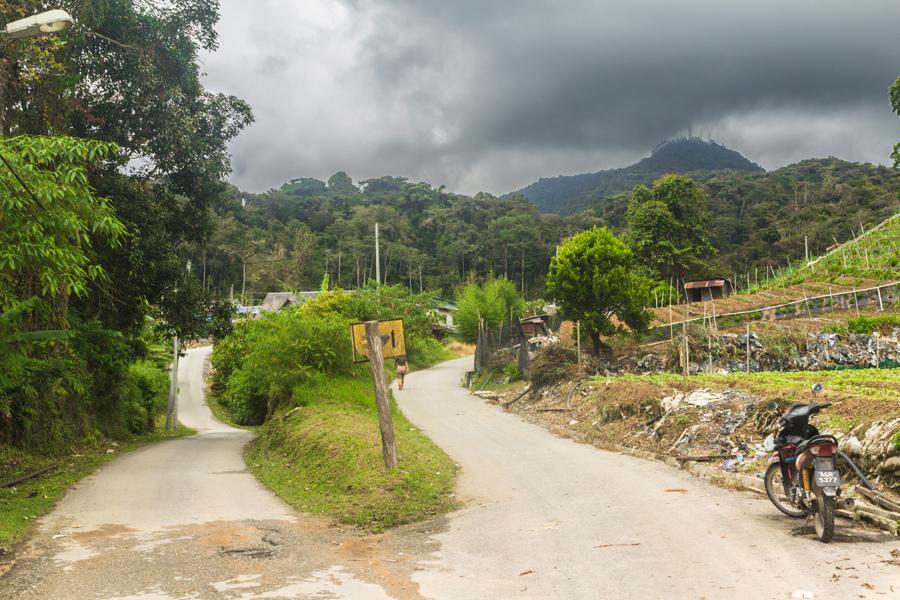
As we neared the trailhead, there was some construction work (destruction) taking place and we first had to clamber over a big downed tree, before encountering a pretty big landslide at the start of the trail.
The landslide had created a steep muddy cliff that we had to climb up by means of a rope just to get up into the forest! It was pretty challenging.
Once inside the forest, the trail was much like all the other trails in the area, although it was particularly muddy and swampy. There was one interesting tree on the trail that was shaped like the inverted letter “Y”.
At one particularly steep and muddy incline crisscrossed by exposed tree roots, ropes were installed to assist hikers, although the ropes weren’t really needed and we found it much easier to scramble up to the top by holding onto the roots.
Once at the top, you’ll run into a fence that surrounds a large restricted area that contains several radio towers. You can follow the trail that runs alongside this fence until it brings you out to the road next to a locked gate and a little gazebo where there's a sign saying you're at the summit.

A bit further on down the road is a 15 m high rusting observation deck, which you can climb to the top of for a very rewarding view of the forest.
A heavy mist will often roll in and out here, alternately obscuring and revealing the view. You can enjoy a peaceful moment here, with the pervasive silence only interrupted by the soothing sounds of birdsong from the trees beneath.

Trail No.4 to Parit Falls
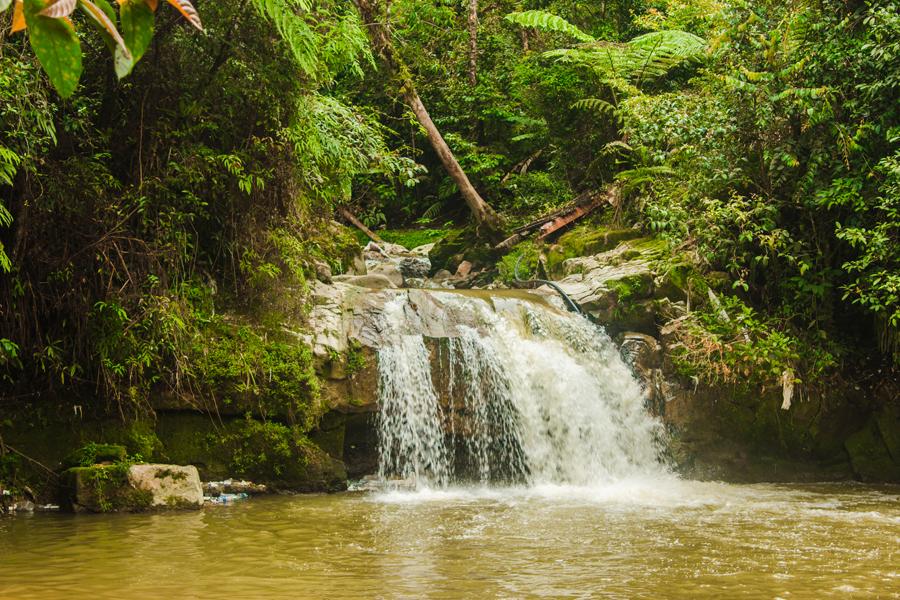
Parit falls is not a place to visit if you’re looking for a beautiful waterfall. You’d need amazing photo editing skills to make this place look appealing. Either that or you'd need to be very selective about what you're photographing.
The word parit actually means “drain” and the site is an eyesore with an ugly mass of rubbish and detritus accumulated in the river downstream of the very modest (tiny) waterfall. The river here is also polluted from agricultural activity upstream.

With that said, the trail leading to the falls and alongside the river is pleasant enough and you can still enjoy the generally peaceful and verdant surroundings on your way to it.
You can easily get to Parit Falls by taking trail no. 4, which can be accessed from Jalan Masjid at the east end of town. The trail first takes you through the forest alongside a stream until you emerge into a large open clearing or park with a number of public benches, pavilions, an exercise station and some palm trees.
Just after emerging into this open clearing, we spotted an amazing troop of russula mushrooms that had popped up the grass. There were pine trees growing nearby and many mushrooms from this genus form symbiotic relationships with the roots of these trees, commonly known as mycorrhizal relationships.

At the other end of this clearing there’s a suspension bridge crossing a river and it’s just upstream from this bridge that the Parit falls is found. Instead of crossing over the bridge, stay on the near side of the river and turn left, walking along the riverside trail until you reach the main viewpoint for the waterfall. Then prepare to be horrified.
Trail no. 9 leading past Robinson falls and on to the hydroelectric power station
This was a walk that we quite enjoyed as virtually the entire hike was either flat or going downhill. You can access the trailhead by walking about 200 metres past Mardi and then taking a right turn off down a side road.
We passed by an interesting abandoned car at the side of this road for which the process of being reclaimed by nature was well underway. At the end of the side road, you’ll have to cross a small bridge over the river and then pass by a row of small cottages.
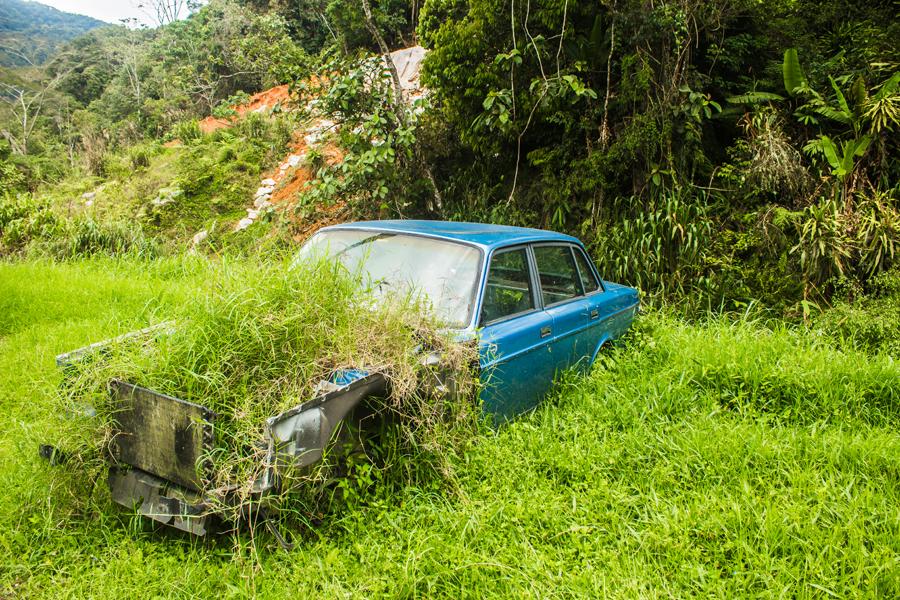
The trail then enters the forest and starts slowly descending, soon bringing you to the fairly impressive Robinson Falls, a waterfall hidden in the jungle that is much larger and significantly more impressive than Parit Falls.
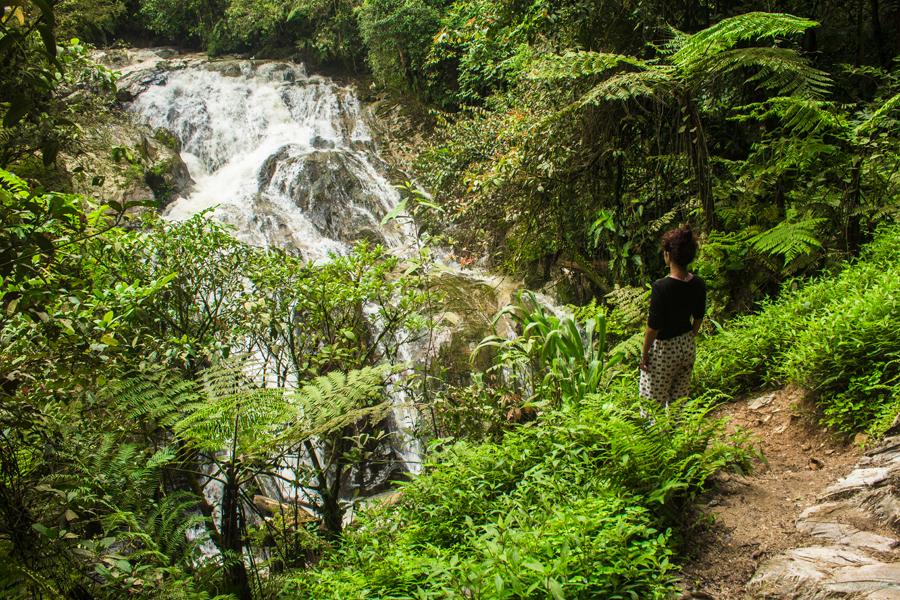
Robinson falls consists of two huge slabs of bare exposed rock divided by a rocky prominence, which has been colonized by trees. One of the waterfalls was completely dried up, without so much as a trickle of water, while the other one bore a raging torrent of tumbling water.
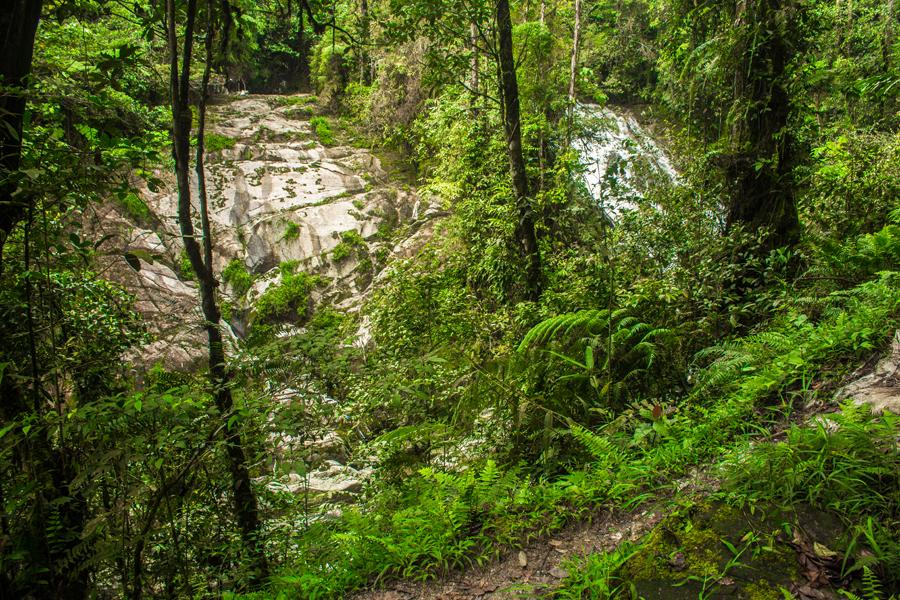
Beyond the waterfall, the trail splits into an option (a) and option (b). Option (a) is longer but descends more gently, eventually delivering you back to the road. We decided to take option (b) – the shorter, steeper and more adventurous trail that would bring us out of the forest at the hydroelectric power station.

From the hydroelectric power station, you just follow the road past pleasant vegetable gardens and small cottages and there’s even a small Chinese temple that you can visit before you finally wind up at Jalan BOH.
If you still have energy left, you can now hitch a ride to the BOH tea garden from here, which is what we did, although we had to wait a little while before we caught a ride.
3. Tour the magnificent tea estates
There are quite a number of tea estates that you could potentially visit in the Cameron Highlands, but you’ll probably have fully satisfied your curiosity after visiting just two or three of them.
All the estates we’ve recommended are free to visit and most also offer free tours of the adjoining tea factories where you can learn more about how the tea-leaves are processed and packaged.
First however, we want to give you a little background information on how the tea leaves are picked in the field by the workers.
Plucking and gathering the tea leaves
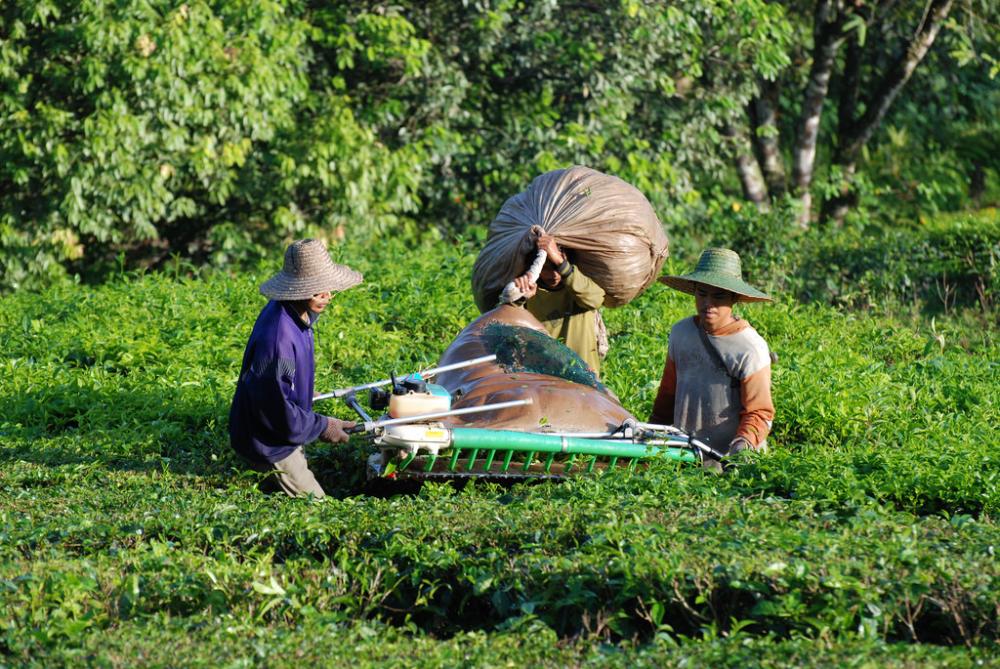
According to the Boh tea company, it all begins by taking carefully selected cuttings of the tea bush (Camellia sinensis), which are disease-resistant and high yielding, with a high density of plucking points.
These cuttings are then nurtured in shaded nurseries for a year, reaching a height of about 46 cm, before being transplanted to the field. Two years later the bushes are ready for plucking.
The plucking of the tea leaves is carried out about once every three weeks when there is a flush of new shoots. The work is done mostly by hand or with hand-operated machinery that improves productivity.
The plantations are predominantly worked by migrant Nepalese or Bangladeshi men of low socioeconomic status. The workers can be best described as slaves to their plantation masters.
They receive very low wages and also have to endure high living expenses, having to pay for all the necessary gear, tools and machinery for the job (except for a basket and a collecting sack) out of their own wages. The workers might only make 800 MYR per month and with the high machinery costs, they barely have enough money leftover to eat.
The migrant workers enter into a three-year labour contract, which is arranged through an agent who charges them an extortionate fee of around 50,000 NPR ($485) for the service.
Their passports are confiscated as soon as they arrive at the airport in Kuala Lumpur. The miserable workers feel imprisoned and are just counting down the days until their contract is up.
A handheld machine operated by two men is the most commonly used machine-based method for plucking the leaves and with this method 300 kilos of leaves can be harvested per man per day, which is 10 times the daily amount that a person could pluck by hand.
These machines are basically modified hedge trimmers with an attached collecting sack that lop the tops of the bushes, but they aren't able to pluck leaves from the sides of the bushes.
On the more inaccessible hill slopes, workers may be equipped with shears and in this case, can each gather about 120 kg per day. If plucking the tea leaves by hand, workers can only collect about 30 kg per day.
When working with shears or plucking the tea leaves by hand, workers collect the leaves in large wicker baskets that have two shoulder straps and are worn like a normal backpack.
In the more accessible lowland tea garden (not in the Cameron Highlands) at Bukit Cheeding where the land is much flatter, vehicular harvesting machinery may be used and can pull in about 9,000 kg per day!
Ziplines are often used to evacuate the baskets of gathered leaves from the hill slopes and at the end of the day’s harvest, the leaves are checked for quality and are packed into sacks before being weighed and then transported to the factory for processing.
Boh tea garden (Habu)
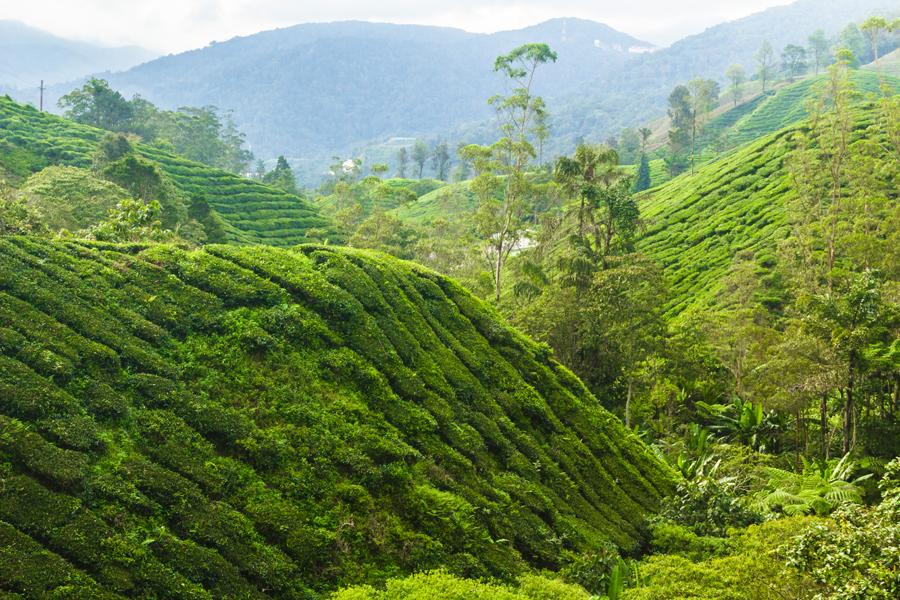
The Boh tea garden near Habu is one of three tea gardens (Boh, Sungai Palas & Fairlie) in the region owned by Boh plantations Sdn Bhd.
It was the first highland tea plantation in the country, originally founded in 1929 during the British colonial era in Malaya, by a British-born businessman called J.A Russell, a man who first moved to the country with his British family as a young 7-year old boy.
The Boh company is now the largest tea producer in Southeast Asia and the most popular tea brand in Malaysia.
In total, the company manages about 1,200 hectares of planted tea and produces about 4 million kilos of tea annually, which translates into about 5.5 million cups per day. This represents about 70% of all tea produced in Malaysia. Each hectare of tea estate can produce about 3000 kgs of tea.
The Boh tea garden is reached by taking a left turn off the main road in Habu, at a point approximately 8.5 km south of Tanah Rata. This relatively quiet winding back-road called Jalan BOH, continues for about 6 km until you reach the estate. The total distance from Tanah Rata is therefore about 14.5 km.
You can also visit the Boh tea estate after hiking trail no.9, which brings you out onto Jalan BOH, at a point on the road that’s about 3 km away from the tea estate. Once you get to the road it’s possible to hitchhike the remaining distance.
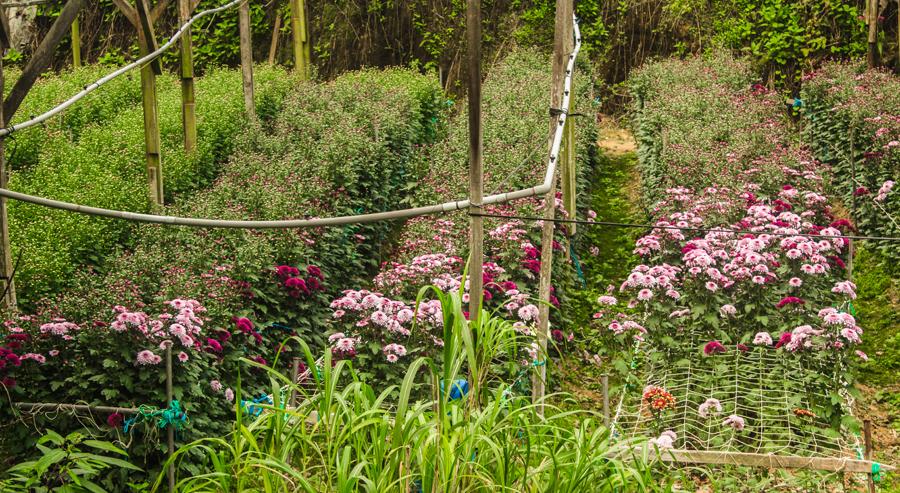
The Boh tea garden is more peaceful and receives fewer tourists than its much more highly publicized counterpart, the Sungai Palas tea garden. As a result, it has retained more of its authenticity and original character.
There’s a nice (but pricey) café here where you can sit outside at a table and eat treats like cakes, pastries and hot English scones with melted butter, whipped cream and strawberry jam.
The café also offers a wide array of different teas, including some more exquisite and pricey varieties. In addition to different types of black tea, you will also find herbal teas, fruit teas and other teas on offer.
Many of the black teas on the menu here are described as “orange pekoe”, “flowery orange pekoe”, “broken pekoe” etc. These are terms that were originally used by the Dutch East India Company to grade black tea in India.
Flowery orange pekoe refers to a whole leaf tea made from the small, slender terminal leaflets at the very tip of the leaf stalk. It is a high grade of tea but several grades below the highest.
Orange pekoe is a whole leaf tea that's one grade below flowery orange pekoe, made from the second (larger) leaflet down the stalk, which lies just below the terminal leaflet.
Broken pekoe is a lower grade of tea, which refers to pekoe leaves (3rd leaflet down the stalk) that have been crushed for bagged tea.
The whole leaf teas need to be steeped for longer as they expose less surface area to the hot water. Broken leaf teas, fannings and dust should be steeped for a shorter period of time. Tea bags usually consist of a mixture of fannings and dust.
You can learn more about tea grades in this useful article.
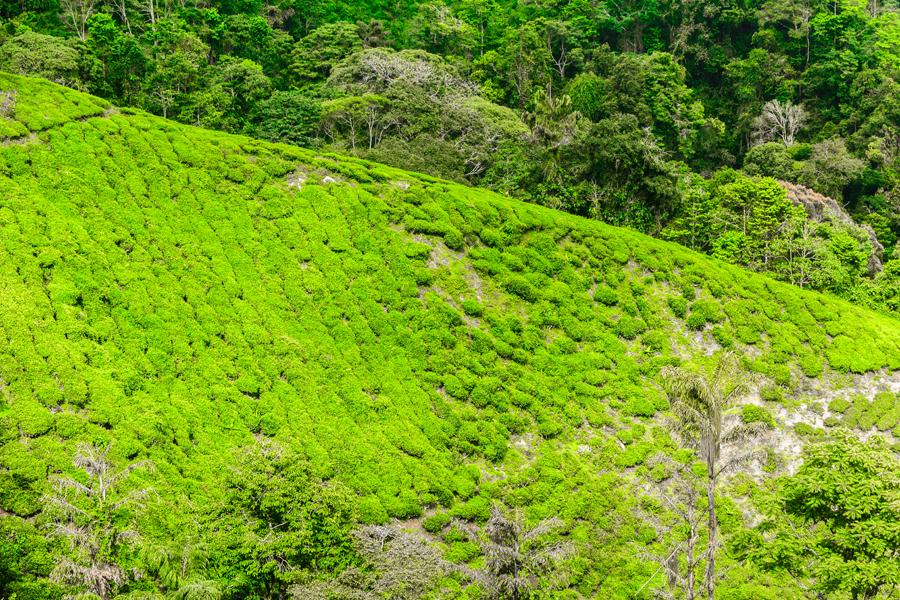
The Boh tea garden also offers free 10-15 minute tours of the adjoining tea-processing factory (located just behind the café), although we unfortunately weren’t able to avail of this because we had visited too late in the day and the tours had stopped running.
If you want to avail of a free tour you'll want to get there early in the day or at least before 4:30 p.m when the factory closes its doors to the public. The café stays open longer however and will still be open after the factory has closed.

The Boh tea garden also has a magnificent viewpoint, weather permitting of course, which you can only get to under your own steam by means of a trail through the tea bushes that leads to the top of a hill.
Once you reach the top of the hill, you’ll find yourself on a grassy plateau fringed with cypress trees and with fine views of the estate on all sides. It’s a great spot to just relax, soak up the panoramic views and perhaps enjoy a little picnic.
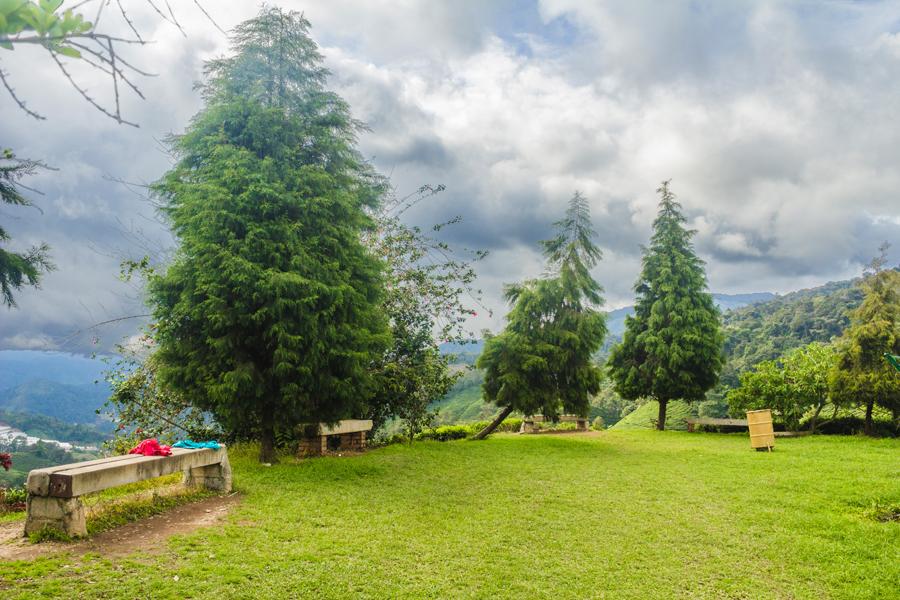
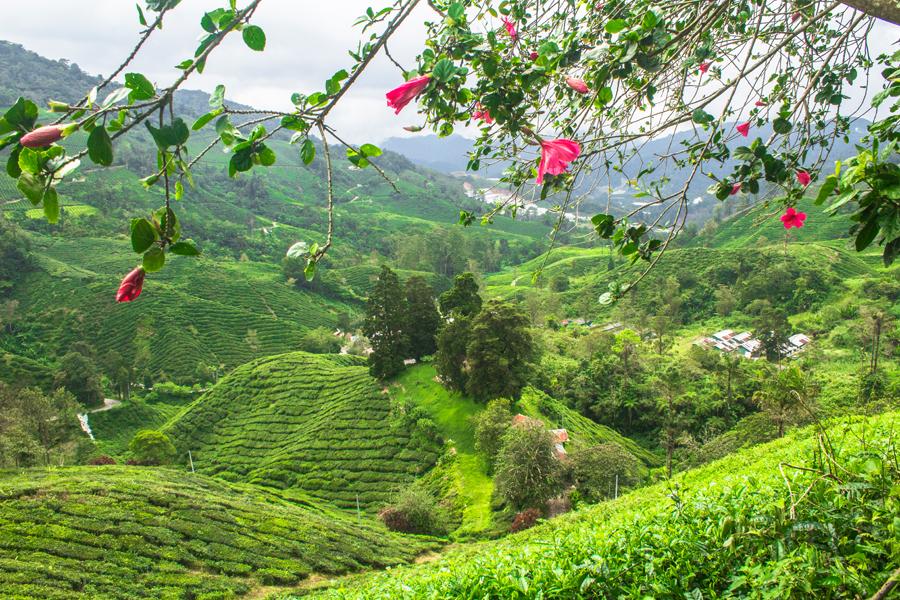
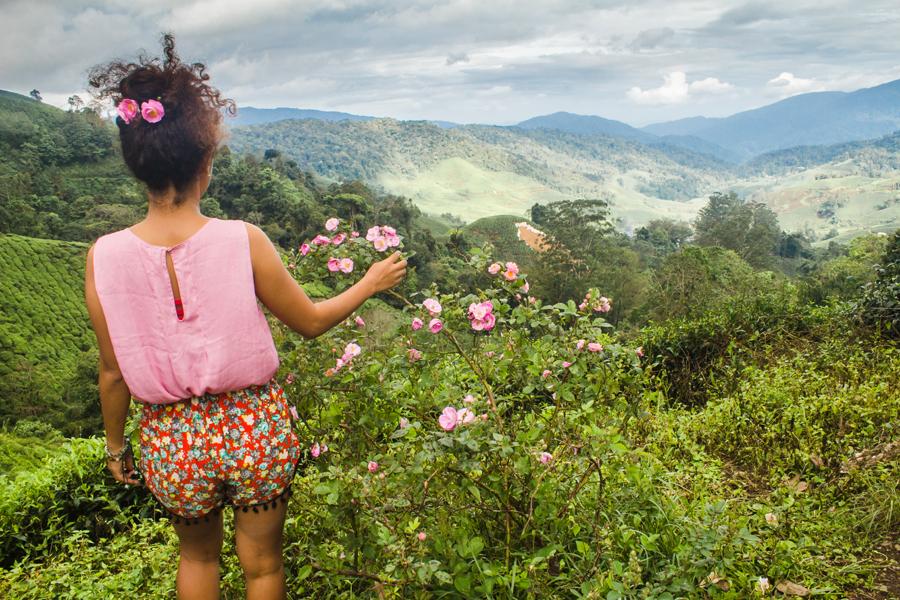
Sungai Palas tea garden
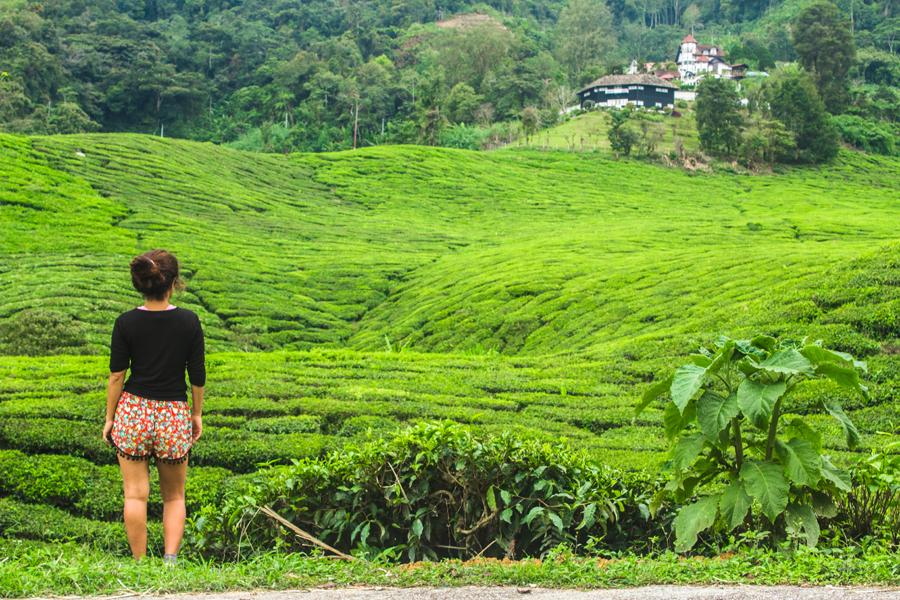
The Sungai Palas Tea Garden is another tea garden owned by the Boh company and is the one that has become the most popular with tourists because of the superior modern facilities that it offers. However this also means that it tends to be overcrowded and swarming with too many visitors.
Directions: The tea garden is found about 8 km northeast of Brinchang, not far from Gunung Brinchang and can be reached by first following route 59 for about 4.6 km and then taking a left turn off the main road near the Ee Feng Gu bee farm. This winding road will then take you into and through the tea estate until you reach the visitor centre about 3.4 km further on.
While the focal point of the estate for most tourists is the visitor centre with its large café, excellent vantage point, exhibition hall and adjacent processing factory, you should also take some time to appreciate some of the amazing viewpoints on the way in.
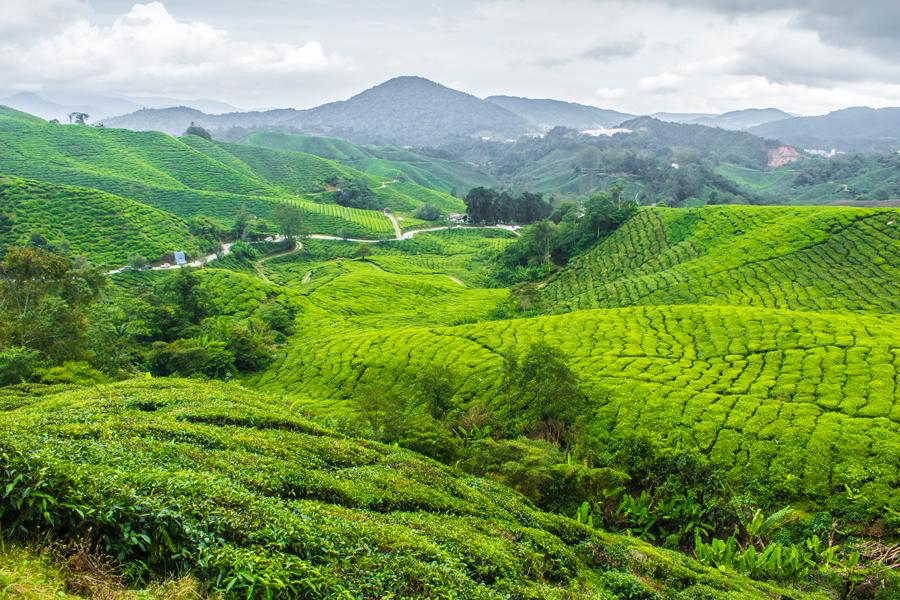
About 1.2km in from the turn off, you’ll pass the Roberston Rose Garden, which specializes in growing the eponymous flower. Many people like to stop here to enjoy the garden and admire the fine views from this vantage point.
You’ll also pass worker housing and a small Hindu temple just before reaching the visitor centre, although this one is only really worth a brief look. In the past, the tea estate was worked by South Indians of the Hindu faith but they have since been mostly replaced by the migrant workers.
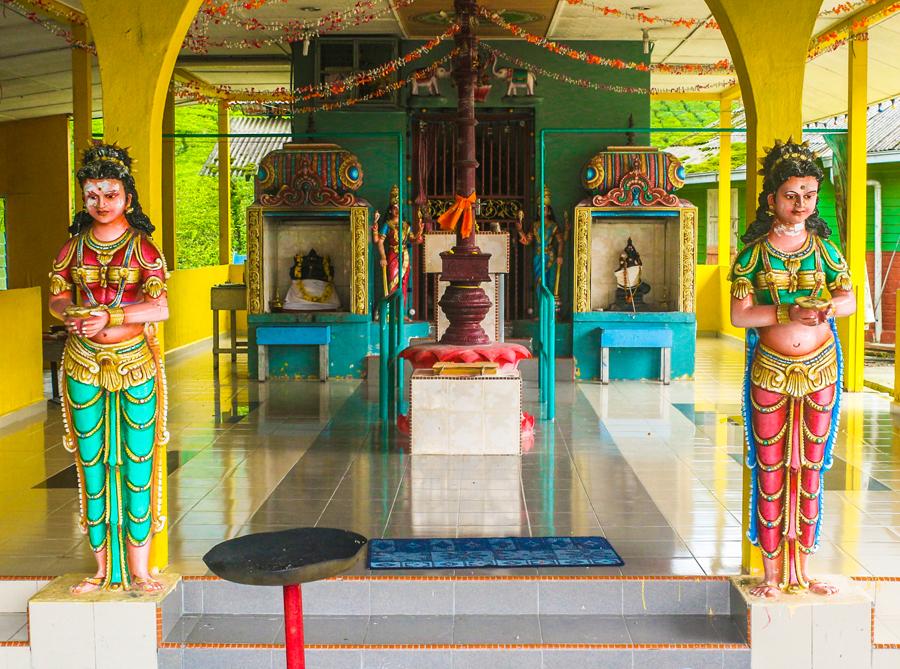
There’s a great viewpoint of the tea estate from the café veranda once you reach the visitor centre. This part of the plantation displays those same undulating hill contours that can also be seen in the Cameron Bharat tea estate.
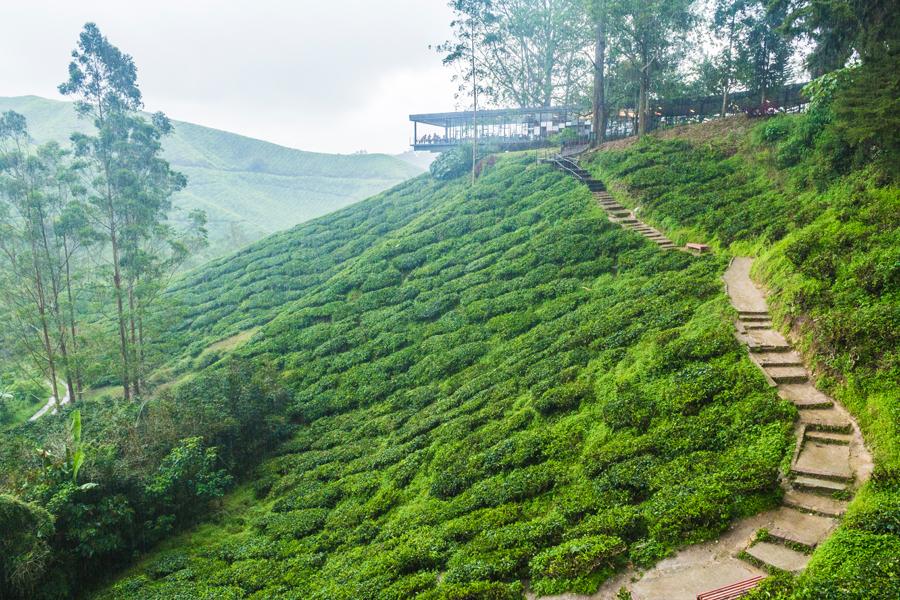

The adjoining exhibition hall has dozens of information boards that give some useful general background information on the climate, ecology and geology of the Cameron Highlands region.
You can also learn about history of the Boh tea company in Malaysia and the entire process that goes on behind the scenes, from the plucking of the tea leaves by the workers in the field, to the final packaged product ready to be bought by the consumer.
The exhibition hall also has some of the tools and machinery on display, including items like tea harvesting shears and machine, a roller machine, an old weighing scales, gunny sacks for gathering the tea leaves and an antique mist-spraying fan that would been used to maintain consistent temperatures and humidity levels inside the factory.
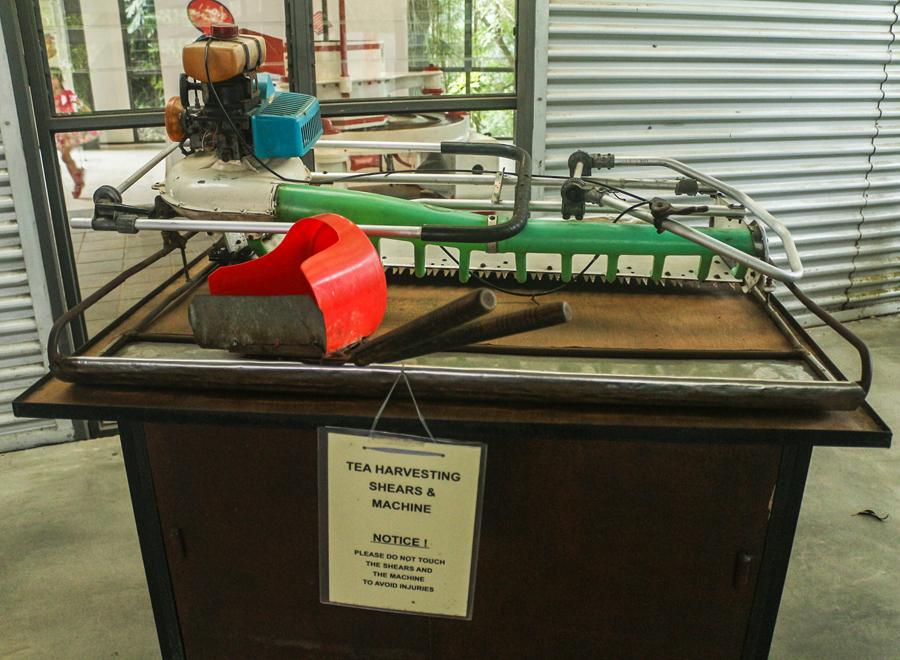


There are also free guided 15-minute tours of the adjacent tea processing factory. You can join them at the visitor centre when they’re taking place.
When we visited there were no guided tours in operation but we were still able to take a self-guided wander through the factory and peer in through the glass at all the machinery in the various rooms.
There were a few information panels on display for each of the rooms that helped us to understand the whole factory processing aspect of the whole tea production process.
The factory process
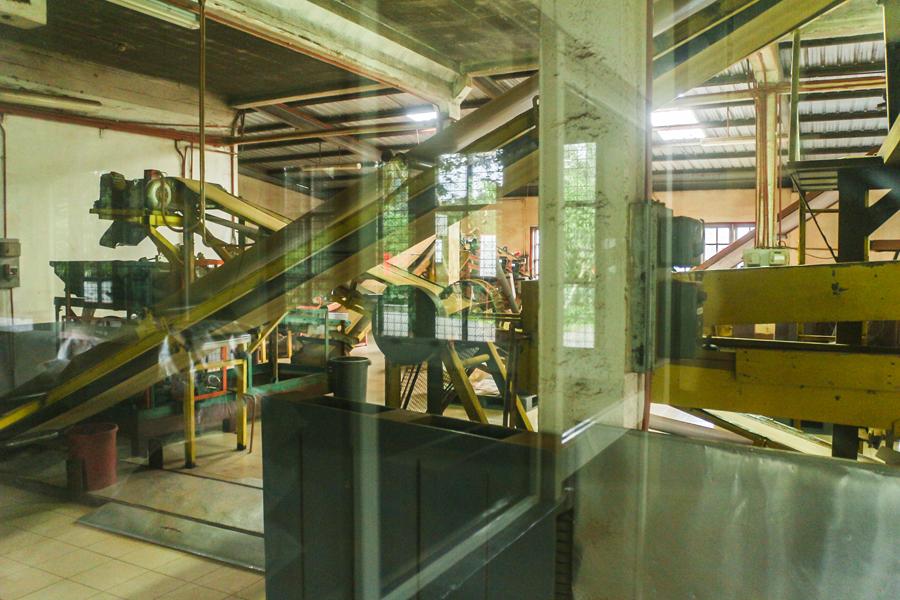
There are six classes of tea (green, yellow, white, oolong, black and Puerh) in existence and the processes used to produced each are not all the same but here we will just be describing the process used by the Boh tea company to manufacture its black tea.
The processing of the leaves must be carried out in a temperature and humidity controlled environment to ensure consistency in the results.
Here are the five main steps:
1. Withering – In the first stage of the process, the idea is to reduce the amount of moisture in the leaf and allow natural chemical reactions to begin taking place in the leaf. The process is usually done overnight and takes 12-20 hours.
The factory uses two methods:
Trough withering – The leaves are spread out in a trough, the base of which has perforated holes, which allow warm air to be passed up through them. The leaves can lose up to 50% of their moisture content during this step.
Bin withering – The leaves are placed inside large bins that are 6ft deep and can hold up to 2 tonnes of leaves. Ambient air is passed through the leaves to prevent them from overheating.
2. Rolling – The withered leaves are twisted and broken, a process with ruptures their internal cells and liberates the juices for the next part of the process. Boh uses three methods for rolling the leaves:
CTC (cut-tear-curl)machine – This machine simultaneously cuts, tears and curls the leaves using interlocking rollers.
Rotovane machine – These machines have huge corkscrews that squeeze and grind the leaf.
Roller machine – This machine uses rolling tables, which imitate the manual hand-rolling action once used to crush the leaf.
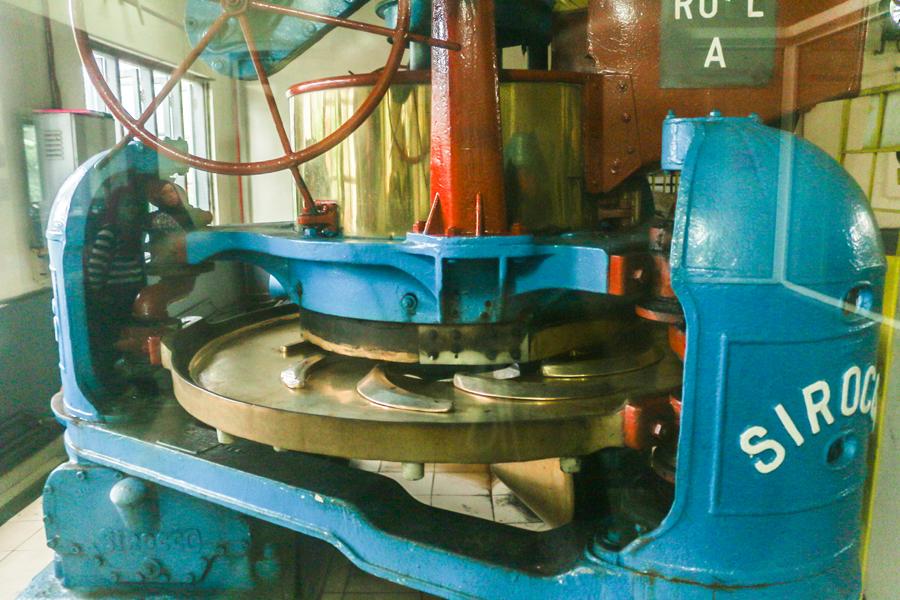
3. Oxidation - The leaves are either laid out in a thin layer onto trays or fed through a series of rotary blades.
Over a period of 1.5 – 2 hours they undergo a natural chemical process often called “fermentation” but which is more correctly referred to as oxidation - the same process that causes the browning of a cut apple or a banana.
The characteristic aroma, body, colour and flavor of black tea is all a result of newly formed chemical compounds in the leaves such as theaflavins and thearubigins, which are the outcome of this complex chemical process.
4. Drying – The leaves are then passed into machines through which hot air is passed at temperatures of around 100°C. The hot air is generated by cleanly burning agricultural by-products such as palm oil shells and the wood from rubber trees in a furnace.
The oxidation process grinds to a halt as a result and the moisture content of the leaves drops below 3%, leaving the leaves black, curly and crispy in the form known as “made tea”. The whole process is completed after about 20 minutes.
5. Sorting – After drying, the “made tea” consists of premium grade leaf of various sizes, along with off-grades, leaf stalks and fibres.
First, the off-grades, stalks and fibres are removed by passing the leaves through a series of machines, leaving behind just the premium grade leaves. The leaves are then sorted according to size so that they can be classified or graded. This is done using a vibroscreen sorter machine.
Here are the four main grades:
Leaf – Tea leaves that are fully intact.
Broken – Tea leaves that are broken
Fannings – Small broken grades
Dust – The lowest grade. Often blended with fannings in tea bags to make the tea steep quicker.
Tasting another important aspect of the whole process to ensure that the tea meets the utmost quality standards before packing. Tea- tasters are specially trained experts who know exactly what to look for when evaluating the tea.
The tea tasters will swill the tea around the palate to gauge its thickness or body and will use their taste buds, gums and inner cheeks to assess its flavor, aroma and astringency.
Packing is the final aspect of the whole process, where the right materials must be used to ensure that the tea retains its freshness and doesn’t absorb moisture from the air.
Aluminium laminate packs, watertight sachets, airtight canisters and heat-sealed cellophane are all used to ensure freshness. All Boh tea is packed at the company’s packing facility in Bukit Cheeding, Selangor.
.jpg)
Cameron Bharat tea estate
This was one tea estate that we didn’t actually get a chance to visit, as we allocated our time to visiting the other two estates instead. We did however get a good look at it from the road several times when driving by.
The Cameron Bharat tea estate is located about 4 km to the south of Tanah Rata right next to route 59 and is the most accessible of all the tea estates in the highlands. It’s the second largest tea producer in the Cameron Highlands.
The estate is owned by the Bharat group, a diversified Malaysian conglomerate with a special focus on tea, although the group is also involved in long-haulage transport, real estate and the oil palm industry.
The group was originally founded by a pioneering immigrant from Uttar Pradesh in northern India, who went by the name of Shuparshad Bansal Agarwal. This was way back in 1933 during the era of the British empire.
Today the group manages more than 1,600 acres of tea gardens and exports tea to more than 30 countries. The group manages another tea garden in the village of Tringkap northeast of Brinchang, but this one receives far fewer visitors.
Originally involved only in wholesale to Malaysian and international brands, the group has also been involved in retail since 1994, with its very own Cameron Valley tea brand, which produces exquisite teas of the finest quality. The branded tea is allegedly produced at the tea garden in Trinkap and not in Cameron Bharat.
It’s perhaps the most photogenic of all the plantations in the region due to the fascinating and unusual contours of the undulating hill slopes, with their sharp and well-defined ridges. The tea bushes gives way to indigenous highland forest at the upper reaches of the hill slopes.
There are two different tea-houses by the main road, an older and a newer one or no.1 and no.2 if you like, which are spaced several hundred metres apart from one another.
Both serve good fresh teas, biscuits, a variety of cakes and hot English scones with melted butter, cream and strawberry jam, although it is all a bit pricey. Their signature tea is the spiced masala tea, which people say is a must-try.
You can also buy souvenirs at both tea-houses and you may be able to watch an audio-visual presentation that describes the entire sequence of events that go into creating that steaming cup of hot tea sitting on the table in front of you.
The older tea-house or the one that you reach first when approaching from the south lies next to a trail that allows you to walk down into the tea estate and immerse yourself in its magnificence. There’s a small (and not so beautiful) waterfall near the bottom of the valley.
The newer tea-house, marked on Google Maps as Cameron Valley Tea House 2, has a larger car park to cater to tourists arriving by car during busy times such as holidays and weekends.
Both tea houses have great vantage points where you can get that picture-perfect postcard shot of the undulating tea-bush clad hill slopes.
4. Pay a visit to the most important temples
There are many different kinds of places of worship in the Cameron Highlands, including South Indian Hindu temples, Chinese Buddhist temples, Sikh gurdwaras, Methodist churches and small Chinese shrines that consist of just a single tiny room with an altar and a few decorative objects.
While you will probably incidentally encounter a few temples while going about other activities, the temples we've detailed in this section are the most important ones in the region and the ones that are worth a visit in themselves.
Sri Thendayathapani Swami hindu temple
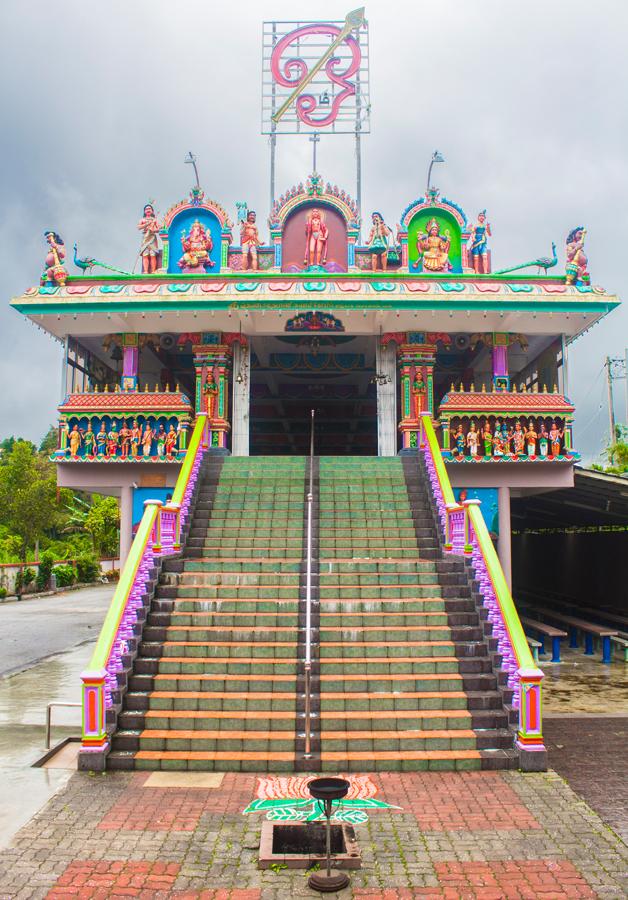
There are a few different Hindu temples in the Cameron Highlands, but we feel that this is the best one to visit, as it’s both visually appealing and conveniently located very near the Sam Poh temple, meaning that you can easily kill two birds with the one stone.
Directions: You can’t miss it as it’s located right next to the main road just before you enter Brinchang town from the south, right before you come to Hotel Titiwangsa.
.jpg)
This Hindu temple was built by the early Indian settlers of the Cameron Highlands and is devoted to Murugan, the Hindu God of war, who is one of the three sons of Lord Shiva (Ganesha & Ayyapan are the other two).
Before you walk up the steps and enter the prayer hall of the temple, first take some time to admire the garish statues in the courtyard below.
There is a star-shaped pond over to your left hand-side with the statue of a dolphin acting as a waterspout. In the centre of the pond is Lord Brahma, the God of creation, perched on a lotus flower. Six Indian women exhibiting various poses surround Brahma, with one placed at each point of the star.

To your right hand side is a lurid depiction of the sun god Surya, who rides across the heavens in his chariot pulled by seven horses. You can see the representation of the sun directly behind his head.
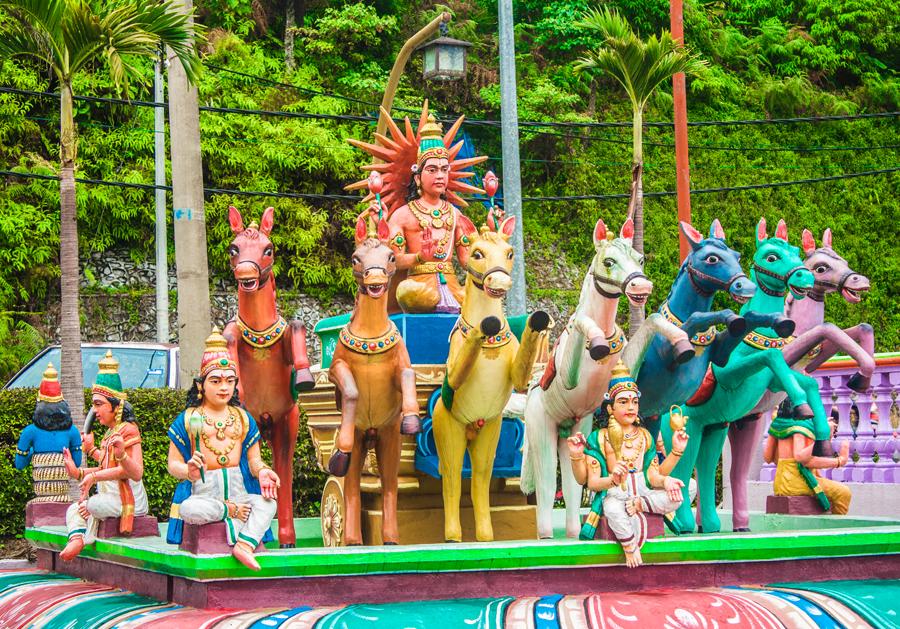
The interior prayer hall is very colourful and photogenic. Eight ornately decorated purple octagonal pillars support the ceiling and their reflection can be seen in the polished mirror-like floor.
Chandeliers hang from the centres of beautiful ceiling paintings. Even the faces of the ceiling beams are painted with decorative curtain-esque patterns.
At the end of the hall are three sacred chambers housing various Hindu idols and deities, but they were all locked up during our visit.
A walkway enclosed between steel railings has been installed for the most important central chamber. This is the inner sanctum of the temple, where the main idol is kept.
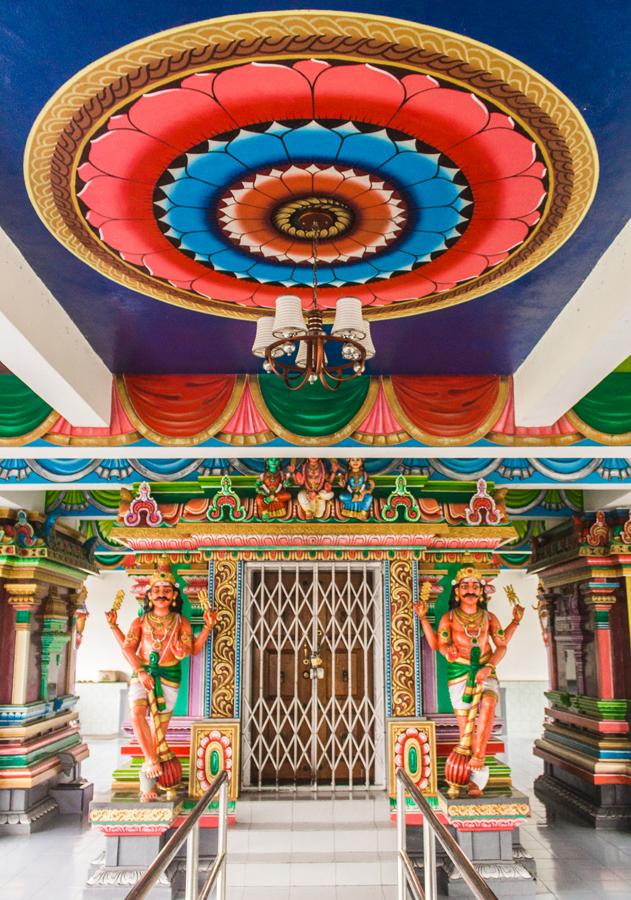
Perhaps the most interesting feature of the temple is the altar just next to the walkway. Here on the altar there are three different vessels, each filled with a different coloured powder. A wooden stick lies on the table next to the vessels in the tip of the stick is coated in some of the red powder.
The red powder is kumkum or vermilion, the white powder is vibhuti or sacred ash (various possible sources) and the brown powder is sandalwood. But what are these powders used for?
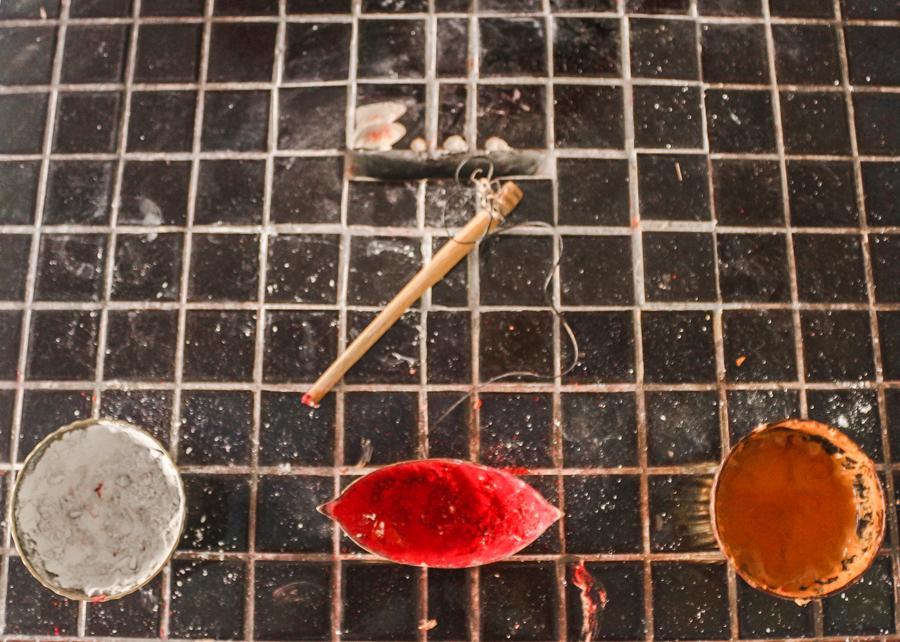
Most of the South Indians that settled in Malaysia were of the Saivite Hindu tradition (Shiva worshipping) and their particular ritual was to mark their foreheads with three horizontal lines of white vibhuti (ash) and a bindu of sandalwood or dot of kumkum in the middle of the three lines.
Marks like these vary across the different Hindu traditions and are generally known as tilakas. The Saivite tilaka that we’ve just described is known as the tripundra (three marks). The three marks have great symbolic significance in Hinduism.
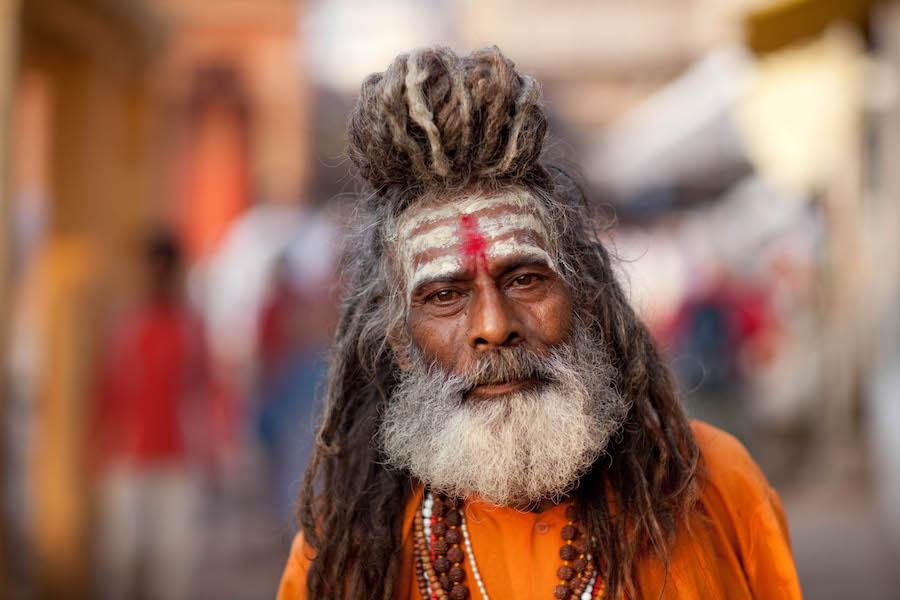
Just next to this altar is another interesting feature of the temple, a depiction of a peacock straddling a snake within a yoni. The peacock also appears to have another snake part in its mouth.
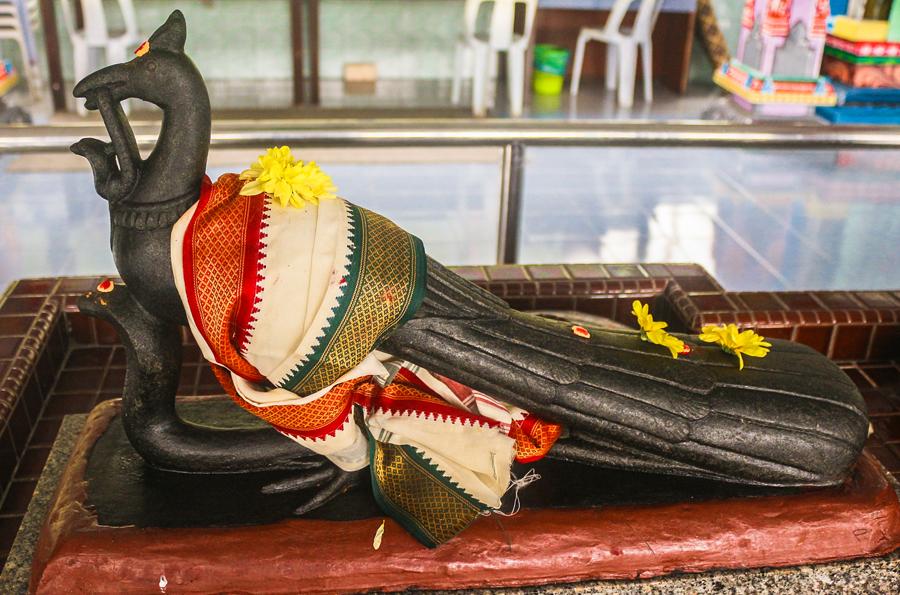
The explanation?
The connection between the peacock and the snake is that peacocks are known to be one of the many natural predators of snakes in the wild. The birds have been known to stalk and kill cobras and many other types of snakes. Here is a video that captured peacocks attacking a snake.
The connection between the peacock and the temple is that Lord Murugan, the god of war to whom the temple is devoted, uses a peacock as his vehicle or vahana to ride into battle with. The term vahana literally means "that which pulls" and most Hindu deities have one.
Sam Poh Chinese buddhist temple
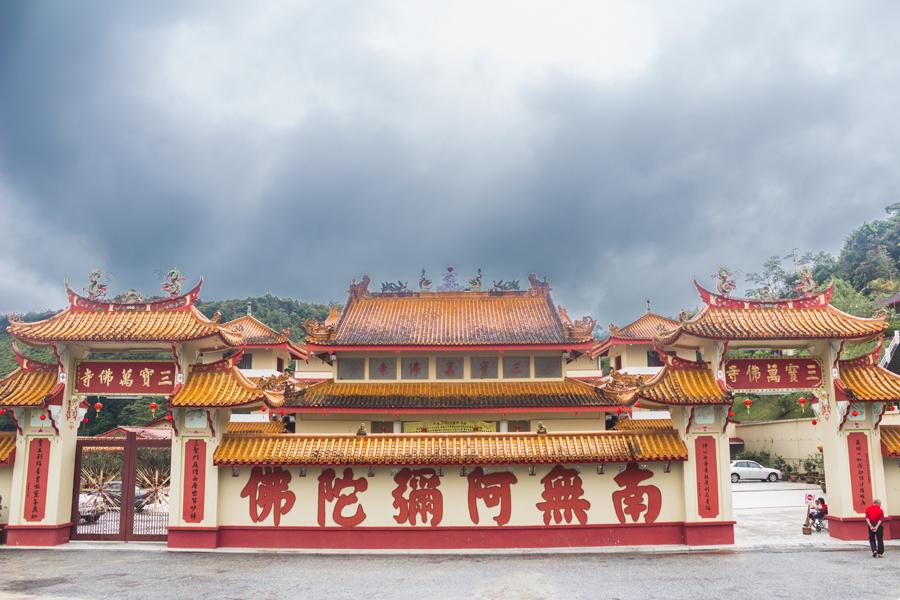
Built in 1972, the Sam Poh temple is a colossal Chinese Buddhist temple situated on a hilltop overlooking the town of Brinchang. It’s the biggest temple in the Cameron Highlands and allegedly the 4th largest temple in all of Malaysia, making it a worthwhile one to visit.
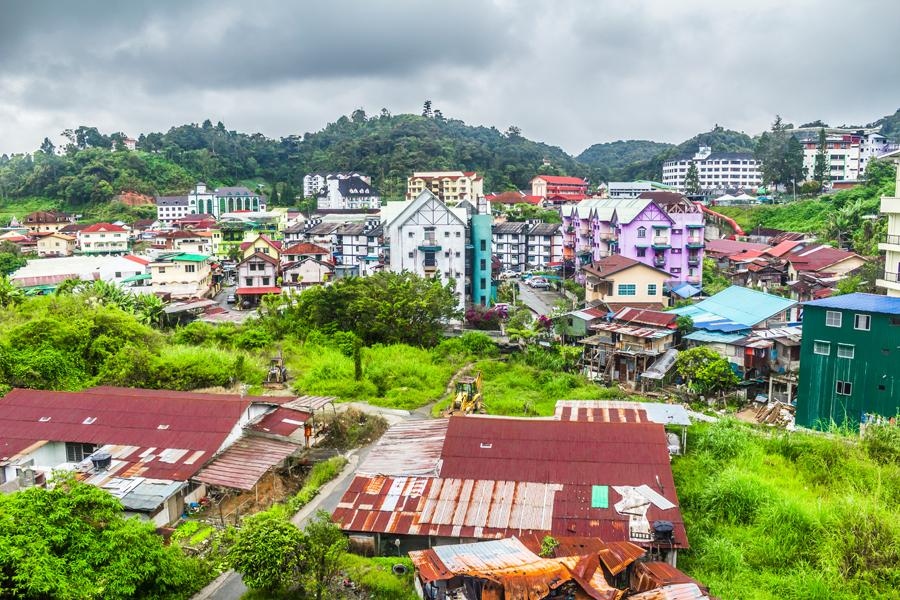
Directions: To get there, turn right off the main road down Jalan Pecah Batu as you’re entering Brinchang town from the south. The temple is only a few hundred metres out this road and the road takes you the way up to the top of the hill.
The first thing that will probably strike you about the temple is the magnificent looking outer boundary wall, sporting six painted Chinese symbols and the two beautiful ornamental Chinese gateways, known as paifang.
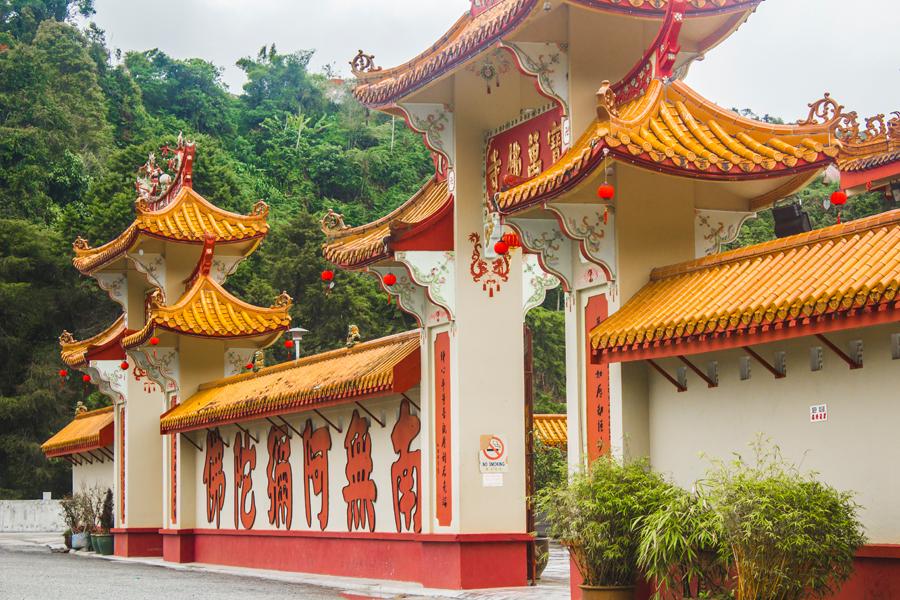

Passing through one of the gateways, you’ll find yourself standing in a courtyard before the main entrance to the temple, which is guarded by two rather comical looking lion guardian statues.
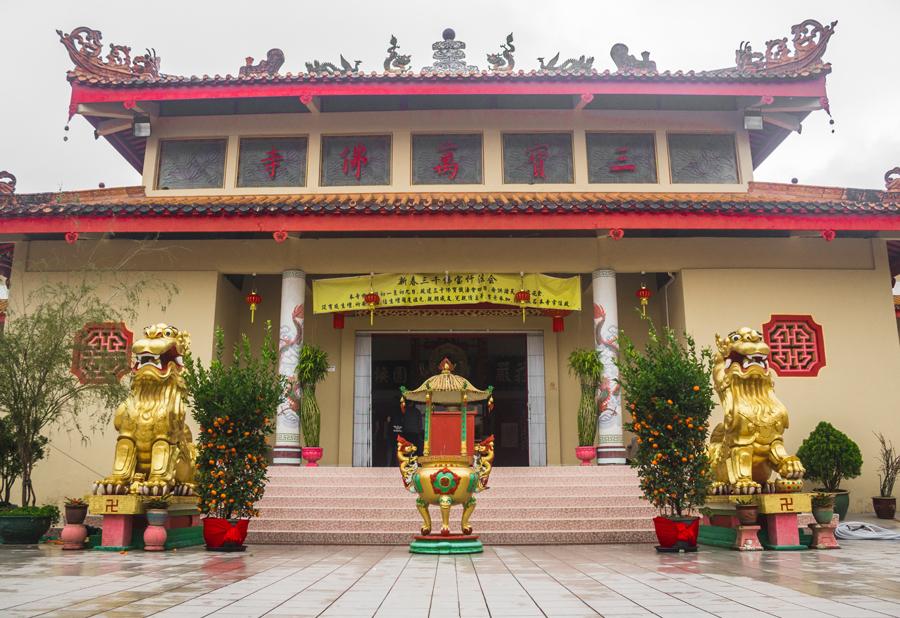
Inside the first room is a centrally located gilded Chinese Buddha statue enshrined within a glass case, along with four other much larger statues - two on each side of the room, situated on raised galleries against the wall. These four larger statues are the western, northern, eastern and southern Dharma protectors.

The word “Dharma” is a Sanskrit word that defies all attempts at translation into English, but it can be loosely translated as the standards of conduct or rules of behavior that humans should adhere to as a member of a community. You can also view the word as synonymous with the “righteous path”.
Dharma protectors therefore protect the practitioners of Buddhism from any interference or negative influences that might derail the practitioner from his true path.
Here is what is written on the placards for the statues:
Western Dharma Protector - The Western Dharma Protector holds a dragon or snake symbolizing change. Today, everything is constantly changing, only when we can see the truth will be able to interact with ease and serenity.
Another hand holding pearl represents unchangeability, teaching people to respond with unchangeability in the face of change and uncertainty, finding the principle of unchangeability in change and uncertainty, having one’s own independence in one’s heart.
Eastern Dharma Protector – The Eastern Dharma Protector is in charge of managing the Nation and holds a lute, which symbolizes the principle that we need to refrain from acting with undue haste, but should keep to the middle path. This is like playing a lute; if the strings are too loose, it will not play, if they are too tight, they will break.
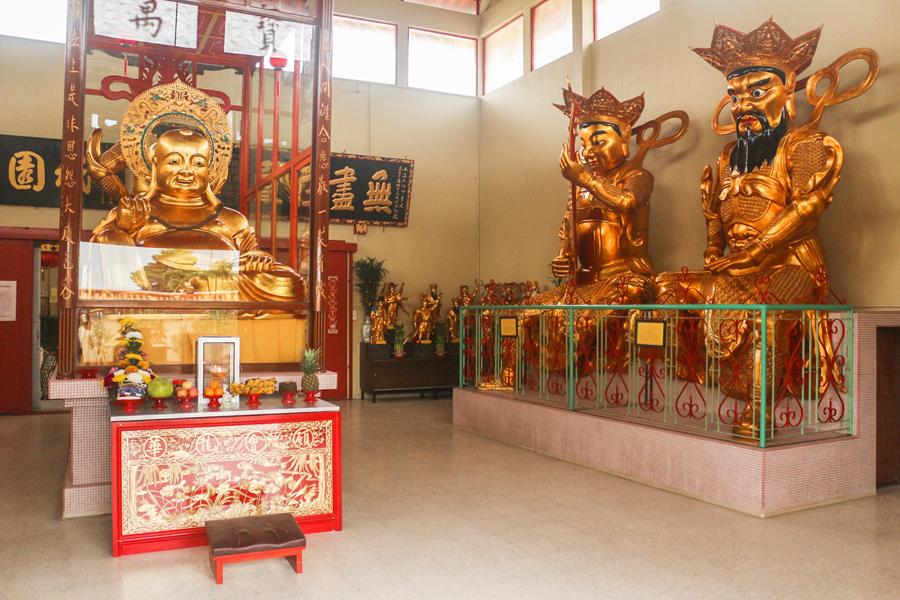
Northern Dharma Protector – The Northern Dharma Protector holds an umbrella symbolizing protection from all the pollution that is around us. While learning, we need to safeguard our pure mind and quiet heart from becoming polluted.
Southern Dharma Protector – The Southern Dharma Protector of growth holds the sword of wisdom that cuts away all troubles and worries. He emphasizes the importance of constantly cultivating and advancing our virtue, wisdom and knowledge and to improve performance in ourselves and our duties.
Exiting from this room out the back door, you will enter an enclosed inner courtyard and crossing over to the other side of this courtyard, you will enter the main prayer hall of the temple.
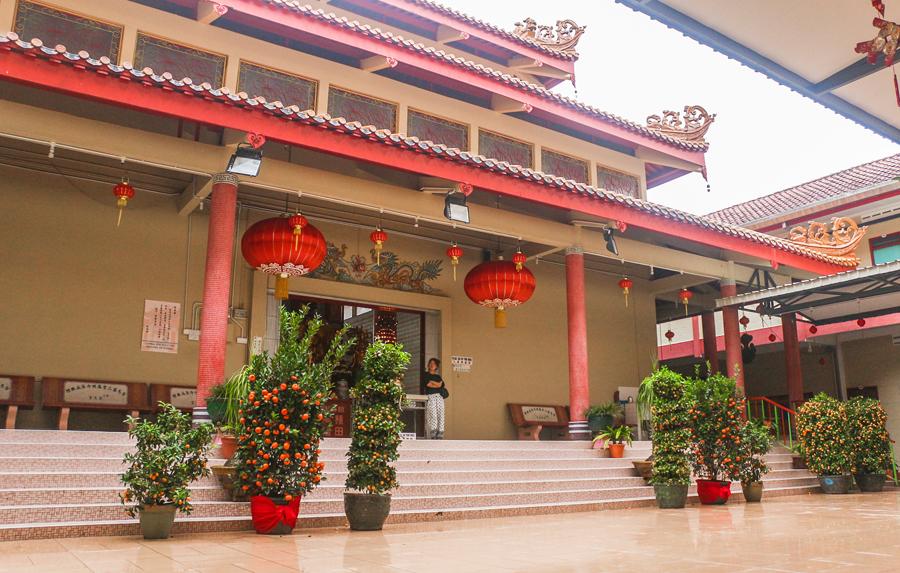
At the back of the main prayer hall on a raised platform is a very large, seated Vairocana Buddha image. The eyes are closed and the hands joined with the two index fingers touching at the tips to form a triangle.
There are two secondary statues to the left and right of the main statue and directly in front are three smaller seated Buddha images made from white marble. An altar is positioned directly in front of all the statues and is decorated with bowls full of various fruits, burning candles, vases and other decorative objects.
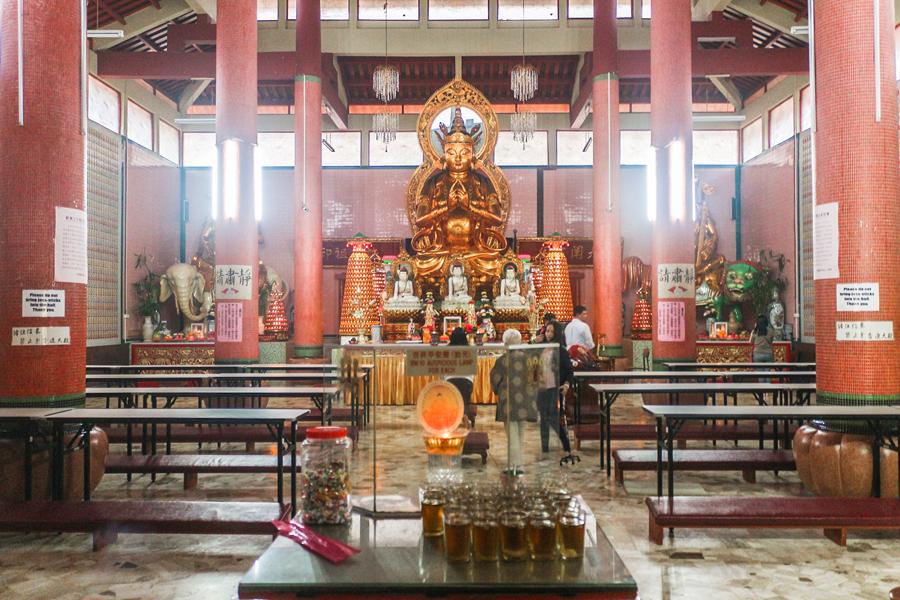
On the two side lateral walls, you can view the splendid tilework, where there must be thousands of tiles with each one depicting an identical image of the seated Buddha. Because of these tiled walls the temple is also often referred to as the temple of 10,000 Buddhas.
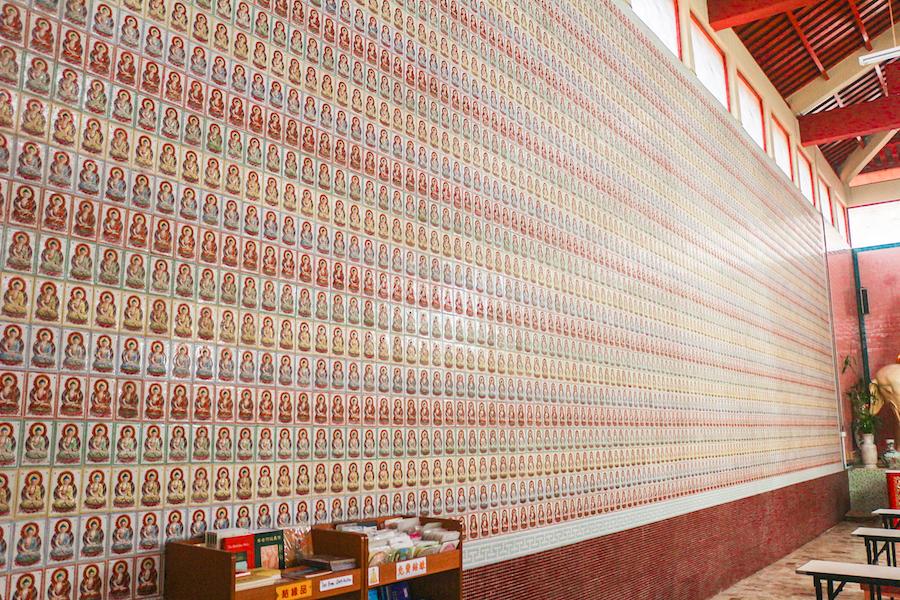
The Buddha illustrations are fundamentally the same in each horizontal row of tiles, with only the hue of the Buddha’s attire changing from row to row. The repeating colour pattern of the rows is red – blue – yellow – green, if moving from bottom to top.
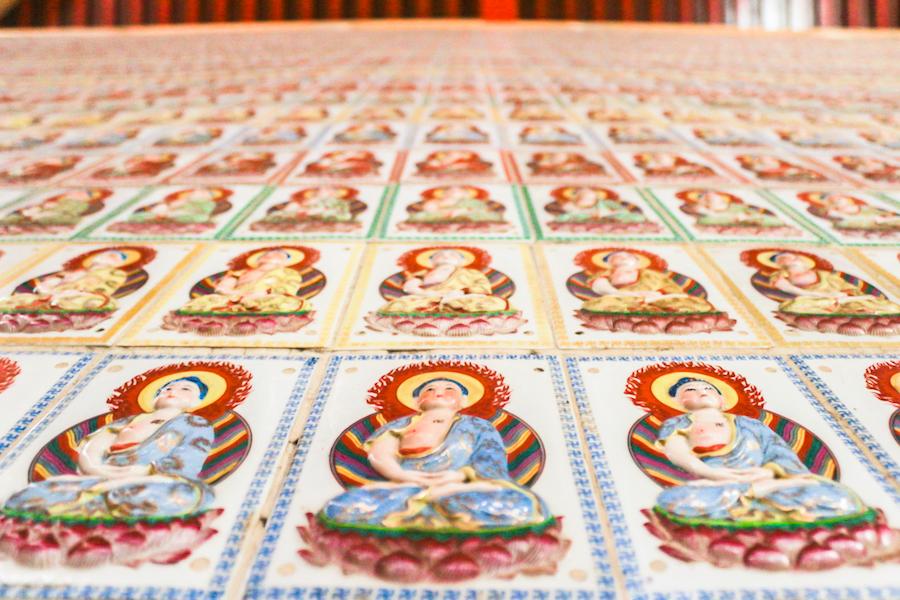
There are also two revolving conical-shaped contraptions on either side of the main altar; viewed up close these are pockmarked with hundreds of tiny recessed niches that contain Buddha images inside. Perhaps they are some kind of prayer wheel.
Beyond the main prayer hall, there is yet another small praying room with more gilded statues of Chinese gods enshrined inside glass cases and a large donation box in the middle of the room.
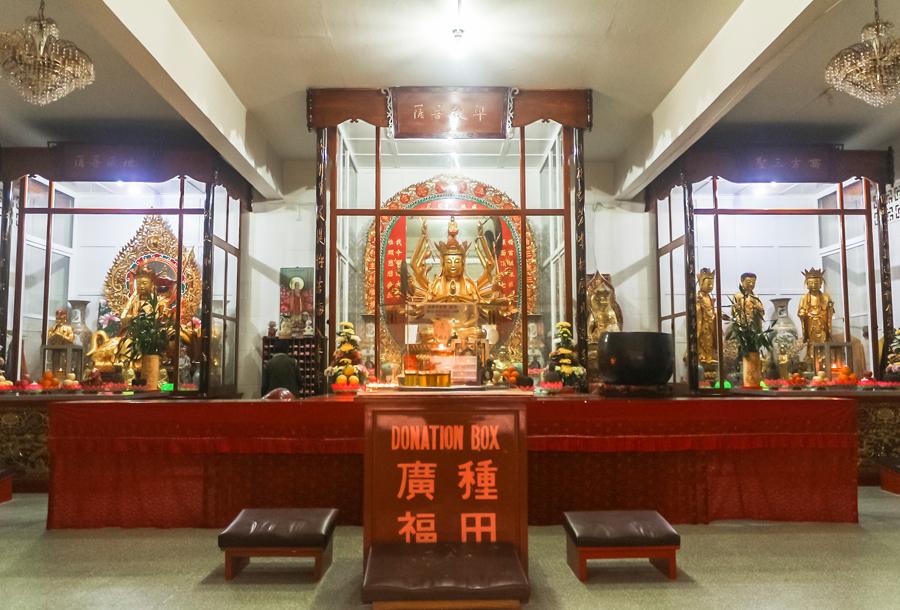
Other temples
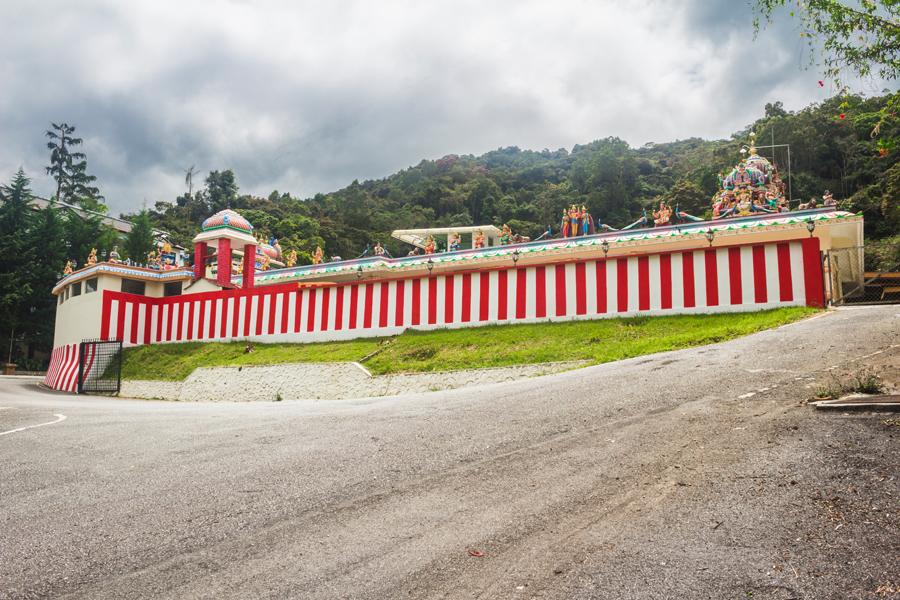
We also investigated another Hindu temple in Tanah Rata, found as you head out along the Persiaran Dayang Indah road towards Mardi, the agro-technology park.
Just before reaching Mardi, a right turn off the main road will bring you up to the top of a small hill where the temple sits. Unfortunately, the temple was all locked up during our visit so all we could observe was the exterior.
5. Discover the Brinchang night market

The Brinchang night market or “pasar malam” is normally held on Fridays and Saturdays, kicking off in the early evening and remaining open until late at night.
The location has changed several times over the years, but during our visit in 2017, it was located just a few hundred metres north of Brinchang town centre on the left-hand side of the road if you’re heading north. It’s hard to miss with the dozens of temporary stalls.
The Brinchang night market is as much a place where you can indulge your taste buds with delicious food cooked by hawkers as it is a place where you can buy gaudy tourist souvenirs, useless trinkets, imported goods and local produce.
As regards some of the goods on offer, there are chocolate-coated strawberries skewered on sticks, boxes of ordinary strawberries, jars of honey, small tubes of honey, honeycombs skewered on sticks and strawberry dadih (yoghurt pudding made from fermented buffalo milk).
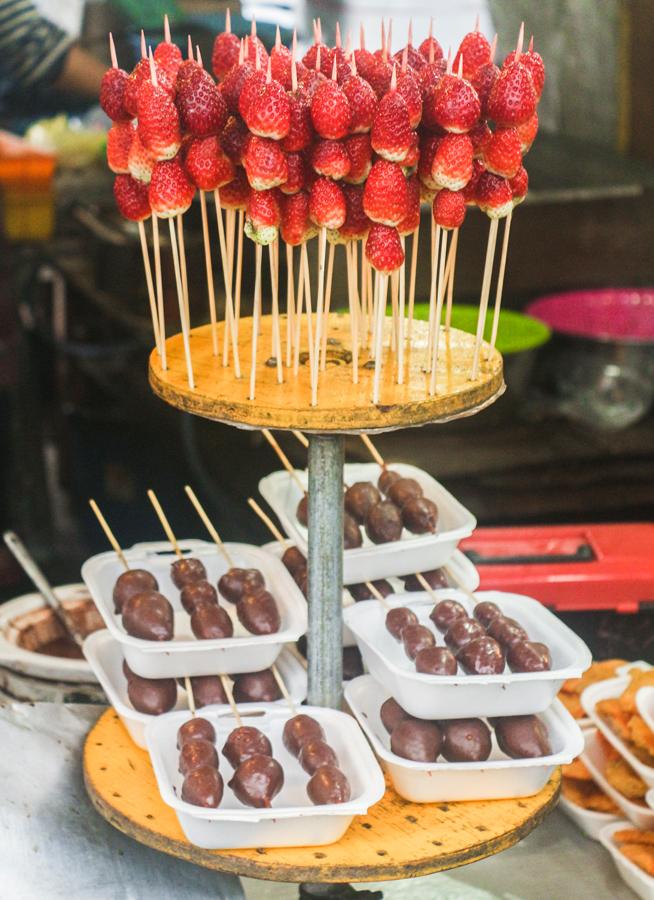
You can also find sea coconut juice (from the palmyra palm tree), apam balik (local pancake packed with corn, nuts and sugar), crepes, boiled peanuts, sweet potatoes, potato balls, battered mushrooms, yams and vegetables, grilled corn on the cob, boxes of exotic fruit teas, and several other such items.

If you’re hungry for a proper meal during your visit to the night market, one of the hawker food stalls will cook you up a really cheap meal for 4-5 RM or so.
There are various noodle dishes (flat rice noodles, fried noodles etc), lobak (radish cake), Styrofoam boxes packed with chicken and rice, packages of nasi lemak (coconut milk-infused rice with chili paste and salted anchovies) satay (kebab meat with peanut chutney) and many other eating options.
You can also buy pre-made meals in Styrofoam boxes packed with white rice, yellow rice and a large piece of chicken.
A few hawker stalls were selling tasty grilled chicken served with rosemary, apricot or strawberry sauce. Other stalls were selling somewhat more exotic roasted or grilled meats like lamb, deer and quail.
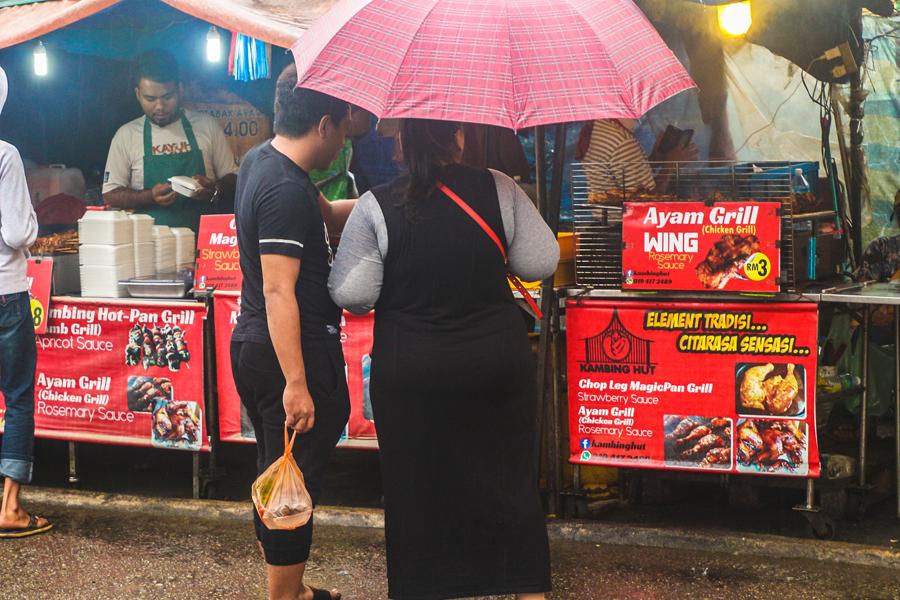
By the way, if you see any fruits being sold at the market that look like luridly green or red apples, these are not apples at all. This is actually a common scam that many tourists fall prey to when they visit the Cameron highlands.
These apple lookalikes are actually ordinary guavas that have been treated with colouring agents such as brilliant blue and tartrazine (light green colour) or carmoisine (red colour).
The vendors then pass these fruits off to tourists at 10RM a pair, claiming them to be some kind of guava-apple hybrid, when no such hybrid fruit even exists!
Many tourists get disappointed when the fruits go bad sooner than expected and the colouring agents that are used are known to possibly cause harmful side effects such as poor concentration, temper tantrums, hyperactivity and allergic reactions. You can learn more about this scam here.
6. Book an organized tour
There are a wide variety of half-day, full-day and even night tours offered by various operators in the Cameron highlands.
While we don’t usually recommend organized tours due to our preference for low-cost, independent travel, the problem is that without having your own vehicle, you will have a bit of an issue in getting around efficiently to all the widely dispersed attractions in the region.
So if you’re tight for time, an organized tour will allow you to “knock-off” all the major attractions in the region in a short space of time, although of course, the quality and depth of the experiences will be greatly reduced. You’ll generally be ferried around to all the attractions in a 4 x 4 or a minivan.
Booking a tour is as simple as walking along the main street in Tanah Rata and finding out what kinds of tours and packages all the different the operators are offering. There are a number of them spread out along the main street.
Many full-day tours will include a visit to a tea plantation, mossy forest, waterfall, Buddhist temple, Orang Asli village, various farms (butterfly, strawberry, bee, vegetable etc.). Blowpipe hunting demonstrations may be given at the Orang Asli villages.
Some of these tours also include a trek into the jungle to see the Rafflesia flower if it’s in bloom although many operators have stopped offering this tour because the flowers have become so scarce.
Several tour operators also organize night jungle walks, where you can spot many interesting creatures like stick insects (Phasmatodea sp.), three-horned rhinoceros beetles (Chalcosoma caucasus) and snakes. Most of the creatures seen on the night walks are also found at the butterfly farm, but it’s obviously a lot better to see them in their natural context.
Prices for the day tours can vary between 25RM for a half-day tour to around 100RM for a full-day tour.
7. Amble through the enchanting "mossy forest"
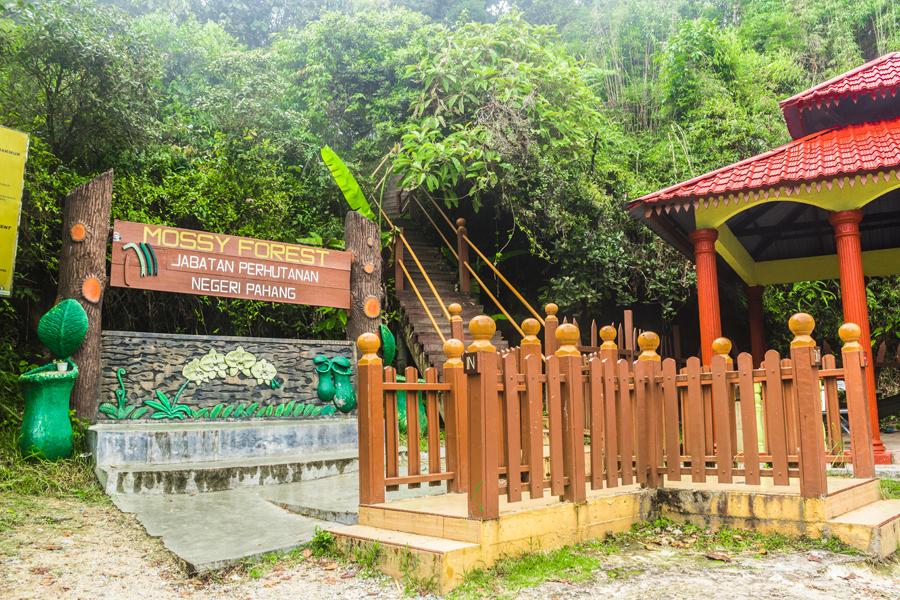
The “mossy forest” is one of the most popular tourist attractions in the Cameron Highlands and indeed is one of the only reasons that some people visit the region.
Here we’re specifically referring to the purpose-built tourist attraction, where a raised boardwalk has been built to take tourists on a supposedly enchanting journey through a grove of naturally occurring cloud forest habitat at almost 2,000 m elevation.
Directions: The mossy forest is found about one kilometre down the road from the summit of Gunung Brinchang.
If coming by road, you can get there by following route 432 into the Sungai Palas tea garden for about 2 km and then taking the left turn at the junction instead of continuing on to the visitor centre. From the junction it’s another 4 km or so to the mossy forest.
A more stylish way to get to the mossy forest is to hike jungle trail no.1 up to the summit of Gunung Brinchang and then walk 750 metres down the road from the summit to the mossy forest. This is what we did and it worked out quite well.
The attraction is free with no entrance fee.
We must admit that we weren’t particularly impressed with this tourist attraction. That’s probably because we had already stumbled upon an almost identical and far more authentic tract of mossy forest during our return hike from the summit of Gunung Berembun.
The mossy forest that we experienced that day felt more enchanting and more evocative of a fairytale, with gnarled, twisted old trees and thick, vivid green strands of moss hanging from all the tree branches and carpeting the forest floor.
The tourist attraction on the other hand consists of a raised boardwalk that meanders through a patch of cloud forest that doesn’t feel particularly magical or special.
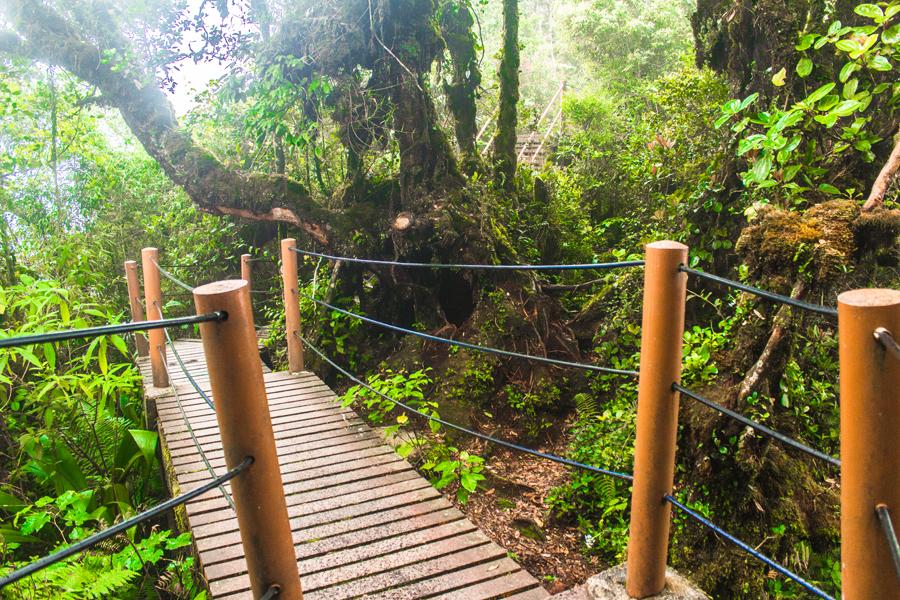
Perhaps it’s the presence of the boardwalk, which has diluted the forest’s bewitching charm and tamed its wildness. You feel rather disconnected merely observing the forest from the boardwalk, as if it's just wallpaper that you can observe all you want, but can’t interact with.
Moreover, despite our best efforts, we couldn’t spot any particularly interesting or unusual orchids, ferns or pitcher plants in the forest so it turned out to be a disappointment. Many other travellers have reported a similarly disappointing experience.
At one point along the walk we came to a gate marking the beginning of the trail leading to Gunung Irau (2,110 m), which is the highest peak in the Cameron Highlands. The gate was closed, but just to point out that this is where the start of the trailhead is found.
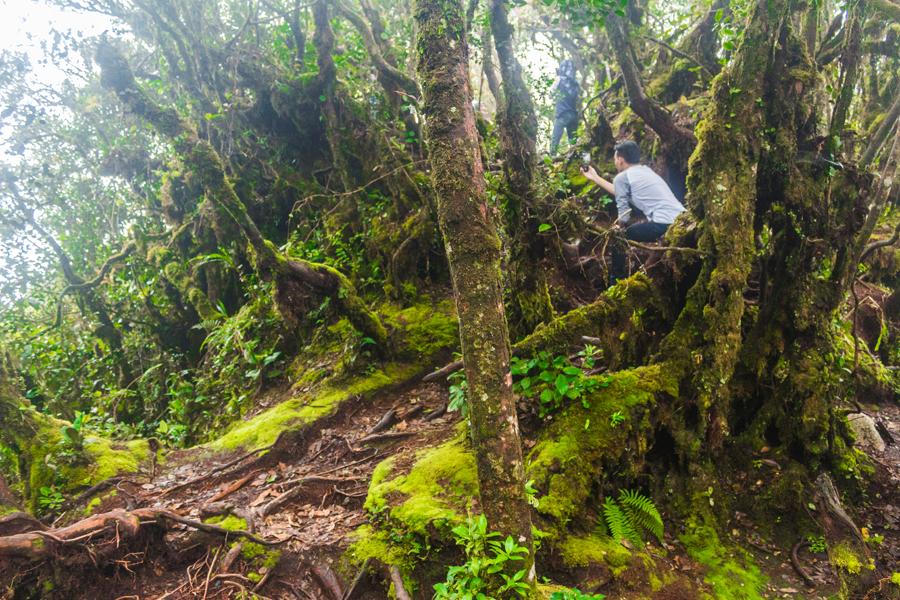
In spite of our disappointing experience at the mossy forest tourist attraction, the most exciting experience of our trip was to come shortly after we had exited the boardwalk and had begun walking back up the road towards Gunung Brinchang.
We noticed that the mossy forest habitat continued right alongside the main road that we were walking along and there were several openings in the dense thicket that were very alluring, silently beckoning us to enter the forest.
Unable to resist the urge to know what was inside this mysterious forest, we spontaneously decided to cross the threshold and immerse ourselves in this new world of the unknown.
Stepping inside the gloomy, fog-choked forest, we gasped as we found ourselves inside a fairytale wonderland with vivid, luxuriant green moss everywhere, hanging from tree branches, carpeting the forest floor, clinging to the tree trunks and covering the exposed roots.
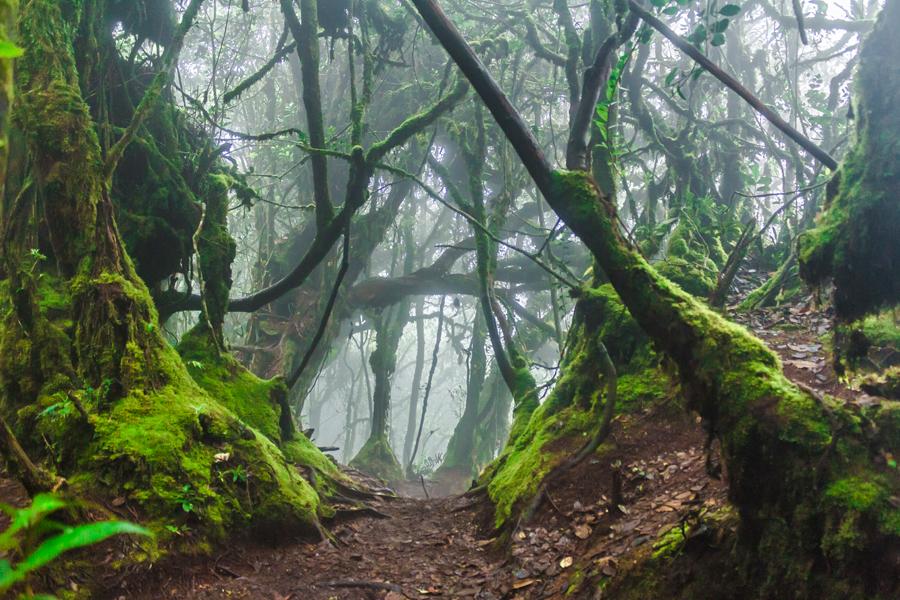
If the experience wasn’t already delightful enough, we then spontaneously stumbled upon an entire community of pitcher plants.
First we spotted just one specimen, but then, in accordance with the Baader-Meinhof phenomenon, we suddenly started to see the plants everywhere, with each individual nestled up against a mossy tree trunk or suspended in mid-air at the end of a long wiry stalk.
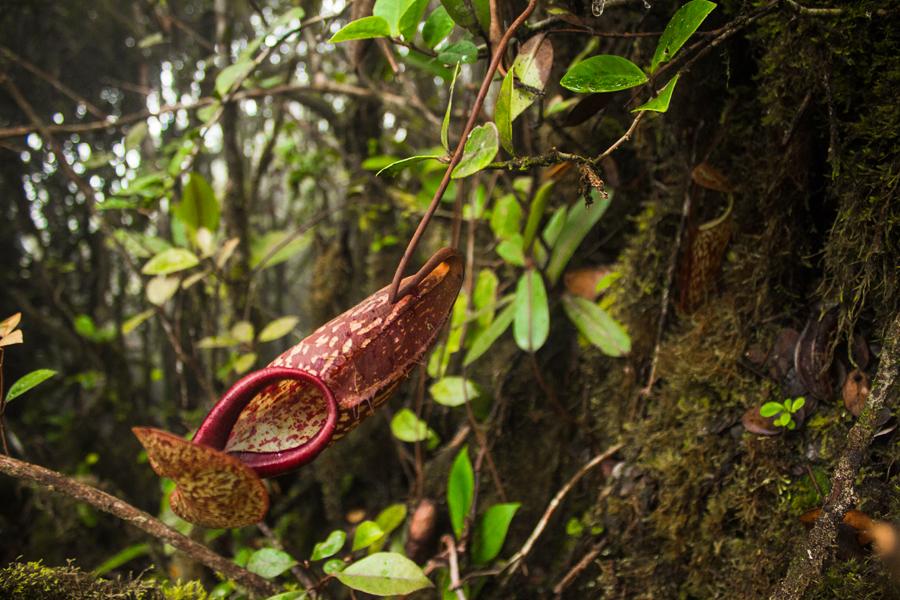
The excitement of finding a plant that is so beautiful, unique, rare (and deadly) cannot be put into words. Indeed, only a few lucky people will ever get the opportunity to observe these carnivorous, flesh-eating plants in the wild during their lifetime. We felt like we had happened upon some kind of forbidden botanical treasure trove deep in the forest.
We took as many photographs of the pitcher plants as possible, which we figured was the most ecologically responsible way for us to take some of the loot home with us. Pitcher plants like these are threatened by collectors and also hikers who take the pitchers home as souvenirs.
There are many species of pitcher plants (Nepenthes sp.) in the Cameron highlands but the one that that we stumbled upon, if it is not a hybrid, is likely to be Nepenthes macfarlanei, a species that’s endemic to peninsular Malaysia.
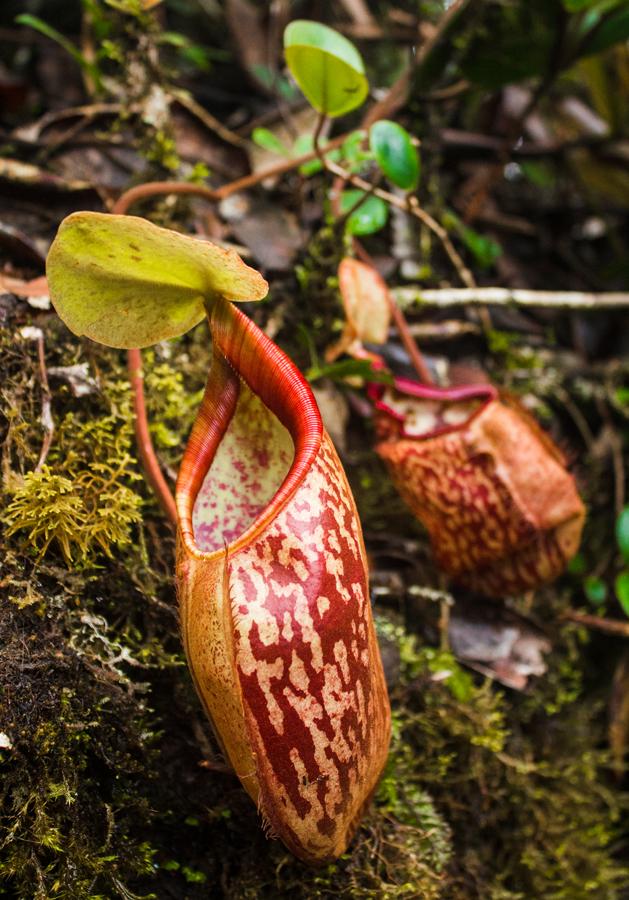
The species is named after the Scottish botanist John Muirhead Macfarlane and it grows as a vine, spiralling itself around the trunks of the existing trees in the forest.
The red-speckled pitchers are attached to the end of a long wiry stalk, which actually grows from the tip of one of the plant’s ordinary leaves!
The pitcher itself is formed when the growing tip of this long stalk inflates and blows up like a balloon, forming the pitcher. The main purpose of the lid (operculum) is to protect the pitcher from the rain so that the digestive juices inside don't get too diluted.
.jpg)
Most of the pitchers (also known as pitfall traps) that we saw were partially filled with digestive fluid, perhaps diluted with a little rainwater. They lure in flies, ants and other insects with secretions of nectar and with their vibrant colours.
The inclined, grooved rims (peristome) of the pitchers are anti-adhesive and especially slippery when moistened with nectar secretions or condensation. Unsuspecting insects seeking the nectar reward lose their footing on the slick surface, sliding helplessly into the soup beneath.
Once inside the trap, climbing back out is almost impossible. The waxy inner surface of the pitcher and the dozens of downward-pointing teeth at the base of the rim, both help to prevent escape.
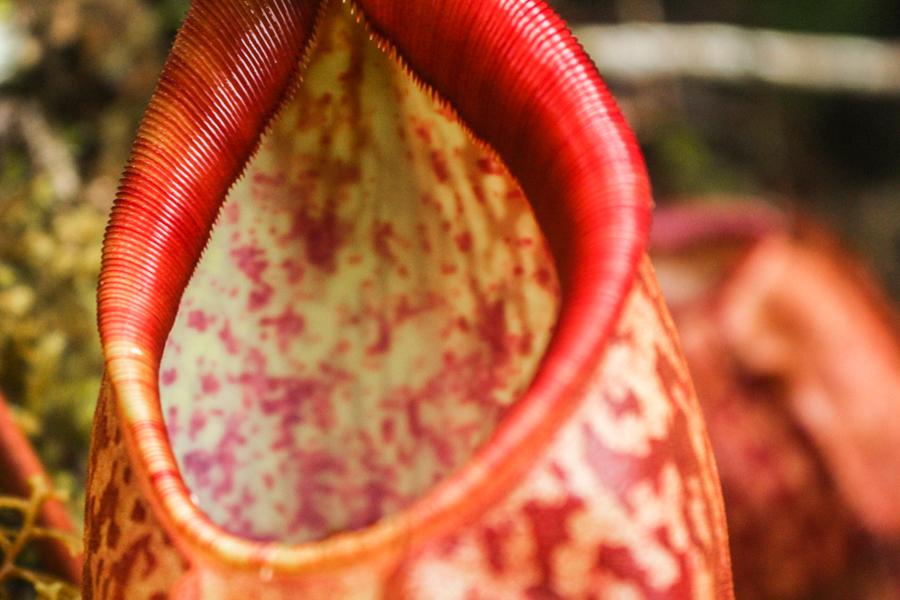
The insect will soon drown in the deadly soup inside the pitcher and will be fully digested by a host of different enzymes, converting the insect into useful nutrients for the plant.
Nitrogen and phosphorus are the nutrients that the plant needs most, since these are difficult to obtain in the acidic or nutrient-poor soils where pitcher plants normally occur.
Pitcher plants are a fascinating family and there are over 100 species in the Nepenthes genus alone. Many of these have highly specialized mechanisms for capturing their animal prey and some form symbiotic relationships with small rodents, trading nectar in exchange for the mammal’s faeces, which provides the plant with nitrogen.
A species in Borneo known as Nepenthes rajah, which is the largest of the pitcher plants, has even been known to drown and consume bigger animals like rats, frogs, lizards and birds. However, it appears that the plant is not expressly targeting these bigger animals and that they occasionally just fall in while trying to get the nectar.
Did you know also that bats sleep inside tropical pitcher plants, using them like a hotel? These are no freeloading bats either. They pay their way. Here’s a fascinating article where you can learn more about all these different kinds of pitcher plants.
8. Other things to do and see
The attractions we've discussed already are probably more than enough to keep you busy but for the sake of completion, we want to mention two other popular attractions that some of you may enjoy.
Lata Iskandar waterfall
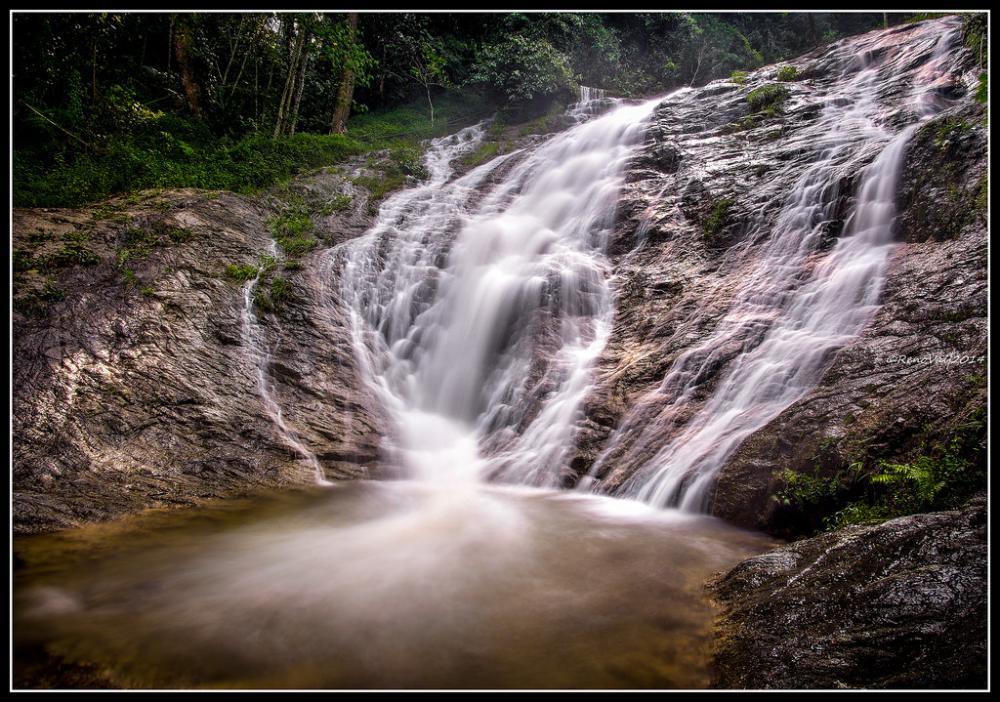
This waterfall is found next to the main road about 35km south of Tanah Rata and 22.6 km south of Ringlet. It was too out of the way for us to justify a visit but if you’re driving into the highlands via the Tapah exit, you could always make a brief stop on the way in.
It’s more of a multi-tiered waterslide than a water “fall” but nonetheless it’s a pleasant spot for a picnic or a swim. There are pools of cool mountain water at the base of each waterslide, which are perfect for bathing in.
It's best to avoid the place at the weekend as it tends to be overrun with locals and domestic tourists occupying all the swimming holes and vying for selfies on the rocky ledges of the waterfall.
Along the main road facing the falls, there’s a handicraft bazaar where you can find interesting local crafts and ethnic souvenirs produced by the Orang Asli. Medicinal herbs and aphrodisiacs from the forest may also be found. Other stalls provide refreshments such as snacks and drinks.
Time tunnel museum
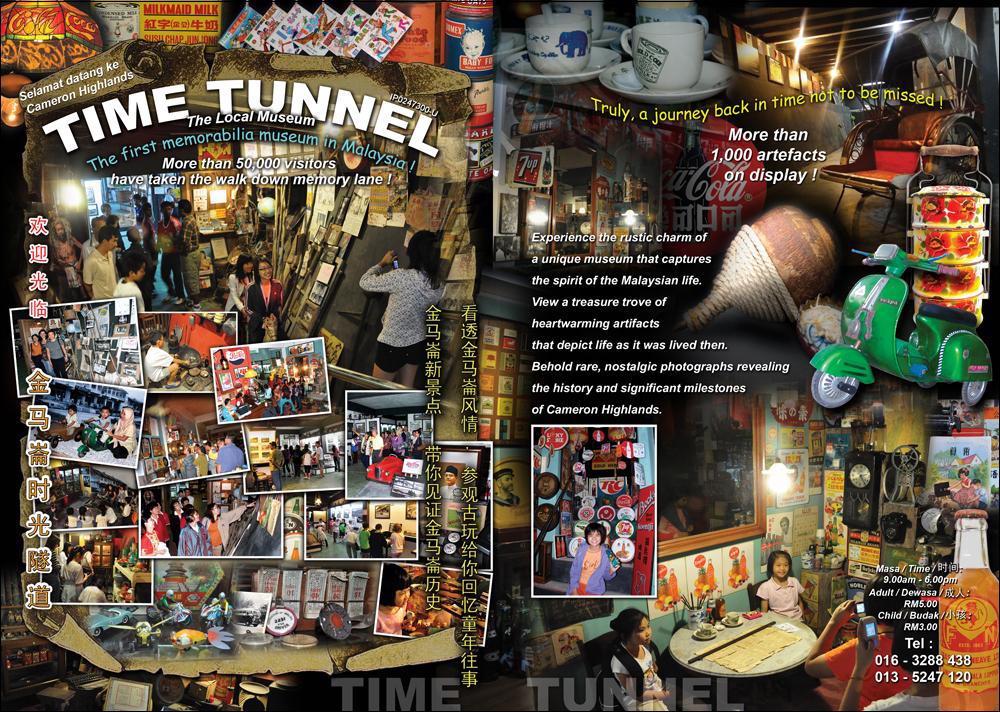
Opened in February 2007 as Malaysia's first memorabilia museum, the Time Tunnel museum is located just next to the main road, about 2 km northeast of Brinchang and is the brainchild of a local collector named See Kok Chan. The museum is situated in the basement of the Kok Lim Strawberry farm. Entrance fee is 5RM for adults.
Spread across two separate floors, the museum is dedicated to preserving the cultural heritage and historical artifacts of the Cameron Highlands. It takes you on a nostalgic walk down memory lane, transporting you back in time to the 50’s and 60’s with all of its collectibles and memorabilia on display.
The eight galleries include an aborigine section, a photography gallery, a coffee shop, a barber’s shop, a children’s corner, a kitchen area and a Jim Thompson. There are literally thousands of objects on display here so you should be able to find at least a few things of interest.
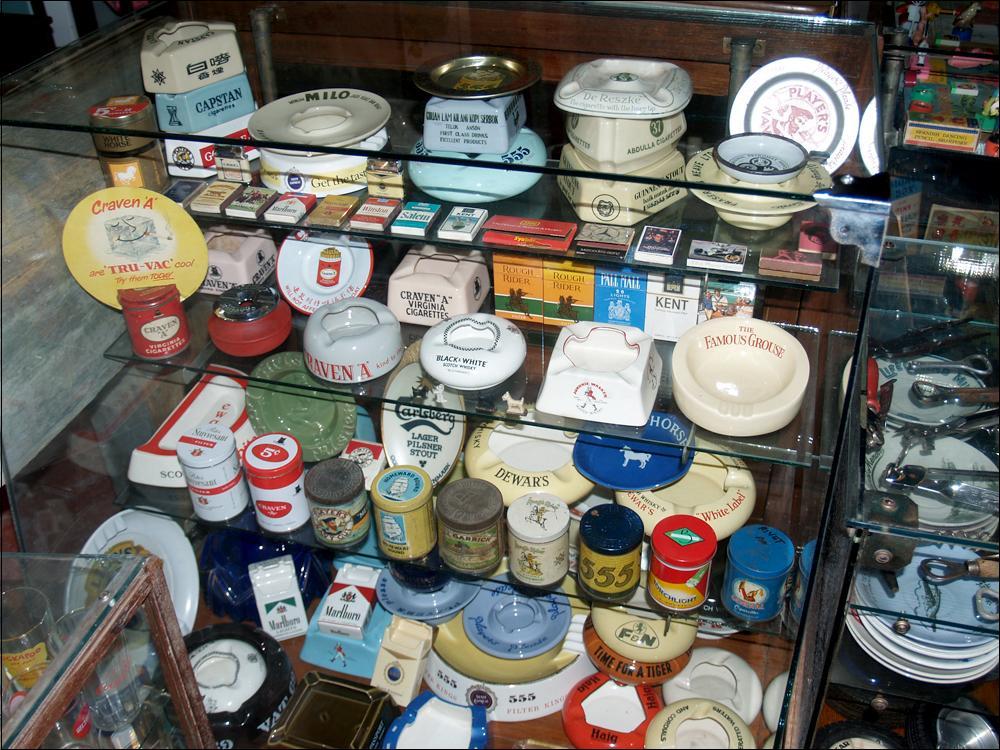
A final word
In any tropical country where steamy jungles and oppressive seem to always be the baseline, it's always a real treat to be able to hop on a bus and soon find yourself in a completely different environment with a much more favourable climate and a whole new ecosystem that can even help to cure homesickness for many long-term travellers.
If you're the sort of person that enjoys the cooler weather of temperate climate zones, doesn't mind a bit of rain, enjoys taking walks in pristine forests, delights in discovering new exotic species, has an interest in agriculture, lives for stunning mountain vistas, loves great Indian food and can't resist a great cup of tea with strawberry-and-cream scones, then we think that you'll love the Cameron Highlands.
If you enjoyed this article or found it useful, please share it with other travellers. If you have ever been to the Cameron Highlands before do tell us, how was your experience and what did you like or hate the most about this part of Malaysia? We'd love to hear your feedback.
JOIN OUR LIST
SUPPORT US
FOLLOW US
ABOUT US
Our names are Eoghan and Jili and we hail from Ireland and India respectively.
We are two ardent shoestring budget adventure travellers and have been travelling throughout Asia continuously for the past few years.
Having accrued such a wealth of stories and knowledge from our extraordinary and transformative journey, our mission is now to share everything we've experienced and all of the lessons we've learned with our readers.
Do make sure to subscribe above in order to receive our free e-mail updates and exclusive travel tips & hints. If you would like to learn more about our story, philosophy and mission, please visit our about page.
Never stop travelling!
FOLLOW US ON FACEBOOK
FOLLOW US ON PINTEREST
-lw-scaled.png.png)

